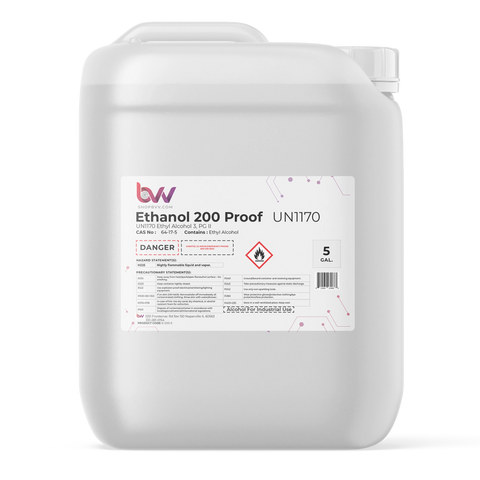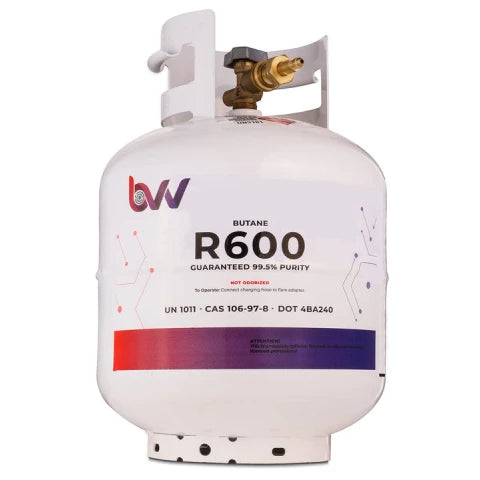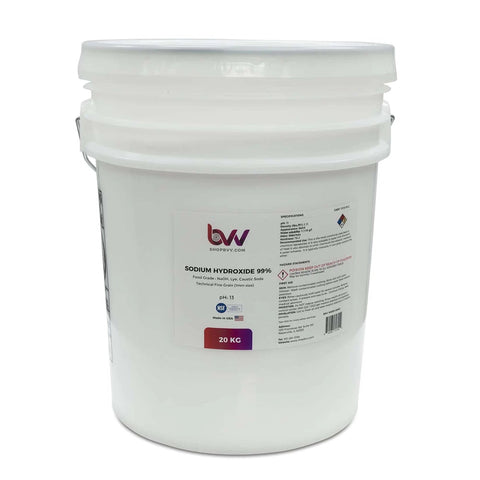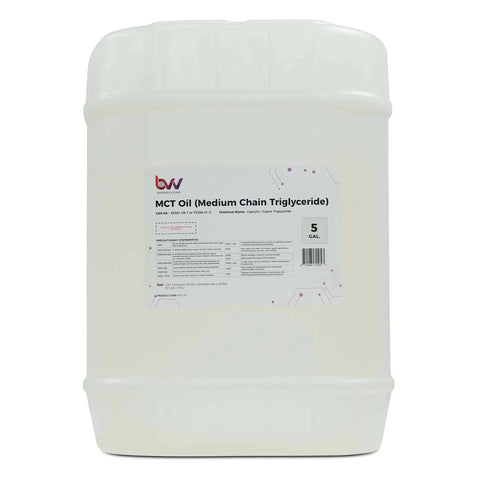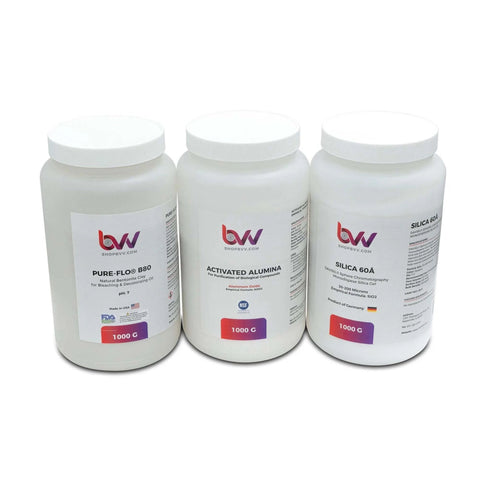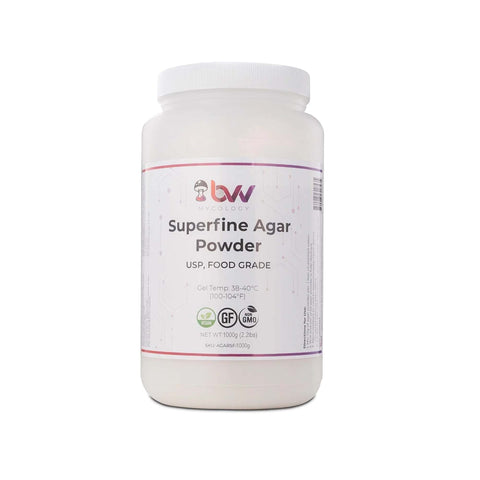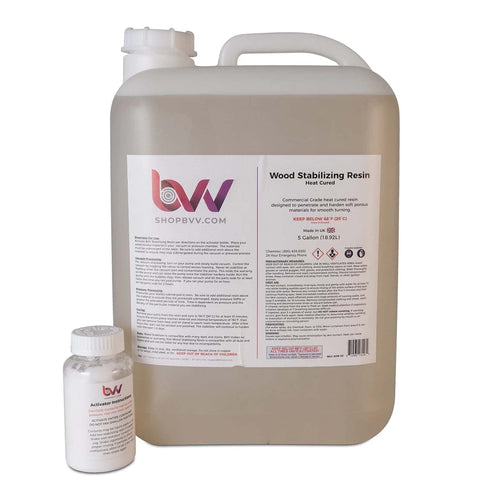Shop Consumables
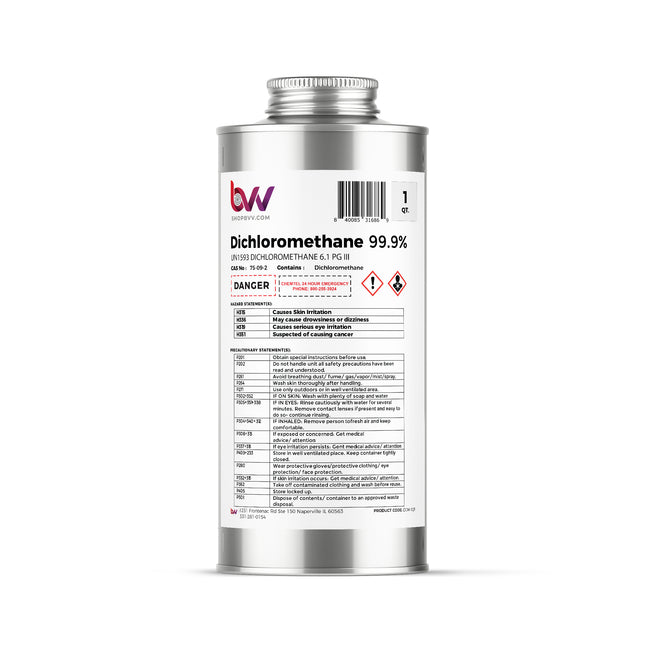
Dichloromethane Lab Grade 99.9%
Dichloromethane (DCM) Lab Grade Tested 99.99% Purity (Aka. Methylene Chloride) Dichloromethane is an organochloride that appears as a colorless volatile liquid having sweet chloroform-like odor. This liquid is widely used as a solvent. Although it is not miscible with water, it is polar, and miscible with most organic solvents. Commonly used for partitioning alkaloids from aqueous solutions Dichloromethane or DCM for short is commonly used as an extraction solvent across the food & beverage industry and is well known for its use in the decaffeination of coffee. With a density of 1.33g/cm3 it is denser than water partitioning as the bottom layer during liquid-liquid extraction. With a low boiling point of 39.8C/103.3F Dicholormethane allows for fast drying and the preservation of temperature-sensitive compounds. While Dichloromethane is highly volatile it is actually neither flammable nor explosive in air. Produced through the chlorination of methane along with chloromethane, trichloromethane (chloroform), and tetrachloromethane (carbon tetrachloride, Dichloromethane is the least toxic of the three. While Dichloromethane is less toxic than other chlorinated hydrocarbons it is still known to cause skin and serious eye irritation and may cause drowsiness or dizziness and potentially cancer. During handling always wear appropriate personal protective equipment in the form of tightly fitting safety goggles or face shield, long-sleeved clothing, and an approved respirator if exposure limits are exceeded or if irritation or other symptoms are experienced. Always ensure DCM is handled under adequate ventilation using a chemical fume hood. Avoid getting DCM into the eyes, on skin, or on clothing, and avoid ingestion and inhalation. Dichloromethane should always be stored in a dry, cool, and well-ventilated place with the container tightly closed. Dichloromethane Technical Data Sheet Dichloromethane Safety Data Sheet Chemical Formula: CH2Cl2 Molecular Weight: 84.93 g·mol−1 CAS Registry Number: 75-09-2 Appearance Colorless Liquid Odor: Faint, Chloroform-like Density 1.3266 g/cm3 (20 °C) Boiling Point: 39.6 °C / 103.3 °F Solubility in water: 17.5 g/L (25 °C) GHS Pictograms: GHS Signal Word: Warning GHS Hazard Statements: H315, H319, H335, H336, H351, H373 GHS Precautionary Statements P261, P281, P305+P351+P338 UN Identification Number: 1593 Proper Shipping Name: Dichloromethane Transport Hazard Class: 6.1 Packing Group: III DOT Placard: What Is Dichloromethane? Dichloromethane, also known as methylene chloride, is a colorless, volatile, and sweet-smelling organic compound with the chemical formula CH2Cl2. It is a halogenated hydrocarbon and is commonly used as a solvent in various industrial and laboratory applications. What is Dichloromethane Used for? Dichloromethane, also known as methylene chloride, is a versatile organic compound with several common uses, including: Solvent: It is widely used as a solvent in various industrial and laboratory applications. Dichloromethane's ability to dissolve a wide range of organic compounds makes it valuable in chemical processes and as a cleaning agent. Extraction: It is used in some extraction processes, such as the decaffeination of coffee and tea. It can selectively dissolve caffeine from coffee beans or tea leaves, leaving behind other flavor compounds. Chemical Reactions: It is used in chemical reactions as a solvent and as a reagent in various synthetic procedures. Pharmaceuticals: In the pharmaceutical industry, dichloromethane can be used for various purposes, including as a solvent for drug formulation. Aerosol Propellant: It has been used as a propellant in aerosol products like paints and coatings. Foaming Agent: In the production of polystyrene foam, dichloromethane can be used as a foaming agent. Lab Applications: In laboratory settings, it is used as a solvent for analytical methods, especially in chromatography. What are the Properties of Dichloromethane? Dichloromethane, also known as methylene chloride, is a colorless, volatile liquid with several notable properties: Physical State: At room temperature (around 25 degrees Celsius or 77 degrees Fahrenheit), dichloromethane exists as a volatile liquid. It has a sweet, ether-like odor. Density: The density of dichloromethane is approximately 1.33 grams per milliliter (g/mL), making it denser than water. Solubility: Dichloromethane is highly miscible with a wide range of organic solvents, including ethers, alcohols, and chlorinated compounds. It exhibits limited solubility in water, forming an azeotrope with a maximum water concentration of around 12.5%. Boiling Point: It has a relatively low boiling point of approximately 39.6 degrees Celsius (103.3 degrees Fahrenheit), which makes it volatile and easy to evaporate. Reactivity: It is relatively chemically stable under normal conditions. However, dichloromethane can react with strong bases, such as sodium hydroxide, producing potentially hazardous compounds. Flammability: Dichloromethane is not highly flammable but can burn under certain conditions, particularly if it forms a vapor-air mixture within its flammable range. Toxicity: It is considered a hazardous chemical due to its potential health risks. Inhalation of dichloromethane vapors can lead to dizziness, headaches, nausea, and, in high concentrations, more severe health effects. Prolonged exposure can be harmful. Environmental Impact: Dichloromethane is known to be an ozone-depleting substance and can contribute to stratospheric ozone depletion. Consequently, its production and use are regulated or restricted in many countries under environmental laws. Industrial Use: Despite its potential hazards, dichloromethane is used in various industrial applications, such as paint stripping, as a solvent, and in the production of some chemicals and pharmaceuticals. What Are The Hazards Of Dichloromethane? Dichloromethane (DCM), also known as methylene chloride, is a volatile organic compound that poses several hazards to human health and the environment. It's important to handle DCM with care and follow safety precautions when working with this chemical. Here are some of the main hazards associated with dichloromethane: Inhalation Hazard: DCM is a volatile chemical, and its vapors can easily be inhaled. Short-term exposure to high concentrations of DCM vapor can lead to symptoms such as dizziness, headache, nausea, and in severe cases, loss of consciousness or death. Prolonged or repeated exposure to lower concentrations may cause respiratory irritation, coughing, and chest discomfort. CNS Depression: Dichloromethane can affect the central nervous system (CNS) when inhaled or absorbed through the skin. It has mild anesthetic properties and can lead to CNS depression, resulting in impaired coordination and reaction time. Skin and Eye Irritation: DCM can irritate the skin and eyes upon contact. It may cause redness, itching, and dermatitis. Eye contact can lead to irritation, tearing, and blurred vision. Carcinogenicity: Long-term exposure to DCM has been associated with an increased risk of cancer, particularly lung cancer. The International Agency for Research on Cancer (IARC) has classified DCM as a Group 1 carcinogen to humans. Environmental Impact: DCM is an ozone-depleting substance and can contribute to the depletion of the ozone layer when released into the atmosphere. It is also harmful to aquatic life, and its disposal into water bodies can have adverse effects on the environment. Flammability: While DCM itself is not highly flammable, its vapors can form flammable mixtures with air. It is important to take precautions to prevent the buildup of flammable vapor concentrations in enclosed spaces. Chemical Reactivity: DCM can react with certain chemicals, and its contact with strong oxidizers or alkalis can result in hazardous reactions. It should be stored and handled away from incompatible substances. To minimize the hazards associated with dichloromethane, it is essential to work with this chemical in a well-ventilated area, wear appropriate personal protective equipment (PPE), including gloves and eye protection, and follow safety guidelines and regulations. Use DCM in a chemical fume hood or a well-ventilated area to reduce inhalation exposure. Proper storage, handling, and disposal procedures should also be followed to protect human health and the environment. Additionally, it is advisable to be aware of local regulations and guidelines related to the use and disposal of DCM. How Do I Use Dichloromethane Safely? Using dichloromethane (DCM), also known as methylene chloride, safely is essential to minimize health and environmental risks associated with this chemical. Here are some guidelines for the safe use of DCM: Personal Protective Equipment (PPE): Wear appropriate PPE, including chemical-resistant gloves, safety goggles or a face shield, and a lab coat or chemical-resistant apron. Consider using a chemical-resistant apron and full-body protective clothing if handling large quantities of DCM. Ventilation: Work in a well-ventilated area, such as a chemical fume hood or a well-ventilated laboratory. Avoid working with DCM in confined spaces without proper ventilation. Respiratory Protection: If working with DCM outside of a fume hood or in a space with inadequate ventilation, use a NIOSH-approved organic vapor respirator to protect against inhalation exposure. Ensure that the respirator is fit-tested and properly maintained. Storage: Store DCM in a cool, well-ventilated area away from direct sunlight, heat, and incompatible materials. Keep containers tightly closed and labeled with hazard information. Handling: Use DCM only for its intended purposes and avoid unnecessary exposure. Handle DCM with care to prevent spills or splashes. Do not eat, drink, or smoke while working with DCM. Avoid Skin and Eye Contact: Wear chemical-resistant gloves to prevent skin contact. Use safety goggles or a face shield to protect your eyes from splashes. In case of skin contact, promptly remove contaminated clothing and wash the affected area thoroughly with soap and water. In case of eye contact, flush the eyes with water for at least 15 minutes and seek immediate medical attention. Work in a Controlled Environment: Perform DCM-related tasks on stable surfaces to prevent accidental spills. Avoid working alone when handling DCM, especially in situations where immediate assistance may be needed in case of an accident. Fire Safety: DCM is not highly flammable but can form flammable vapor-air mixtures. Keep ignition sources away from DCM and store it in a cool area. Ensure that fire extinguishing equipment is readily available and that personnel are trained in its use. Emergency Procedures: Know the location of emergency eyewash stations, safety showers, and spill response kits. Establish and familiarize yourself with emergency procedures in case of spills, fires, or exposure incidents. Disposal: Dispose of DCM waste according to local regulations and guidelines. DCM waste is often considered hazardous and must be handled and disposed of properly. Training: Ensure that personnel handling DCM are adequately trained in its safe use, storage, and disposal. Regulations and Guidelines: Be aware of and comply with local, state, and federal regulations governing the use, handling, and disposal of DCM. Remember that DCM is a volatile chemical, and its vapors can be harmful when inhaled over an extended period. Follow safety data sheet (SDS) instructions, and if you are uncertain about any aspect of using DCM safely, consult with a safety professional or chemical hygiene officer in your organization.
$25.00 - $1,500.00
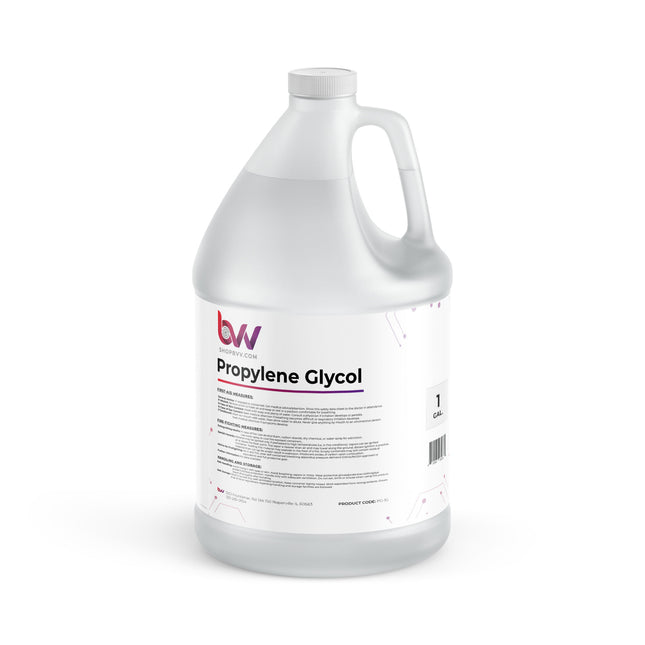
BVV™ Propylene Glycol Tech Grade 100%
BVV™ Propylene Glycol Disclaimer: Spigots/Faucets are only compatible with 5 Gallon Jugs and must be purchased separately BVV™ brand propylene glycol is a great heat transfer fluid alternative to water for all processing equipment such as refrigerated or heated circulators and cold traps. This propylene glycol has a freezing point of -74°F and a boiling point of 370°F. BVV™ propylene glycol is considered NOT genetically modified and NOT derived from a genetically modified organism. BVV™ Propylene Glycol SDS BVV™ Propylene Glycol Specification Sheet The expiration date is 2 years from the date of manufacture and when the glycol is kept below 100F and out of direct sunlight.
$38.00 - $5,750.00
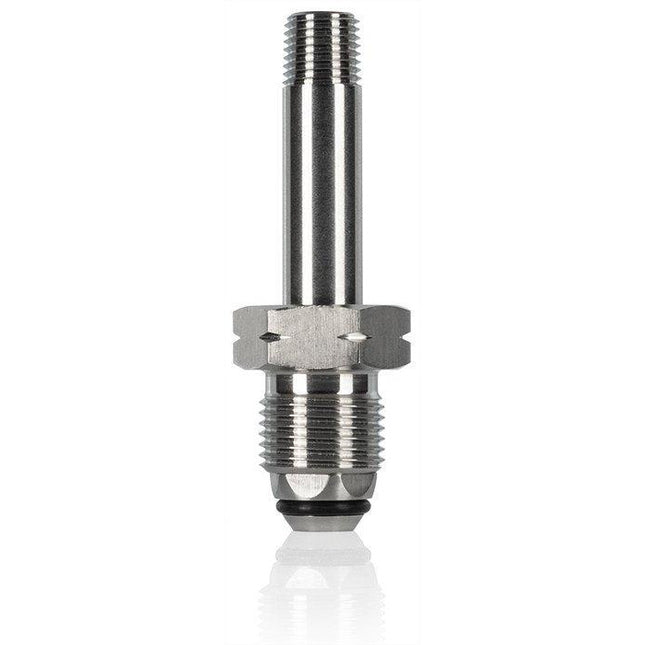
Stainless Steel Butane/Propane Tank Fitting CGA 510
Stainless Steel Butane/Propane Tank Fitting CGA 510 Custom Stainless Steel CGA 510 Butane and Propane Tank Fitting with Viton O-Ring. Specifications: CGA 510 Thread with Viton O-ring seal and either 1/4" MNPT or 1/4", 3/8", 1/2" Flare Material: Stainless Steel
$18.00 - $95.00
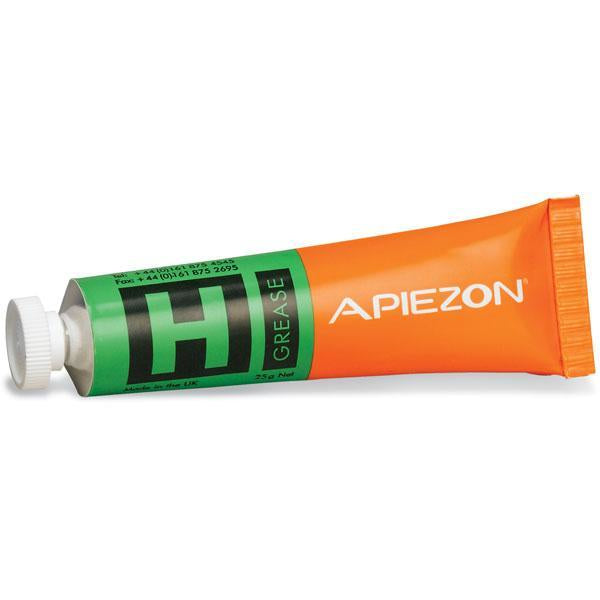
Apiezon H High Temperature Vacuum Grease
Apiezon H High Temperature Vacuum Grease 25g Apiezon H Grease is a silicone-free high vacuum grease perfectly suited for use at high temperatures in both scientific and industrial applications. H Grease has exceptional 'stiction' and thermal conduction properties and has gained prestigious approvals from a variety of international organizations, including BAE Systems, the European Space Agency and NASA. Safety Data Sheet Technical Data Sheet Apiezon H Grease: High Temperature Vacuum Grease Properties Apiezon H Grease is a silicone-free high temperature vacuum grease which: performs well under a wide range of temperatures, from -10 to +240°C, and retains its optimum consistency at temperatures between +10 and +110°C rather than melting, actually becomes stiffer as temperature increases and therefore is not recommended for highly stressed bearings has excellent heat transfer properties conducts heat away from the site of operation, reducing the danger of overheating and damaging heat-sensitive components exhibits good 'stiction' or sticking power has powerful 'gettering' action, meaning it absorbs potentially harmful grease and chemical impurities on metal and glass surfaces is easy to clean and remove as it is soluble in hydrocarbon solvents exhibits a vapor pressure of 1.7 x 10-9 Torr at 20°C Please click the links for typical properties and vapour pressure graphs of Apiezon H Grease. Applications of Apiezon H Grease As a high temperature, low to medium vacuum grease with excellent 'stiction' power and good thermal conduction properties Apiezon H Grease is used for many diverse applications. In particular H Grease is commonly used in scientific and industrial high temperature sealing applications.Thanks to its 'stiction' power Apiezon H Grease is ideal for use with laboratory glassware; it is also favoured by the electronics and space industries where its high thermal conductivity makes it the perfect vacuum grease in situations where heat sink media requires adhesion.Apiezon H grease has been approved by NASA as a material suitable for lubricating the gold-plated threads of small variable capacitors required to operate under high vacuum from -65°C to +125°C to prevent galling.
$205.00
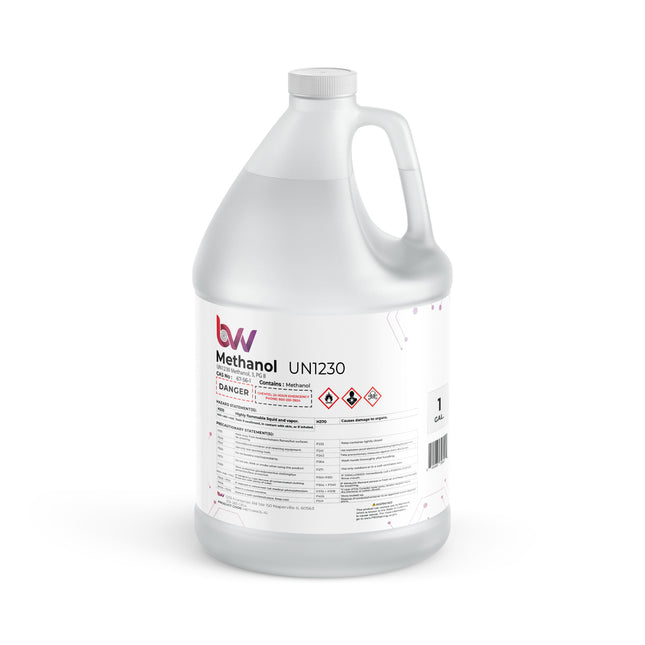
BVV™ High Purity Lab Grade Methanol 99%
BVV™ High Purity Lab Grade Methanol HAZMAT ITEMS ARE NON-REFUNDABLE. ALL SALES ARE FINAL (Note: Container style and color may vary) Spigots/Faucets are only compatible with 5 Gallon Plastic Jugs and must be purchased separately Trigger Sprayer is only compatible with 1QT and 1 Gallon sizes BVV™ High Purity Lab Grade Methanol is used to remove and extract terpenes, tannins, alkaloids, glycosides, lignans, and terpinoids from plants. It is used to extract bio-active, phenolic and polar compounds from medicinal plants. Methanol is a high purity solvent used to manufacture botanical solutions and is easily evaporated. Methanol is used in research and testing laboratories for phytochemical study, phytochemical analysis and chemical synthesis. Methanol is used to prepare methanol/water/acetic acid mixtures. BVV™ Methanol SDS BVV™ Methanol COA Chemical Formula: CH3OH Molecular Weight: 32.042 g·mol−1 CAS Registry Number: 67-56-1 Appearance Colorless Liquid Odor: Faint and similar to ethanol Density 0.792 g/cm3 Boiling Point: 64.7 °C /148.5 °F Solubility in water: miscible GHS Pictograms: GHS Signal Word: Danger GHS Hazard Statements: H225, H301, H302, H305, H311, H331, H370 GHS Precautionary Statements P210, P233, P235, P240, P241, P242, P243, P260, P264, P270, P271, P280, P301+P330+P331, P302+P352, P303+P361+P353, P304+P340, P305+P351+P338, P307+P311, P310, P311, P312, P337+P313, P361, P363, P370+P378, P403+P233, P405, P501 UN Identification Number: 1230 Proper Shipping Name: Methanol Transport Hazard Class: 3 Packing Group: II DOT Placard: What Is Methanol? Methanol, also known as methyl alcohol or wood alcohol, is a type of alcohol with the chemical formula CH3OH. It is the simplest alcohol, consisting of a methyl group (CH3) linked to a hydroxyl group (OH). Methanol is a colorless, flammable liquid with a slightly sweet odor. It is commonly used as an industrial solvent, antifreeze, fuel, and as a feedstock in the production of chemicals, plastics, and synthetic materials. Methanol can be synthesized from various sources, including natural gas, carbon monoxide, and biomass. It is considered a hazardous substance due to its toxicity when ingested, inhaled, or absorbed through the skin. Methanol is also used as an industrial and laboratory solvent and as a fuel in some types of racing cars and model engines. One important thing to note is that methanol is highly toxic when consumed, and even small amounts can be lethal. It should never be ingested, and safety precautions should be taken when handling this substance. What Is Methanol Used For? Methanol is used for a wide range of industrial, commercial, and laboratory applications. Some of its common uses include: Fuel: Methanol is used as an alternative fuel in some types of vehicles, particularly racing cars and model engines. It is also used in the production of biodiesel and as a fuel additive. Solvent: Methanol is a versatile solvent that can dissolve a variety of substances, making it useful in industries such as paint, varnish, and ink production. It is also used as a cleaning agent in laboratories and industrial settings. Antifreeze: Methanol is an essential component of some antifreeze formulations, where it helps prevent the freezing of engine coolant in cold temperatures. Chemical Intermediate: Methanol serves as a key building block in the production of various chemicals and materials, including formaldehyde, acetic acid, methyl methacrylate (used in plastics and coatings), and more. Fuel Cell Feedstock: Methanol can be used as a feedstock for the production of hydrogen, which can be used in fuel cells for electricity generation and other applications. Preservative: In the pharmaceutical and personal care industries, methanol is used as a preservative in some products. Denaturant: Methanol is added to industrial ethanol to make it unfit for consumption (denatured). This ensures that the ethanol cannot be used for drinking purposes and is used for industrial applications. Laboratory Reagent: Methanol is commonly used in laboratories as a reagent and solvent for various chemical experiments and analyses. Extraction: It is used in some extraction processes, such as the extraction of essential oils from plants. Energy Storage: Methanol is being explored as a potential energy carrier for energy storage and transportation, particularly in the form of methanol fuel cells. It's important to note that methanol is toxic to humans and should be handled with care. Ingesting or inhaling methanol vapors can be extremely dangerous and potentially fatal. Proper safety precautions and handling procedures are necessary when working with methanol. What Is The Structure of Methanol? Methanol, also known as methyl alcohol, has a simple chemical structure. Its molecular formula is CH3OH, which represents one carbon (C) atom, four hydrogen (H) atoms, and one oxygen (O) atom bonded together. Here's the structural formula of methanol: In this structure: The central carbon atom (C) is bonded to three hydrogen atoms (H) and one oxygen atom (O). The oxygen atom is bonded to the carbon atom through a single covalent bond (C-O). The remaining three hydrogen atoms are bonded to the carbon atom, completing its four covalent bonds. Methanol is a polar molecule due to the electronegativity difference between oxygen and hydrogen atoms, which results in a partial positive charge on the hydrogen atoms and a partial negative charge on the oxygen atom. This polarity gives methanol its unique chemical properties and makes it a versatile solvent in various applications. What are the Hazards of Methanol? Methanol, while commonly used in various industrial and laboratory applications, poses several hazards, primarily due to its toxic and flammable nature. Here are some of the hazards associated with methanol: Toxicity: Methanol is highly toxic to humans when ingested, inhaled, or absorbed through the skin. The toxic effects are primarily due to its metabolites, formaldehyde, and formic acid. Methanol poisoning can lead to symptoms such as headache, dizziness, nausea, vomiting, abdominal pain, and in severe cases, it can cause blindness, organ failure, and death. Flammability: Methanol is flammable and can form explosive mixtures in the air when its vapor concentration is within certain limits. It has a relatively low flashpoint, making it susceptible to ignition by heat, sparks, or open flames. Proper storage and handling precautions are essential to prevent fire hazards. Irritant: Methanol can be irritating to the eyes, skin, and respiratory tract. Contact with methanol vapor or liquid can lead to skin irritation, redness, and chemical burns. Inhaling methanol vapor can irritate the respiratory system and cause coughing and throat irritation. Environmental Impact: Methanol is harmful to the environment. Spills or releases of methanol can contaminate soil and water, posing a risk to aquatic life and ecosystems. It is important to handle and dispose of methanol responsibly to minimize its environmental impact. Incompatibility: Methanol should not be stored or transported in containers or systems that have previously held incompatible materials, as it can react with some substances and form hazardous compounds. Cumulative Exposure: Prolonged or repeated exposure to methanol vapor or mist over time can result in cumulative health effects, particularly on the central nervous system and the optic nerve. Ingestion Risk: Methanol has a sweet taste and is sometimes mistaken for ethanol (the alcohol found in alcoholic beverages). Accidental ingestion of methanol can occur, especially if it is stored in containers that are not clearly labeled. To safely handle methanol and mitigate these hazards, it is crucial to follow strict safety protocols, use appropriate personal protective equipment (PPE), store methanol in well-ventilated areas away from open flames, and provide proper training to personnel working with methanol. Emergency response plans and first-aid measures for methanol exposure should also be in place in case of accidents or spills. How Do I Use Methanol Safely? Using methanol safely is essential due to its toxic and flammable nature. Whether you're working with methanol in a laboratory, industrial setting, or other applications, here are some guidelines for safe handling: Personal Protective Equipment (PPE): Always wear appropriate PPE, including safety goggles, chemical-resistant gloves, a lab coat or chemical-resistant apron, and closed-toe shoes. Consider additional protective gear, such as a face shield, when handling large quantities or performing high-risk operations. Storage: Store methanol in well-ventilated areas away from heat sources, open flames, and direct sunlight. Use containers made of materials compatible with methanol, such as glass or approved plastic containers. Label containers clearly with the contents. Ensure proper labeling and hazard signage in storage areas. Handling: Handle methanol in a fume hood or well-ventilated workspace to minimize inhalation exposure. Do not use methanol near open flames, sparks, or heat sources. Avoid skin contact; wear gloves and lab coats to prevent skin exposure. Use a face shield or safety goggles to protect your eyes. Spill Response: Have spill kits and absorbent materials (e.g., spill pads, spill pillows) available for immediate use. In the event of a spill, ventilate the area, and contain the spill to prevent it from spreading. Wear appropriate PPE when cleaning up spills. Follow your workplace's spill response procedures and dispose of contaminated materials properly. Storage and Dispensing: Use safety containers designed for methanol when dispensing or transferring the liquid. Never use glassware or containers that have been used for other chemicals without thorough cleaning. Ensure proper grounding and bonding when transferring methanol to prevent static electricity buildup. Inhalation Exposure: Minimize inhalation exposure by working in a well-ventilated area or under a fume hood. If you suspect inhalation exposure, move to an area with fresh air and seek medical attention if symptoms persist. Ingestion Prevention: Do not eat, drink, or smoke in areas where methanol is handled. Avoid using containers or equipment that may be contaminated with methanol for food or beverage storage. Fire Safety: Methanol is flammable; keep it away from open flames, sparks, and heat sources. Use explosion-proof electrical equipment in areas where methanol vapors may be present. Emergency Response: Familiarize yourself with the location of safety showers, eyewash stations, fire extinguishers, and emergency exits. Know the location of first-aid supplies and procedures for methanol exposure. Training and Education: Ensure that personnel handling methanol are properly trained in its safe handling, storage, and emergency response procedures. Waste Disposal: Dispose of methanol waste in accordance with local, state, and federal regulations for hazardous waste disposal. Always follow your workplace's safety protocols and consult with safety officers or supervisors for specific safety procedures related to methanol handling in your environment. Regular safety training and awareness are essential to prevent accidents and protect your health when working with methanol.
$45.00 - $1,600.00
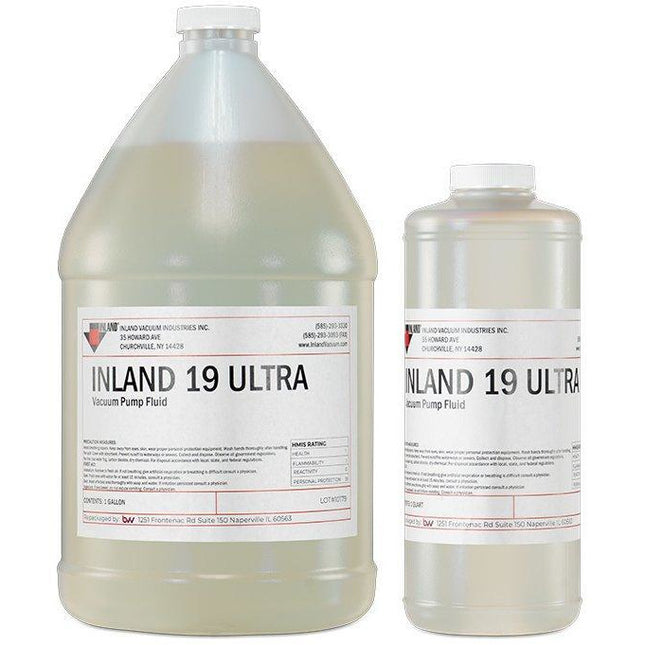
Inland 19 ULTRA® Semi-Synthetic Vacuum Pump Oil
Inland 19 ULTRA® Semi-Synthetic Vacuum Pump Oil Disclaimer: Spigots/Faucets are only compatible with 5 Gallon Jugs and must be purchased separately Inland ULTRA® products are semi-synthetic hydrocarbon fluids designed to endure thermal and chemical stresses much better than standard vacuum pump fluids. The ultra-refined process eliminates nitrogen, sulfur, oxygen, and aromatic hydrocarbons, leaving a clear base stock virtually free of impurities. The additive package will not volatize under thermal stress; the antioxidant will stay in solution and bond up to four times as many radicals as other antioxidants, extending the life of the pump and the fluid. Inland 19 ULTRA® MSDS Properties: Good Thermal Stability Oxidation Resistant Hydrotreated Low Vapor Pressure Long Fluid Life Areas of Application: Mass Spectrometry Electron Microscopy thin Film Sputtering Vacuum Distillation and impregnation UHV Surface Analysis Vacuum Furnaces and Heat Treatment EB Welding Vacuum Tube Evacuation Vacuum Metalization Chemical Pumping Specification Inland 19 ULTRA Vapor Pressure at 25ºC (torr) <1x10-6 Boiling Point at .01 torr (ºC) 166 Viscosity at 40ºC (cSt) 55 Pour Point (ºC) -10 Flash Point (ºC) 247 Fire Point (ºC) Density at 25ºC (g/ml) 0.86 Color clear
$28.00 - $2,125.00
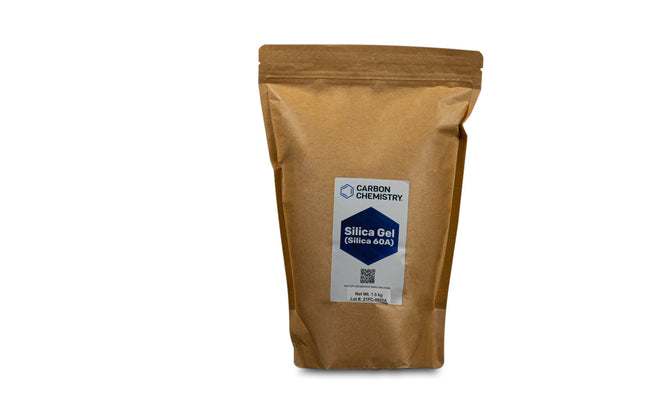
Carbon Chemistry Silica Gel 60A, 200-400 MESH
Carbon Chemistry Silica Gel 60A, 200-400 MESH This powder is used often in Column Chromatography as the stationary phase. It is mixed together with the solvent in the column making a slurry, then letting the solvent drain leaving the Silica sitting evenly in the column. Silica Gel helps space out or separate the fractions of compounds being passed through the stationary phase. Carbon Chemistry Silica Gel 60A, 200-400 MESH - SDS Note: Bulk Bags and Bulk sizes are non-stocked items and will be ordered as needed and carry a several week lead time and require a forklift or pallet jack
$100.00 - $13,000.00
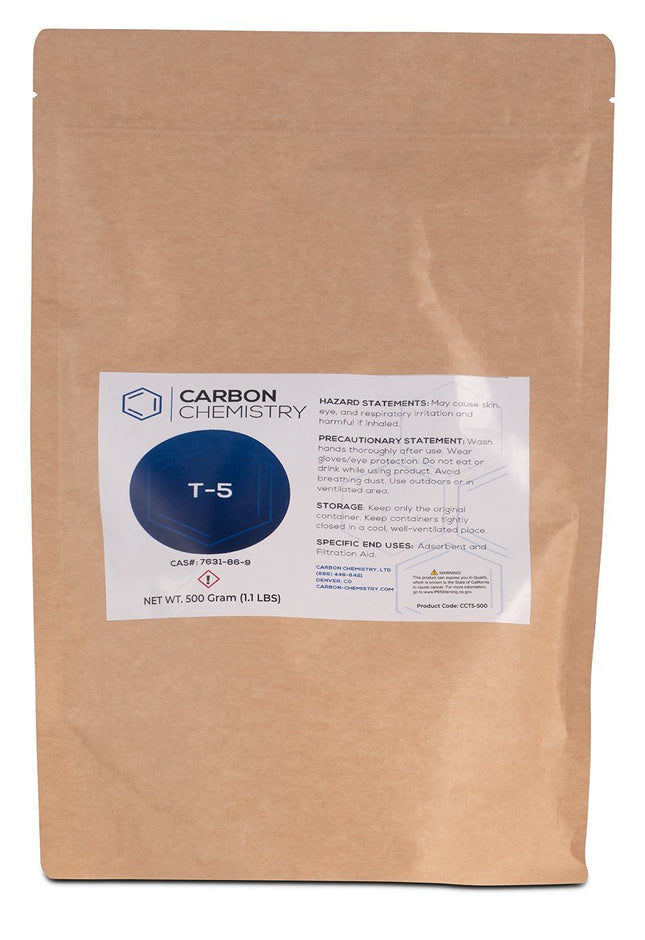
Carbon Chemistry T-5™ Neutral Activated Bentonite Clay
Carbon Chemistry T-5™ Neutral Activated Bentonite Clay T-5™ Neutral Activated Bentonite Clay is an excellent filtration media with a neutral pH. It is designed for fast filtering, with less clogging than you would normally expect. Carbon Chemistry T-5™ Neutral Activated Bentonite Clay - SDS Note: Bulk Bags and Bulk sizes are non-stocked items and will be ordered as needed and carry a several week lead time and require a forklift or pallet jack
$15.00 - $8,600.00
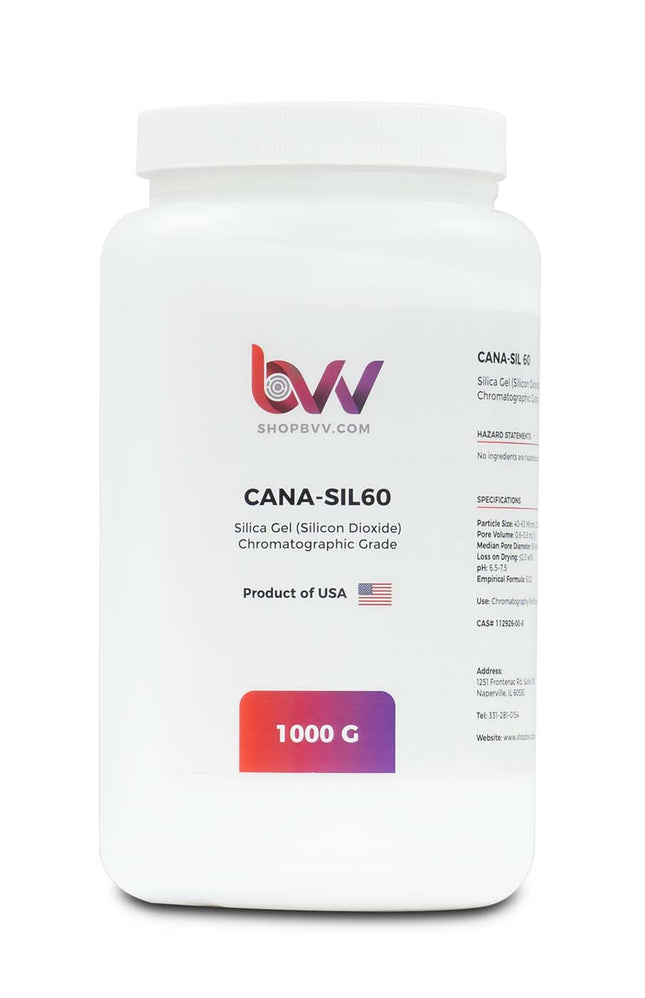
CANA-SIL60™ Silica Gel 60A Chromatographic Grade 40-63 micron (230-400 Mesh)
CANA-SIL60™ Silica Gel Silicon Dioxide 60A Chromatographic, Extraction CRC Grade Cana-Sil™ is an Optimized silica gel for extractions. This powdered silica gel (silicon dioxide) for use in chromatography batch extractions and decolorizations. Cana-Sil60 can also be used as a general adsorbent for impurities. Optimized particle size, surface area, pH, and purity make it a particularly useful material for the separation of small molecules, peptides, lipids, alkaloids, and a variety of other compounds. Silica Gel is particularly useful to use layered on top of your bentonite to remove plant gums and waxes. CANA-SIL60 Technical Data Sheet CANA-SIL60 Safety Data Sheet CANA-SIL60 Certificate of Analysis Key Specs: Particle Size: 40-63 Micron (230-400 Mesh) Pore Volume: 0.6-0.8 mL/g Loss on Drying: ≤ 2.0 wt% pH: 6.5-7.5 Empirical Formula: SiO2 Use: Chromatography Purification Hazard Statement: No ingredients are hazardous according to OSHA criteria CAS# 112926-00-8
$25.00 - $6,990.00
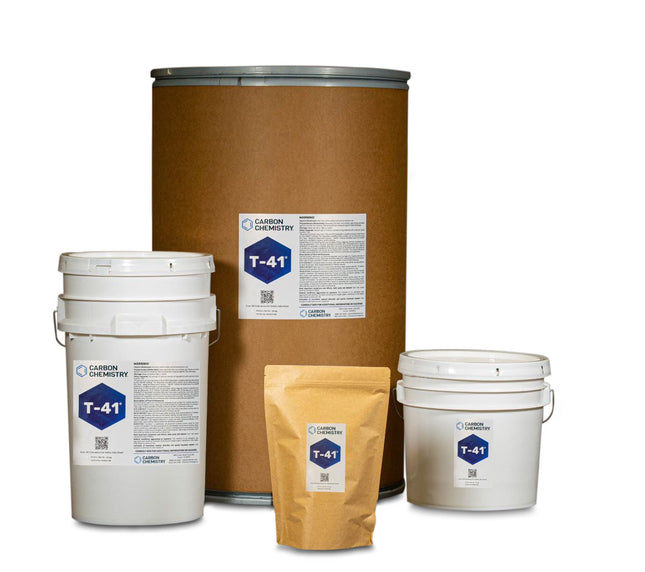
Carbon Chemistry T-41™ Acid Activated Bleaching Clay
Carbon Chemistry T-41™ Acid Activated Bleaching Clay Acid-activated bentonite clay (or activated bleaching clay) is used as an effective filtration media. The clay is rich in carbon, and it has a low pH. This product is most commonly used as a scrub or bleaching clay during oil purification, distillation preparation, pesticide removal, and product improvement including odor removal and visual improvement. Carbon Chemistry T-41™ Acid Activated Bleaching Clay - SDS
$125.00 - $4,200.00
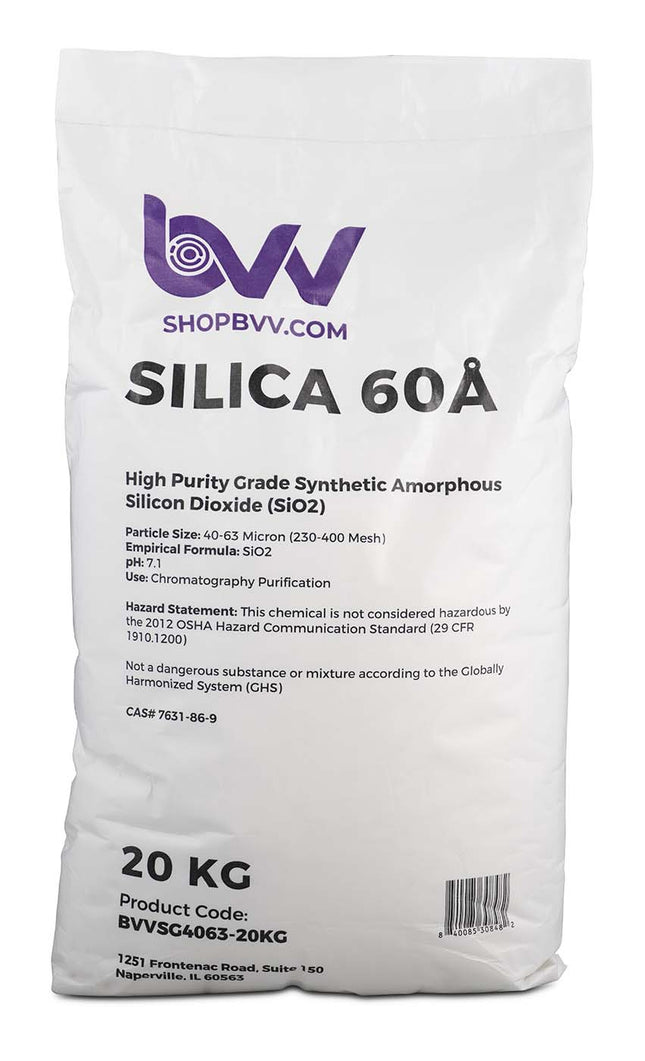
BVV™ 60A Silica Gel 40-63 Micron High Purity Extraction CRC Grade SiO2
BVV™ 60A (40-63 Micron) Silica Gel High Purity Extraction CRC Grade The house brand BVV™ Silica Gel is optimized for Color Remediation extractions. This powdered silica gel is for use in batch extractions and decolorizations. It can also be used as a general adsorbent for impurities. Optimized particle size, surface area, pH, and purity make it a particularly useful material for the separation of small molecules, peptides, lipids, alkaloids, and a variety of other compounds. Silica Gel is particularly useful to use layered on top of your bentonite to remove plant gums and waxes. BVVSG4063 Technical Data Sheet BVVSG4063 Certificate of Analysis BVVSG4063 Safety Data Sheet Key Specs: Particle Size: 40-63 Micron (230-400 Mesh) Pore Volume: 0.72 mL/g Loss on Drying: ≤ 2.0 wt% pH: 7.1 Empirical Formula: SiO2 Use: Decolorization Hazard Statement: No ingredients are hazardous according to OSHA criteria CAS# 7631-86-9
$360.00 - $6,800.00
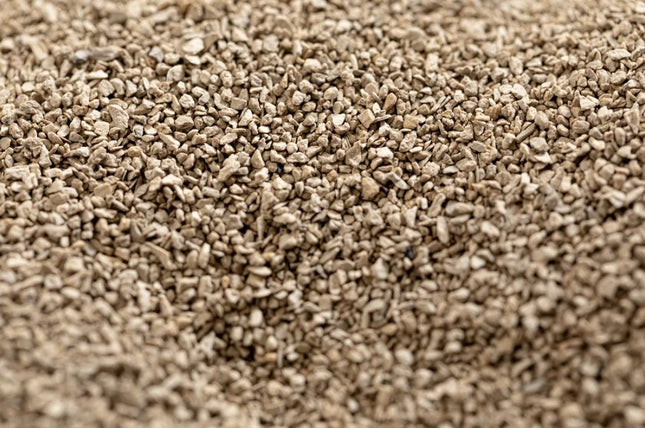
Media Bros CRX™ *Compares to BVV Ultra Clear
CRX™ FILTER MEDIA FOR BHO EXTRACTION (NON-REACTIVE) CRX™ Filter Media is a groundbreaking product widely considered the gold standard in filtration media for inline cannabis hydrocarbon extraction. It stands out against the competition as a non-reactive, customizable filter media specifically designed for high-flow extraction applications. This is Media Bros’ best-selling media. Like its high-flow counterparts, CRY™ and CR41™, CRX™ delivers inline hydrocarbon filtration at a flow rate that allows operators to manipulate outflow through a needle valve or flow controller. This enables techs to deliver a fully customizable process that helps maximize efficiency and provides full control over the final product. But where CRX™ really stands out from the rest of Media Bros' premium hydrocarbon extraction line is its “perfect scrub.” CRX™ is designed to preserve the original essence of the biomass, including full terpene and cannabinoid retention profiles, throughout the filtration stage. The blend is perfectly balanced, which is why we recommend it for high-quality biomass; CRX™ preserves the natural chemical compounds of the biomass while delivering a perfect, consistent final extract every time. All of Media Bros’ line of premium products are granular in size for easy handling and do not require baking, which saves time and space in the lab. CRX™ is organically derived and is FDA GRAS-approved, meaning you could eat it if you wanted to (you probably don’t want to). Extraction labs come in all shapes and sizes, and so does our filter media. CRX™ is packaged conveniently in a 1.5 kg pouch, a 10 kg bucket, and a 100 kg drum. Whether you are running a small-scale operation or a large industrial process, there's a packaging option to suit your specific needs. KEY FEATURES High-Flow Rate: Designed to work seamlessly with inline hydrocarbon extraction, its flow rate allows easy manipulation using a needle valve or flow controller. Perfect Scrub: CRX™ is specifically formulated to preserve the full spectrum of terpenes and cannabinoids, ensuring a flawless, consistent final product. User-Friendly: Granular in size for effortless handling, CRX™ is also oven-free, saving both time and lab space. Safety and Compliance: 100% natural, organically derived and FDA GRAS-approved, CRX™ meets the highest safety standards. TECHNICAL SPECS Solvent Type Hydrocarbon Color Remediation Level Average/Moderate Pesticide Remediation Level Low Selectivity/Polarity Level Moderately Selective/Medium Polarity Heavy Metal Remediation No Moisture Remediation Level Low Fats/Lipids/Waxes Level Medium Crystal Growth Fast Depth Filtration No Flow Rate High Flow pH Level Neutral (pH 7) Best For Fresh Frozen, Nugs, High Quality Suitable for Reruns No Distillation Clean-up Low Scrub Sizes Available: 1.5KG SAMPLE 10KG 5 Gallon Bucket 100KG 55 Gallon Cardboard Drum 1000KG Super Sack (Requires forklift or Pallet Jack) Note: Bulk Bags and Bulk sizes are non-stocked items and will be ordered as needed and carry a several week lead time and require a forklift or pallet jack
$45.00 - $2,000.00
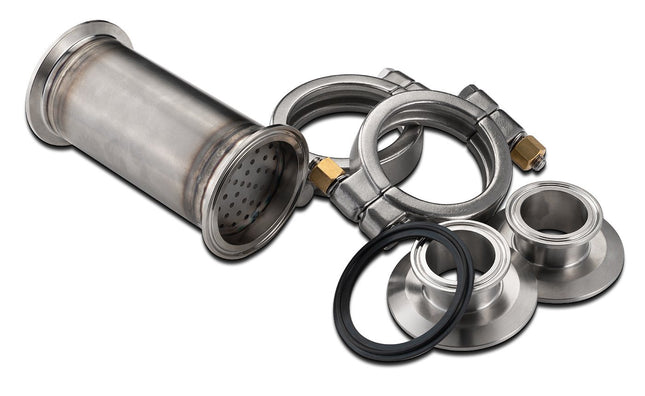
AFS Tri-Clamp Inline Filter Housing for Disposable Color Remediation Cartridges
AFS Tri-Clamp Inline Filter Housing for Disposable Color Remediation Cartridges Note: Disposable cartridges sold separately. (Click Here for Cartridges) This inline housing allows for implementation of the AFS filters into many extraction systems. The AFS filter housing is 2.5" but comes with the adapter flanges for both ends to go inline with a standard 1.5" or 2" tri-clamp system. Kit Includes 2x 2.5" High Pressure Clamps 1x 2.5" Buna-N Gasket 2x Reducers 2.5" to 1.5" or 2" Tri-clamp 1x Cartridge Housing AFS Instruction Manual Download Here AFS SDS Sheet
$200.00
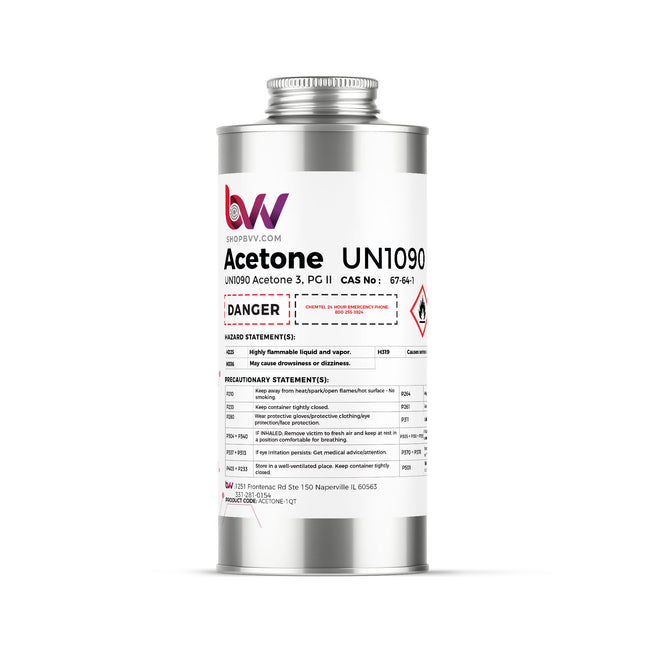
BVV™ High Purity Acetone 99%
BVV™ High Purity Acetone 99% HAZMAT ITEMS ARE NON-REFUNDABLE. ALL SALES ARE FINAL (Note: Container style and color may vary) Explore our top-quality Acetone, a versatile solvent that meets the highest standards of quality and purity. Our Acetone is ideal for a wide range of applications, whether you're in the pharmaceutical, cosmetic or industrial sector. With its exceptional solvent properties, Acetone serves as a reliable solution for cleaning, degreasing, and dissolving various substances. Our Acetone is carefully sourced to ensure consistency and effectiveness, making it a popular choice for professionals and businesses alike. Our Acetone is subjected to stringent quality control measures, ensuring exceptional purity that's perfect for various processes, from extraction to cleaning and stripping applications. Discover the exceptional performance and dependability of our Acetone, specially created to surpass your rigorous requirements. Unleash the potential of this top-notch solvent, and enhance the efficiency and efficacy of your processes to a whole new level. Opt for our Acetone for unparalleled outcomes and make the most of its adaptability in a variety of crucial tasks. BVV™ Acetone 99% - SDS BVV Acetone 99% - COA Chemical Formula: C3H6O Molecular Weight: 58.080 g·mol−1 CAS Registry Number: 67-64-1 Appearance Colorless Liquid Odor: Pungent, fruity Density 0.7845 g/cm3 (25 °C) Boiling Point: 56.08 °C /132.94 °F Solubility in water: Miscible GHS Pictograms: GHS Signal Word: Danger GHS Hazard Statements: H225, H302, H319, H336, H373 GHS Precautionary Statements P210, P235, P260, P305+P351+P338 UN Identification Number: 1090 Proper Shipping Name: Acetone Transport Hazard Class: 3 Packing Group: II DOT Placard: What is Acetone? Acetone is a clear, colorless, and highly flammable liquid with a distinctive sweet, fruity odor. It is a simple organic compound with the chemical formula C3H6O, belonging to the ketone family. Acetone is widely used as a solvent in various industries due to its excellent solubility and fast evaporation rate. In addition to its solvent properties, acetone has many other applications. It is commonly used as a cleaning agent, degreaser, and paint thinner. It is also a key ingredient in nail polish removers and some cosmetic products. Acetone is utilized in the production of plastics, fibers, resins, and various chemicals. Additionally, it serves as a fuel additive and is used for scientific and laboratory purposes. As a highly versatile and effective solvent, acetone plays a vital role in numerous industrial, commercial, and domestic applications, making it an essential component in various processes. What Are The Properties of Acetone? Acetone is a colorless, volatile, and highly flammable liquid with several notable properties: Physical State: Acetone is a liquid at room temperature and pressure, with a boiling point of 132.8F/56C and a melting point of -94.9°C (-138.8°F). Odor: It has a distinct and characteristic odor that is often described as sweet or fruity. Solubility: Acetone is highly soluble in water, alcohols, ethers, and many other organic solvents. This high solubility contributes to its effectiveness as a cleaning agent and solvent. Density: The density of acetone is about 0.79 g/cm³, making it less dense than water. Vapor Pressure: Acetone has a relatively high vapor pressure, which means that it readily evaporates into the air at room temperature. Flammability: Acetone is highly flammable and has a low flash point of -20.8°C (-5.4°F). This means that it can easily ignite when exposed to an open flame, spark, or other sources of ignition. Reactivity: Acetone is a reactive compound and can participate in various chemical reactions. It can react with strong acids, bases, and oxidizing agents. Acidity: Acetone is a weak acid, and its aqueous solutions can exhibit slightly acidic properties. Miscibility: Acetone is miscible with water and many organic solvents. This property makes it suitable for various applications in different industries. Polarity: Acetone is a polar solvent, meaning that it has a partial positive and partial negative charge distribution within its molecule. This polarity allows it to dissolve a wide range of polar and nonpolar compounds. Boiling Point: Acetone has a relatively low boiling point 132.8F/56C, which makes it easy to evaporate and separate from other substances during distillation processes. Evaporation Rate: Acetone has a fast evaporation rate, which makes it suitable for applications where rapid drying is necessary. It's important to note that acetone's properties contribute to its versatility and wide range of applications in various industries, including cleaning, manufacturing, laboratory work, cosmetics, and more. However, due to its flammability and reactivity, proper safety precautions should always be followed when working with acetone. What Is The Structure Of Acetone? The chemical structure of acetone consists of three atoms: one carbon (C) atom, one oxygen (O) atom, and three hydrogen (H) atoms. It is a simple organic compound with the molecular formula C3H6O. The structural formula of acetone can be represented as: In this structural representation: The central carbon (C) atom is bonded to two hydrogen (H) atoms and one oxygen (O) atom. The oxygen atom is double-bonded to the central carbon atom, forming a carbonyl group (C=O). The remaining valences of the carbon atom are filled by single bonds to the two hydrogen atoms. This arrangement of atoms gives acetone its distinctive chemical properties, including its solubility in water, high vapor pressure, and reactivity as a solvent and chemical reagent. How Is Acetone Produced? Acetone is produced through various industrial processes, with the most common method being the catalytic dehydrogenation of isopropanol. Here's an overview of the primary process used to produce acetone: 1. Dehydrogenation of Isopropanol: The most widely used method to produce acetone is the dehydrogenation of isopropanol, also known as the "cumene process." This process involves several steps: a. Production of Cumene: Cumene (isopropylbenzene) is produced from benzene and propylene in the presence of a catalyst such as aluminum chloride. This results in the formation of cumene and hydrogen chloride as byproducts. b. Oxidation of Cumene to Cumene Hydroperoxide: Cumene is then oxidized using air to form cumene hydroperoxide, typically using a catalytic process with acid or base catalysts. c. Cleavage of Cumene Hydroperoxide: Cumene hydroperoxide is cleaved using acid catalysts to yield phenol and acetone. This reaction results in the simultaneous production of phenol, which is used as a valuable chemical in various industries. d. Distillation and Separation: The mixture of phenol and acetone is then separated using distillation techniques. Acetone is obtained as a separate product from the mixture. 2. Other Processes: Apart from the cumene process, there are alternative methods for acetone production, including: a. Propylene Oxidation: Acetone can be produced through the direct oxidation of propylene using air or oxygen as the oxidizing agent. This method yields propylene oxide and acetone as products. b. Acetaldehyde Condensation: In this method, acetaldehyde is condensed and dehydrated to form acetone. This process is less common compared to the cumene process. c. Bio-based Production: Research is ongoing to develop bio-based methods of acetone production, using renewable resources like biomass or microorganisms that can convert sugars into acetone. d. Repurposing Byproducts: Acetone can also be obtained as a byproduct in various industrial processes, such as the production of phenol, where acetone is produced alongside phenol from cumene hydroperoxide. The cumene process remains the most dominant and economical method for producing acetone on an industrial scale. The choice of production method depends on factors such as availability of feedstocks, economics, environmental considerations, and desired product yields. Is Acetone Safe? Acetone is generally recognized as safe (GRAS) when used in appropriate amounts and under proper conditions. However, like any chemical substance, it should be handled with care and used according to safety guidelines. Here are some important points to consider regarding the safety of acetone: Ventilation: Acetone has a strong odor and can release fumes that may be irritating to the eyes, nose, and throat. When using acetone, make sure you are in a well-ventilated area to minimize inhalation of the fumes. Skin Contact: Acetone can be drying to the skin and may cause irritation, especially with prolonged or frequent exposure. It's advisable to wear gloves when handling acetone to protect your skin. Eye Contact: Avoid getting acetone in your eyes, as it can cause irritation and discomfort. If accidental eye contact occurs, rinse your eyes thoroughly with water and seek medical attention if irritation persists. Ingestion: Acetone is not intended for ingestion and should not be consumed. Ingesting acetone can be harmful and may lead to adverse health effects. Flammability: Acetone is highly flammable and should be kept away from open flames, sparks, and heat sources. Store acetone in a cool, dry place and away from direct sunlight. Sensitive Individuals: Some individuals may be more sensitive to the effects of acetone, experiencing skin irritation, allergic reactions, or respiratory discomfort. If you have a history of sensitivities or allergies, exercise caution when using acetone. Use as Directed: When using acetone for specific applications such as nail polish removal, adhesive removal, or cleaning, follow the recommended instructions on the product label or recipe. Avoid excessive or prolonged exposure. Alternative Options: If you are concerned about the potential risks of using acetone, you can consider using alternative products that are specifically formulated for the task at hand. For example, there are acetone-free nail polish removers available that may be gentler on the nails and cuticles. If you have specific health concerns or are unsure about the safety of using acetone, it's always a good idea to consult with a healthcare professional or seek advice from experts in the field. Additionally, reading and following safety information provided on product labels and material safety data sheets (MSDS) is crucial to ensure safe handling and use of acetone and other chemicals. What are the hazards of Acetone? Acetone is a commonly used chemical solvent, but like any chemical substance, it poses certain hazards that need to be considered when handling and using it. Some of the hazards associated with acetone include: Flammability: Acetone is highly flammable and can catch fire easily. Its low flash point makes it volatile and prone to ignition when exposed to open flames, sparks, or heat sources. It's important to store and use acetone away from potential sources of ignition. Inhalation Hazards: Acetone can release strong vapors that are irritating to the respiratory system. Prolonged or repeated inhalation of these vapors can lead to headaches, dizziness, nausea, and respiratory discomfort. Adequate ventilation is essential when using acetone to minimize exposure to its fumes. Skin and Eye Irritation: Acetone can be drying to the skin and may cause irritation or redness upon direct contact. It can also irritate the eyes and lead to discomfort if splashed or accidentally introduced into the eyes. Central Nervous System Effects: Acetone vapor exposure can affect the central nervous system, leading to symptoms like dizziness, confusion, and even unconsciousness at high concentrations. Toxic Effects: While acetone is generally considered to have low toxicity, exposure to large amounts or prolonged exposure can have toxic effects on the body. Ingesting acetone can lead to nausea, vomiting, abdominal pain, and even coma in severe cases. Health Risks: Long-term or chronic exposure to acetone can potentially have adverse health effects, including damage to the liver, kidneys, and respiratory system. Repeated skin contact can cause dryness and irritation. Environmental Impact: Improper disposal of acetone can lead to environmental contamination. Acetone is volatile and can easily evaporate into the air, contributing to air pollution. It can also be harmful to aquatic life if introduced into water bodies. Allergic Reactions: Some individuals may be sensitive or allergic to acetone, experiencing skin reactions or respiratory discomfort even at lower concentrations. It's important to take appropriate safety precautions when using acetone, including wearing protective gear such as gloves and safety goggles, working in a well-ventilated area, and avoiding open flames or heat sources. If working with acetone in an industrial or laboratory setting, it's crucial to follow established safety protocols and guidelines, as well as refer to the material safety data sheet (MSDS) provided by the manufacturer. Overall, while acetone is a valuable solvent with various applications, it should be handled with care and respect for its potential hazards. If you have any concerns or questions about the safe use of acetone, it's recommended to consult with experts in the field or seek guidance from health and safety professionals. How Flammable Is Acetone? Acetone is highly flammable and poses a significant fire and explosion hazard. It has a low flash point of -20.8°C (-5.4°F), which means that it can easily vaporize and form flammable mixtures with air at temperatures above its flash point. Acetone's wide flammability range (2.5% to 12.8% in air) indicates that even small concentrations of acetone vapor in the air can be ignited by a spark, open flame, or other sources of ignition. Due to its low flash point and flammable nature, acetone should be handled with extreme caution and stored away from sources of heat, sparks, and flames. When using acetone, it's important to follow proper safety practices, such as working in well-ventilated areas, using appropriate protective equipment, and avoiding activities that can generate sparks or heat. Acetone's high flammability also makes it necessary to take precautions when storing and transporting the solvent. Flammable liquids like acetone should be stored in approved containers and away from incompatible materials, such as oxidizing agents, to prevent potential chemical reactions and fires. It's essential to be aware of acetone's flammability and take all necessary safety measures to minimize the risk of fire and ensure a safe working environment when handling this solvent. How Is Acetone Used? Acetone is a versatile organic compound with a wide range of industrial, commercial, and household applications due to its excellent solvent properties and low toxicity. Here are some common uses of acetone: Solvent: Acetone is primarily known for its effectiveness as a solvent. It dissolves a variety of substances, making it useful for cleaning, degreasing, and removing residues from surfaces, equipment, and materials. It is commonly used in industrial settings to clean machinery and equipment. Nail Polish Remover: Acetone is a key ingredient in many nail polish removers. It effectively dissolves nail polish and helps remove it from the nails. Paint and Coating Removal: Acetone is used to remove paint, varnishes, lacquers, and other coatings from surfaces like wood, metal, and plastic. It's particularly useful for removing paint spills or overspray. Adhesive Remover: Acetone can be used to soften and remove adhesives, glues, and tapes from surfaces without causing damage. Chemical Intermediate: Acetone is used as an intermediate in the production of other chemicals. It's a precursor in the manufacturing of products like methyl methacrylate, bisphenol A (used in polycarbonate plastics and epoxy resins), and isopropyl alcohol. Laboratory Reagent: Acetone is used in laboratories as a reagent in various chemical reactions and as a solvent for analytical techniques like chromatography. Thinner for Paints and Inks: Acetone is used as a thinning agent for paints, inks, and varnishes to adjust their viscosity and improve their application. Cosmetics and Personal Care Products: Apart from nail polish remover, acetone is used in the production of cosmetics, skincare products, and perfumes. Medical and Pharmaceutical Uses: Acetone is used in some medical and pharmaceutical applications, such as cleaning medical equipment and removing residues from glassware in laboratories. Cleaning Agent: Acetone is effective at removing greasy or sticky residues from various surfaces. It's often used for cleaning electronics, removing ink stains, and cleaning glass surfaces. Fuel Additive: In some instances, acetone is used as an additive in fuel to improve its combustion efficiency, although this application is less common. Aerosol Propellant: Acetone's ability to vaporize quickly makes it useful as a propellant in aerosol products like air fresheners, deodorants, and cleaning sprays. It's important to note that while acetone is versatile and widely used, it should be handled with care due to its flammable nature. Proper ventilation and safety precautions should be taken when using acetone in any application. How Is Acetone Used In Extraction? Acetone is occasionally used in extraction processes, particularly in the field of chemistry and research, where it serves as a solvent to extract certain compounds from various materials. However, it's important to note that acetone has limitations and risks when used for extraction, and its use should be approached cautiously and with proper safety measures. Here's how acetone can be used in extraction processes: Extraction of Essential Oils and Fragrances: Acetone can be used to extract essential oils and fragrances from plant materials. The solvent's low boiling point allows it to evaporate quickly, leaving behind the extracted aromatic compounds. Extraction of Active Compounds: Acetone can be used to extract active compounds from natural sources, such as medicinal plants or herbs. The solvent's polarity can help dissolve and extract specific compounds like alkaloids, flavonoids, and phenolic compounds. Extraction of Lipids and Fats: Acetone is sometimes used to extract lipids and fats from materials like seeds, nuts, or plant tissues. Its ability to dissolve fats and oils makes it suitable for this purpose. Research and Analysis: In laboratories, acetone is sometimes used as a solvent to prepare samples for analysis by techniques like chromatography or spectroscopy. It can help solubilize compounds of interest for further investigation. Cleaning and Preparing Samples: Acetone can be used to clean surfaces and equipment in preparation for various chemical processes, ensuring that surfaces are free from contaminants that could affect the extraction. Recrystallization: Acetone can also be used for recrystallization processes in the lab, where impure solid compounds are dissolved in acetone and then allowed to crystallize out in a more purified form. It's important to exercise caution when using acetone in extraction processes: Flammability: Acetone is highly flammable and should never be used near open flames or in poorly ventilated areas. Toxicity: Acetone can be harmful if inhaled, ingested, or absorbed through the skin. Proper personal protective equipment (PPE) should be worn, and work should be conducted in a well-ventilated area. Chemical Compatibility: Acetone may not be suitable for extracting all types of compounds, as it can degrade certain materials and might not effectively extract specific compounds. Due to these risks and limitations, alternative solvents or extraction methods are often preferred in various extraction processes. When considering using acetone in an extraction, it's crucial to assess the specific requirements of the extraction and ensure that proper safety measures are in place. What Gaskets Are Compatible With Acetone? Acetone is a powerful solvent that can degrade certain materials, including both silicone and Nitrile/BUNA-N gaskets. When choosing gaskets for use with acetone, it's essential to select materials that are resistant to the solvent's effects to ensure safe and effective sealing. The following gasket materials are generally considered compatible with acetone: PTFE (Polytetrafluoroethylene): PTFE gaskets, also known as Teflon gaskets, are highly resistant to acetone and a wide range of other chemicals. They have excellent chemical stability and can withstand the corrosive nature of acetone. Viton (Fluoroelastomer): Viton gaskets are resistant to a variety of chemicals, including acetone. They are often used in applications where high-temperature and chemical resistance are required. EPDM (Ethylene Propylene Diene Monomer): EPDM gaskets are compatible with acetone for short exposure periods. However, their compatibility may be limited in extended contact with acetone or under specific conditions. It's important to note that the compatibility of gasket materials with acetone can vary based on factors such as temperature, concentration, and exposure duration. Before selecting gaskets for use with acetone, it's advisable to also consider the temperature and pressure range of your application to ensure that the chosen material is suitable for your specific application. Additionally, when working with acetone or any other chemical, it's crucial to follow proper safety protocols, including wearing appropriate personal protective equipment (PPE), working in a well-ventilated area, and observing all relevant safety guidelines. How do I clean with Acetone? Cleaning with acetone involves a few simple steps, but it's important to exercise caution due to its flammable nature and strong odor. Here's how to clean with acetone safely and effectively: Materials Needed: Acetone Clean, lint-free cloth or paper towels Ventilated area or protective mask Gloves Eye protection Steps: Choose a Well-Ventilated Area: Before you begin, make sure you're in a well-ventilated space. Acetone has strong fumes, so working outdoors or in a well-ventilated room is recommended. If ventilation is limited, consider wearing a protective mask and eye protection. Put on Protective Gear: While not always necessary for small cleaning tasks, wearing gloves and eye protection can help prevent skin and eye irritation. Test in an Inconspicuous Area: Before using acetone on a larger surface, test it in a small, inconspicuous area to ensure it doesn't damage or discolor the material you're cleaning. Apply Acetone: Moisten a clean, lint-free cloth or paper towel with a small amount of acetone. Gently blot or rub the area you want to clean. Start with a light touch and gradually increase pressure if needed. Avoid scrubbing vigorously, as this could damage surfaces or spread stains. Wipe Clean: As you blot or rub, you'll notice that dirt, residue, or certain stains are lifted onto the cloth. Continue until the area looks clean. For stubborn stains, you may need to repeat the process or use a slightly more concentrated amount of acetone. Dry the Area: After cleaning, use a separate clean cloth or paper towel to dry the area thoroughly. This helps prevent any remaining acetone from evaporating and leaving streaks. Dispose of Materials Safely: Dispose of used cloths, paper towels, and other materials soaked in acetone responsibly. Place them in a sealed container or bag and dispose of them according to your local regulations for hazardous waste. Wash Hands: After you're finished, wash your hands with soap and water to remove any traces of acetone. Important Tips: Acetone can damage certain plastics, paints, and finishes, so always test it in an inconspicuous area first. Do not use acetone on leather, acetate fabrics, or materials with printed designs, as it can cause fading or damage. Keep acetone away from open flames, sparks, or heat sources, as it is highly flammable. Always work in a well-ventilated area or use appropriate personal protective equipment. Remember that acetone is a powerful solvent, so it's best suited for specific cleaning tasks like removing certain adhesives, paint splatters, or sticky residues. If you're uncertain about using acetone on a particular material or surface, consider seeking professional advice or trying an alternative cleaning method. How Do I Make My Own Acetone-Based Nail Polish Remover? Cleaning with acetone involves a few simple steps, but it's important to exercise caution due to its flammable nature and strong odor. Here's how to clean with acetone safely and effectively: Materials Needed: Acetone Clean, lint-free cloth or paper towels Ventilated area or protective mask Gloves (optional) Eye protection (optional) Steps: Choose a Well-Ventilated Area: Before you begin, make sure you're in a well-ventilated space. Acetone has strong fumes, so working outdoors or in a well-ventilated room is recommended. If ventilation is limited, consider wearing a protective mask and eye protection. Put on Protective Gear: While not always necessary for small cleaning tasks, wearing gloves and eye protection can help prevent skin and eye irritation. Test in an Inconspicuous Area: Before using acetone on a larger surface, test it in a small, inconspicuous area to ensure it doesn't damage or discolor the material you're cleaning. Apply Acetone: Moisten a clean, lint-free cloth or paper towel with a small amount of acetone. Gently blot or rub the area you want to clean. Start with a light touch and gradually increase pressure if needed. Avoid scrubbing vigorously, as this could damage surfaces or spread stains. Wipe Clean: As you blot or rub, you'll notice that dirt, residue, or certain stains are lifted onto the cloth. Continue until the area looks clean. For stubborn stains, you may need to repeat the process or use a slightly more concentrated amount of acetone. Dry the Area: After cleaning, use a separate clean cloth or paper towel to dry the area thoroughly. This helps prevent any remaining acetone from evaporating and leaving streaks. Dispose of Materials Safely: Dispose of used cloths, paper towels, and other materials soaked in acetone responsibly. Place them in a sealed container or bag and dispose of them according to your local regulations for hazardous waste. Wash Hands: After you're finished, wash your hands with soap and water to remove any traces of acetone. Important Tips: Acetone can damage certain plastics, paints, and finishes, so always test it in an inconspicuous area first. Do not use acetone on leather, acetate fabrics, or materials with printed designs, as it can cause fading or damage. Keep acetone away from open flames, sparks, or heat sources, as it is highly flammable. Always work in a well-ventilated area or use appropriate personal protective equipment. Remember that acetone is a powerful solvent, so it's best suited for specific cleaning tasks like removing certain adhesives, paint splatters, or sticky residues. If you're uncertain about using acetone on a particular material or surface, consider seeking professional advice or trying an alternative cleaning method. What Is The Average Amount Of Acetone Used in Nail Polish Remover? The average amount of acetone used in commercial nail polish remover products typically ranges from 30% to 50%. This means that the nail polish remover solution contains 30% to 50% acetone, along with other ingredients such as water, emollients, and fragrances. The exact percentage can vary depending on the brand and formulation of the nail polish remover. When making your own nail polish remover at home, you can use pure acetone or a solution with a similar acetone concentration. Keep in mind that using pure acetone can be harsh on your nails and cuticles, potentially causing dryness and irritation with frequent use. It's a good idea to experiment with different acetone concentrations and observe how your nails and skin react to find the right balance between effective nail polish removal and gentle care for your nails. How Do you Dispose of Acetone? Disposing of acetone properly is important to ensure environmental and personal safety. Here are the steps to follow for proper acetone disposal: Check Local Regulations: Before disposing of acetone, check your local regulations and guidelines for hazardous waste disposal. Different regions may have specific requirements and disposal methods. Use a Secure Container: Transfer the acetone to a tightly sealed, labeled, and non-reactive container. Glass or metal containers with a secure lid are recommended. Label the Container: Clearly label the container with the contents ("Acetone"), the hazard symbol, and any other relevant information. Do Not Mix: Do not mix acetone with other chemicals, as this could lead to hazardous reactions. Contact Local Waste Disposal Facility: Contact your local hazardous waste disposal facility or municipality to inquire about drop-off locations and collection programs for hazardous materials. Do Not Pour Down the Drain: Do not pour acetone down the drain, toilet, or any other water source, as it can contaminate water systems and harm the environment. Evaporate in a Controlled Setting: If allowed by local regulations, you can let a small amount of acetone evaporate in a well-ventilated outdoor area. Ensure it's away from open flames, sparks, or ignition sources. Recycle or Reuse: Some regions may offer recycling or reclamation programs for acetone or other solvents. Research if any such programs are available in your area. Professional Disposal: If you have a large amount of acetone or are uncertain about the proper disposal method, consider contacting a professional hazardous waste disposal service. Remember, improper disposal of hazardous materials like acetone can harm the environment, human health, and local communities. Always prioritize safety and follow the regulations set by your local authorities for proper disposal.
$18.00 - $705.00
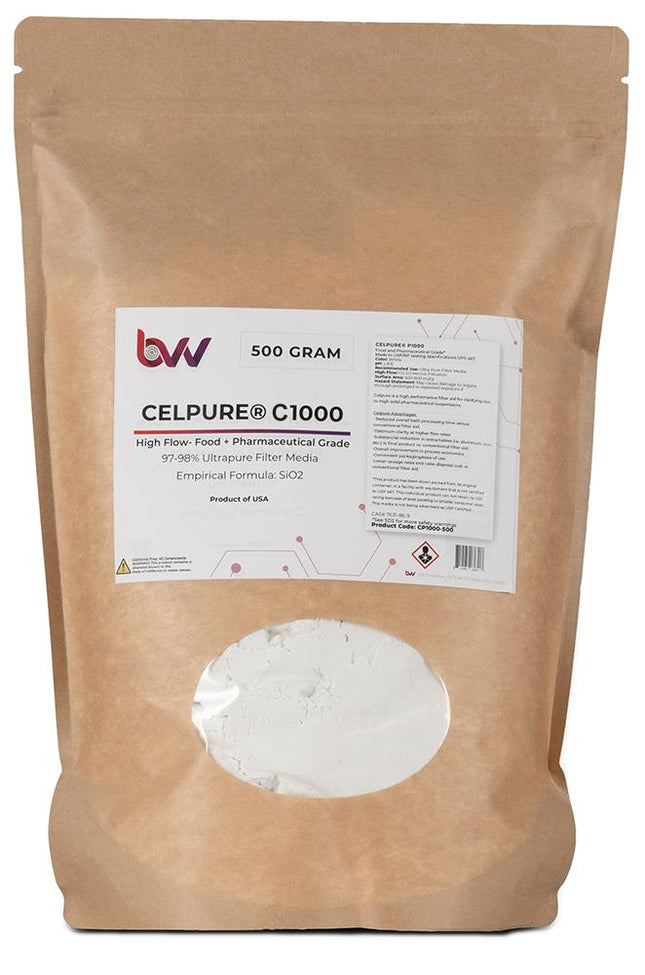
CELPURE® C1000 meets USP/NF & GMP testing specifications
CELPURE® C1000 High Purity Grade diatomite filter aids for the biopharmaceutical, pharmaceutical, high purity chemical, and specialty beverage industries. Meets all USP/NF & GMP testing specifications. Manufactured in a stand-alone, FDA registered plant in California. CELPURE C1000 COA CELPURE C1000 SDS Product Data Sheet: Celpure® Comparison to Conventional Diatomite Celpure Advantages: Reduced overall bath processing time versus conventional filter aid. Optimum clarity at higher flow rates Substantial reduction in extractables (i.e. aluminum, iron, etc.) in final product vs. conventional filter aid. Overall improvement in process economics Convenient packaging/ease of use. Lower usage rates and cake-disposal cost vs. conventional filter aid
$34.00 - $340.00
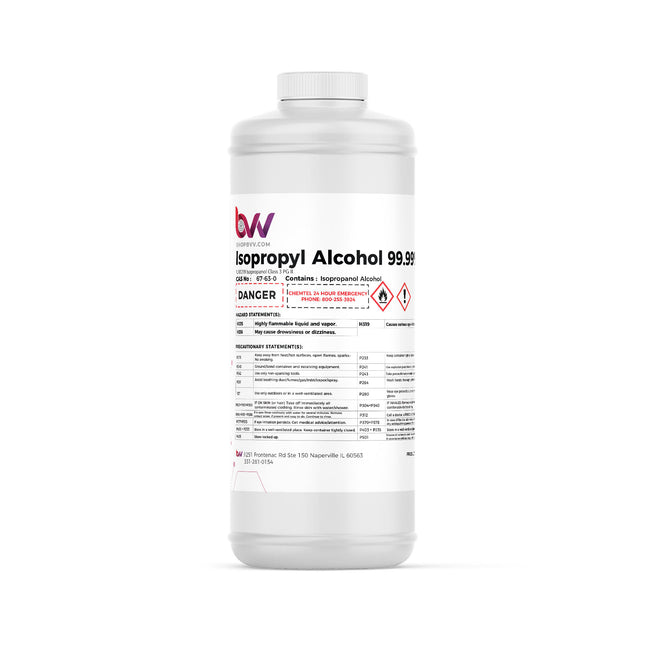
BVV™ High Purity Isopropyl Alcohol IPA 99%
BVV™ High Purity Isopropyl Alcohol IPA 99% Isopropyl alcohol, also known as 2-propanol or rubbing alcohol, is one of the most common alcohol solutions. The exact mechanism behind isopropanol’s disinfectant is not certain, however, it’s believed to kill cells through the process of denaturing cell proteins and DNA, dissolving cell lipoprotein membranes, and obstructing cellular metabolism. Isopropanol has a range of applications and uses across multiple industries, from medicine to cosmetics, and we explore this below. Cleaning Agent for Extraction, Laboratory, and Medical Industries In addition, 99% pure isopropyl alcohol serves as a cleaning agent for the laboratory, medical, and extraction industries. Mixed with water, this solution can be used as a rubbing-alcohol antiseptic. Quality solvents are vital for cleaning delicate electronics, extraction equipment, and other sensitive items. It also makes a perfect solution for surface disinfectant. 99% IPA evaporates cleanly and minimizes residual substances. Cleaning Agent for Home Care A truly versatile solution used in a variety of applications, isopropyl can also serve as a home cleaning remedy. For example, many window and toilet bowl cleaners contain isopropyl alcohol. rubbing alcohol can dissolve icky residues such as chewing gum, sap, hairspray, and other difficult compounds from hands, surfaces, and more. Other ways isopropyl can be used: Cleaning makeup brushes Cleaning blinds Cleaning sinks and chrome Deodorizing shoes Disinfecting computer mouse and keyboard Disinfecting mobile phone Dissolving windshield frost Getting rid of fruit flies Cleaning jewelry Creating homemade sanitizer Preventing ring around the collar Cleaning stainless steel Other Things to Note Spigots/Faucets are only compatible with 5 Gallon Jugs and must be purchased separately Trigger Sprayer is only compatible with 1QT and 1 Gallon sizes Isopropyl alcohol is a fast-evaporating solvent and industrial cleaning agent, intended for industrial or professional use only. It can be used as a solvent for gums, shellac, and essential oils. Can be used as a fuel additive. Isopropyl Alcohol (liquid) - 99.8% Purity Shelf Life - 5 years Specific Gravity - 0.79 Vapor Pressure - 1psi @ 20°C Flash Point - 12°C Boiling Point - 82°C *Disclaimer: 1 Quart Bottles are exempt from additional Hazmat shipping charges and can ship immediately, Less paperwork for shipping is required for shipping only 1 single bottle per order. BVV™ Isopropyl Alcohol SDS BVV™ Isopropyl Alcohol COA Chemical Formula: C3H8O Molecular Weight: 60.096 g/mol CAS Registry Number: 67-63-0 Appearance Colorless Liquid Odor: Pungent Alcoholic odor Density 0.786 g/cm3 (20 °C) Boiling Point: 82.6 °C /180.7 °F Solubility in water: miscible GHS Pictograms: GHS Signal Word: Danger GHS Hazard Statements: H225, H302, H319, H336 GHS Precautionary Statements P210, P261, P305+P351+P338 UN Identification Number: 1219 Proper Shipping Name: Isopropanol Transport Hazard Class: 3 Packing Group: II DOT Placard:
$16.00 - $2,900.00
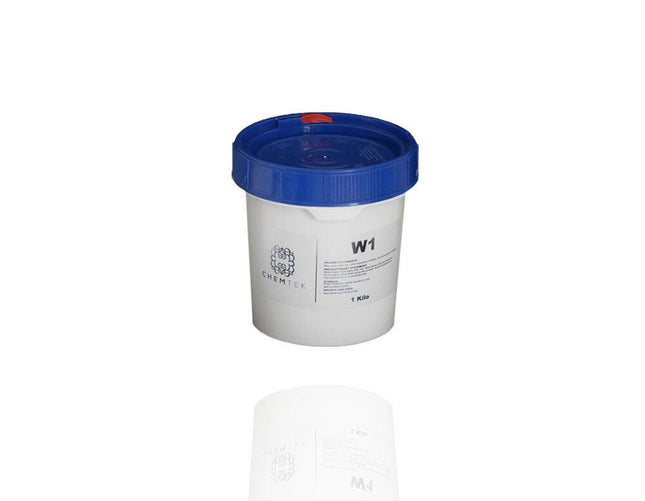
CHEMTEK W1 Acid Activated Refinement Clay
Chemtek W1 W1 (TM) is an acid activated bentonite clay adsorbent specific for the removal of chlorophyll, heavy metals, and fats. W1 is very effective at bleaching and refining while preserving the terpenes present in the oil. Unlike other clays, the ability to remove soaps and free fatty acids which are produced during the bleaching process reduces the amount of clay needed to bleach. W1 SDS W1 Technical Data Sheet
$80.00 - $450.00
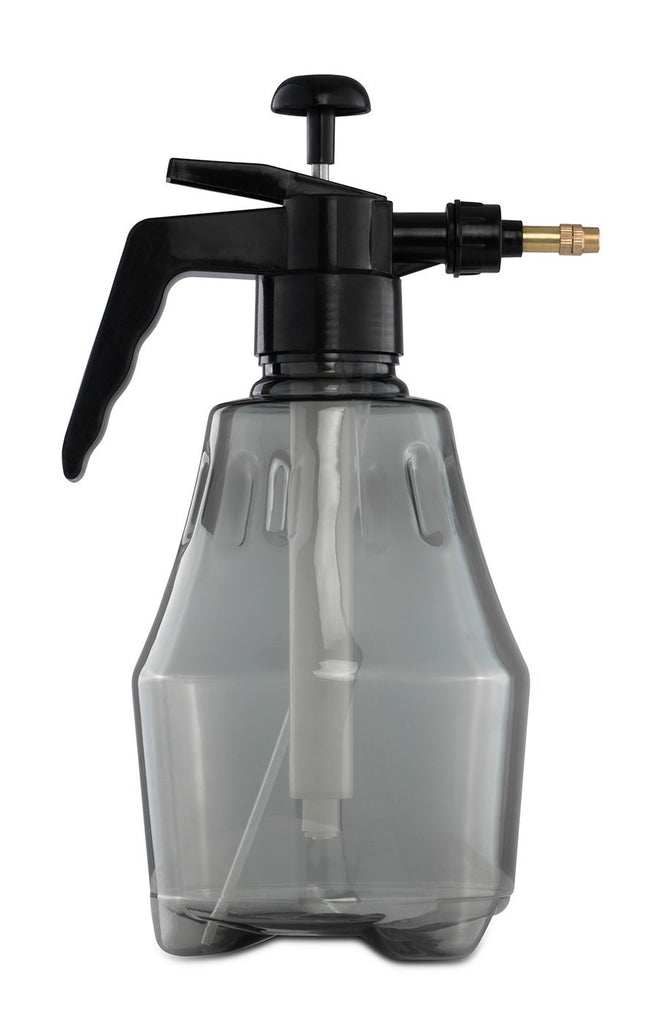
Pressurized Spray Bottle 1.5L / 50oz
Pressurized Spray Bottle 1.5L / 50oz This is a heavy-duty, refillable pump sprayer. It features an adjustable brass spray nozzle. Capacity is 50 oz/1.5 L. Used to apply cleaning agents, alcohols, most pest/disease control products, foliar sprays.
$10.00$6.00
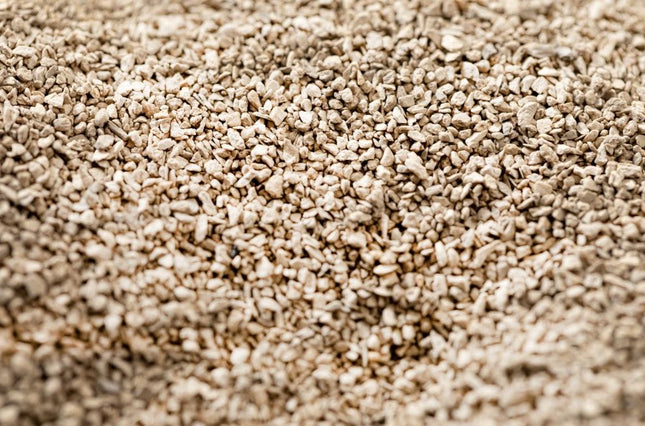
Media Bros CRY™
CRY™ FILTER MEDIA FOR BHO EXTRACTION (NON-REACTIVE) CRY™ is a more aggressive variant of our flagship CRX™, but with the same high flow, controllable process. CRY™ is slightly more selective, with about 1.5X the embedded silica content compared to CRX™. This allows CRY™ to filter a wider range of compounds, targeting heavy metals specifically. It is the perfect scrub for nug run, due to its ability to handle higher moisture content biomass. CRY™ also shines when processing high chlorophyll content material like aged-out biomass. Its increased silica content not only boosts the filtration range but also enhances the overall extraction quality. If you are not quite sure if one would work better for your process, try a blend. Both CRX™ and CRY™ work synergistically, and many extractors blend them together at specific blend ratios, fine-tuning their cannabis remediation processes. Customizing the blend ratio according to your specific needs allows you to exploit the full potential of these filtration powerhouses. Need to know how to do it? We offer support and consulting to help you get the most out of your extract. CRY™ Filter Media is packaged conveniently in a 1.5 kg pouch, a 10 kg bucket, and a 100 kg drum. These varied packaging options cater to operations of different scales, from small businesses to large-scale industrial processes. The best extracts in the world are made with Media Bros. FDA GRAS Approved 100% Natural TECHNICAL SPECS Solvent Type Hydrocarbon Color Remediation Level Moderately Heavy/High Pesticide Remediation Level Medium Selectivity/Polarity Level Moderately Selective/Medium Polarity Heavy Metal Remediation Yes Moisture Remediation Level Moderate Fats/Lipids/Waxes Level Medium Crystal Growth Fast Depth Filtration No Flow Rate High Flow pH Level Neutral (pH 7) Best For Fresh Frozen, Nugs, High Quality Suitable for Reruns Yes Distillation Clean-up Moderate Scrub Sizes Available: 1.5KG SAMPLE 10KG 5 Gallon Bucket 100KG 55 Gallon Cardboard Drum 1000KG Super Sack (Requires forklift or Pallet Jack) Note: Bulk Bags and Bulk sizes are non-stocked items and will be ordered as needed and carry a several week lead time and require a forklift or pallet jack
$45.00 - $2,000.00
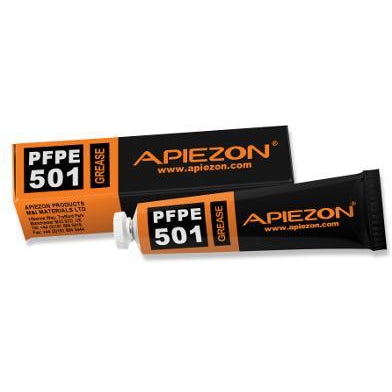
Apiezon PFPE 501 High Temperature Vacuum Grease
Apiezon PFPE 501 High Temperature Vacuum Grease 100g We are pleased to announce that there is a new addition to the Apiezon range of high vacuum greases. Delivering the quality and reliability synonymous with the Apiezon brand, PFPE 501 is the perfect addition to our range. PFPE 501 is a chemically inert, high temperature and extreme pressure lubricant. With an upper operating temperature of 250°C and vapor pressure of 1.3 x 10-12 at 25°C, it is robust, versatile and can be used for sealing and lubricating under the most extreme operating conditions. This includes environments where aggressive chemicals and strong oxidizing agents are regularly used. As most Apiezon users are more familiar with hydrocarbon chemistry we’d like to provide some background on what PFPE is, and how its molecular structure can explain its physical properties. This information can be found in What is PFPE? Safety Data Sheet Technical Data Sheet Why Use Apiezon PFPE 501 Grease? PFPE based High temperature lubricant Used in oxygen-rich environments Ultra high vacuum Chemically inert Extreme pressure Wide temperature range Benefits of Apiezon PFPE 501 Grease? Extended equipment life High temperature lubricant Reduced equipment downtime Lower service costs Life-time lubrication 10 year shelf life Guaranteed Apiezon quality Expert technical support
$285.00
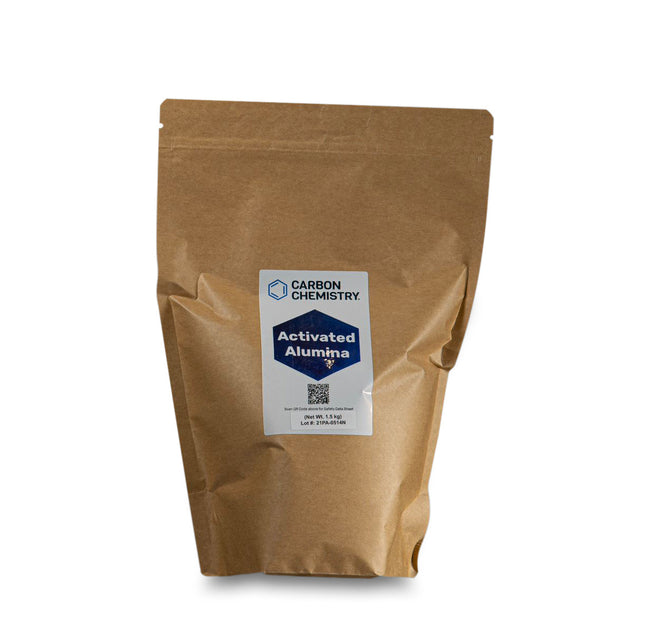
Carbon Chemistry Activated Alumina
Carbon Chemistry Activated Alumina Carbon Chemistry Activated Alumina powder is some of the highest purity and quality activated alumina on the market. Activated alumina can mainly be used as a filtration aid to remove fats, color, and polar compounds to produce a cleaner end product. Carbon Chemistry Activated Alumina - SDS Note: Bulk Bags and Bulk sizes are non-stocked items and will be ordered as needed and carry a several week lead time and require a forklift or pallet jack
$27.00 - $6,750.00
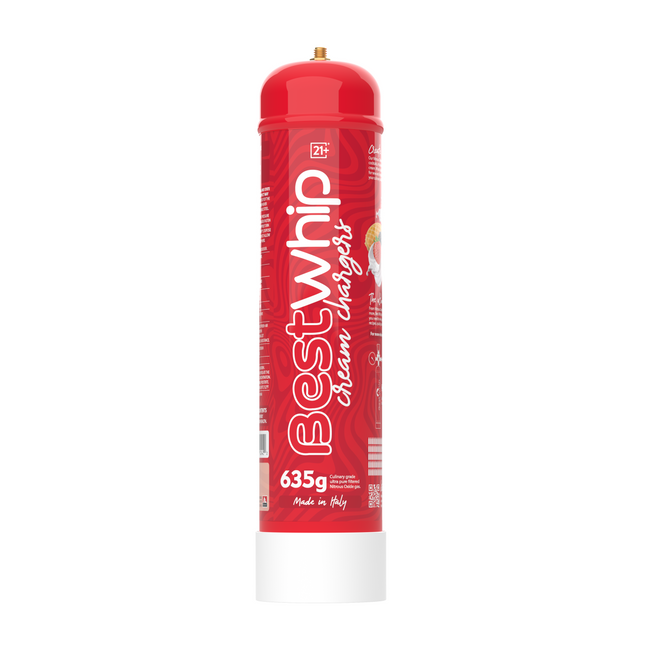
Best Whip Food-Grade Nitrous Oxide Tank 99% Pure (635g / 321 liters)
Best Whip Nitrous Oxide 635g / 1.4lbs / 321 Gas Volume Liters 99% Purity This innovative cylinder is the fastest and easiest way to replenish your cream. It is not only a good assistant for making dessert at home but also a new solution for the industrial catering industry! Before using our whipped cream-making equipment you must first read the manufacturer's instructions. This will show you how to safely charge your cream using the cream 635g tank. Cylinder Fitting: M11x1 Thread (compatible with this Regulator M11x1-CR) Tank Pressure: 755 PSI Includes 1 nozzle per tank. *At end of use use this nozzle to completely empty the tank for recycling. SUPER GAS QUALITY - Each tank is filled high quality NO2. That is why you will not have a hard time making chocolate or vanilla, mint, or Bailey's flavored cream whipper. Cocktail foams, airy sauce, mousse, and hot or cold foam can be made easily, too. FOOD-GRADE & LONG SHELF LIFE - Best Whip tanks are made with food-grade compliance and production standards. Each tank has a long shelf life of 5 years so you can use them over a period of time. ANTI-LEAKAGE DESIGN - Best Whip canister conforms with Manufacturing International Standards such as ISO 9001, and ISO 9002. Any cream dispenser can be used with this cylinder. UNIVERSAL COMPATIBILITY - Compatible with all professional whipped cream makers in the market. From now on, you can easily finish making whipped cream in a few seconds and without leaving odors or contaminants in the dispenser. RECYCLEABLE CONTAINER - Made of steel construction. When you're done with it simply attach the included nozzle to discharge any remaining gas and place it in the recycling bin. What Is Nitrous Oxide? Nitrous Oxide is a chemical compound with the formula N2O. It is a colorless, non-flammable gas with a slightly sweet odor and taste. Nitrous oxide is often used for various purposes due to its unique properties and effects. What is Nitrous Oxide Used For? Nitrous oxide (N2O) is most commonly used in the culinary world for various purposes, primarily for creating foams, whipped creams, and infusions. Outside the culinary world nitrous oxide is also commonly utilized as a propellant, a cryogenic refrigerant, and as a performance-enhancing additive for internal combustion engines. Here's how nitrous oxide is most commonly used in culinary applications: Whipped Cream: Nitrous oxide is perhaps most well-known in the culinary field for its use in making whipped cream. In this application, heavy cream and sweeteners are combined in a whipped cream dispenser or siphon, and nitrous oxide cartridges are used to pressurize the dispenser. When the cream is released from the dispenser, the sudden release of pressure causes the nitrous oxide to expand and whip the cream into a light and fluffy texture. This method allows for the creation of stable whipped cream that retains its texture for an extended period. Foams: Chefs use nitrous oxide to create foams from various liquids, such as fruit juices, sauces, and purees. To make a foam, the desired liquid is mixed with a gelling agent, strained, and loaded into a whipped cream dispenser along with nitrous oxide. When dispensed, the nitrous oxide aerates the liquid, resulting in a light and airy foam that can be used as a garnish or flavor enhancer. Infusions: Nitrous oxide can be used to infuse liquids with the flavors of herbs, spices, fruits, or other aromatic ingredients. For example, herbs like basil or spices like cinnamon can be placed in a whipped cream dispenser along with a liquid (e.g., oil or alcohol) and nitrous oxide. The pressurized nitrous oxide infuses the liquid with the flavors and aromas of the added ingredients quickly. Cocktails: Some bartenders use nitrous oxide to create foam or froth on cocktails, adding a unique visual and textural element to drinks. This technique is especially popular in molecular mixology. Sauces and Dressings: Nitrous oxide can be used to create light and airy sauces or dressings. By adding nitrous oxide to a mixture of liquids and ingredients, chefs can achieve a desired texture and consistency. Desserts: Nitrous oxide can be used to create innovative desserts, such as foamy fruit purees, mousse-like textures, and light, airy soufflés. It's essential to use food-grade nitrous oxide and follow proper safety precautions when using it in culinary applications. The use of nitrous oxide cartridges and whipped cream dispensers is common in professional kitchens and home cooking to achieve these culinary effects. What Are The Hazards Of Nitrous Oxide? Nitrous oxide (N2O), while commonly used in various applications can pose certain hazards if not used properly. Here are some potential hazards associated with nitrous oxide: Asphyxiation: The most significant hazard of nitrous oxide in culinary use is the risk of asphyxiation. Nitrous oxide can displace oxygen in an enclosed space, leading to oxygen deprivation if inhaled in high concentrations. This can result in dizziness, loss of consciousness, and even death. Frostbite: Nitrous oxide is stored as a compressed liquid and is extremely cold when released. Contact with liquid nitrous oxide can cause frostbite or cold burns to the skin. Care should be taken when handling nitrous oxide cartridges or dispensers. Is Nitrous Oxide Flammable? Nitrous oxide (N2O) is not flammable in the typical sense because it does not support combustion. However, it can contribute to the combustion of other substances. Here's a more detailed explanation: Non-Flammable: Nitrous oxide itself does not burn or catch fire. It is an oxidizer, meaning it can support the combustion of other substances by providing oxygen. When nitrous oxide is used in applications like rocket propulsion or automotive nitrous systems, it does not ignite by itself. Enhancing Combustion: Nitrous oxide is sometimes used in combination with fuel in internal combustion engines to increase power output. In this context, it is often referred to as "nitrous" or "NOS." When nitrous oxide is injected into the engine's intake, it provides additional oxygen, allowing more fuel to burn, resulting in increased engine power. However, it's important to note that this process is controlled and safe when used as intended in automotive applications. Safety Precautions: While nitrous oxide is generally considered safe when used according to manufacturer guidelines, improper handling or misuse can be hazardous. Nitrous oxide should not be exposed to open flames, sparks, or high temperatures, as it can decompose at elevated temperatures and pressure, potentially leading to the release of oxygen and nitrogen gases. In summary, nitrous oxide is not flammable by itself, but it can enhance the combustion of other materials when used in controlled and purposeful applications. When using nitrous oxide, it's essential to follow safety guidelines and avoid exposing it to conditions that could lead to its decomposition or unintended ignition. How Do I Use Nitrous Oxide Safely? Using nitrous oxide (N2O) safely is crucial to prevent accidents and health risks. Here are some general guidelines for using nitrous oxide safely: Follow Manufacturer's Instructions: Always follow the manufacturer's instructions for any equipment or cartridges containing nitrous oxide. Different devices or cartridges may have specific usage guidelines. Ventilation: Ensure that you use nitrous oxide in a well-ventilated area. Adequate ventilation helps disperse any gas leaks and prevents the buildup of nitrous oxide in confined spaces, reducing the risk of asphyxiation. Avoid Direct Inhalation: Never inhale nitrous oxide directly from cartridges, whipped cream dispensers, or any other source. Inhaling nitrous oxide for recreational purposes can be dangerous and is not recommended. Protective Gear: When handling nitrous oxide cartridges or equipment, especially if they contain liquid nitrous oxide, wear appropriate protective gear, such as gloves and safety glasses, to prevent frostbite or cold burns. Store Safely: Store nitrous oxide cartridges and equipment in a cool, dry place away from direct sunlight and heat sources. Keep them out of the reach of children and unauthorized individuals. No Smoking: Avoid smoking or open flames near nitrous oxide,while nitrous oxide is not flammable, it will support combustion to the same extent as oxygen. Training and Education: Ensure that individuals using nitrous oxide equipment are trained in its safe handling and usage. Leak Detection: Regularly check for leaks in nitrous oxide equipment and connections. Use a leak detection solution (soapy water) to identify leaks by observing bubbles at the connections. Proper Disposal: Dispose of used nitrous oxide cartridges and equipment according to local regulations and guidelines. Do not puncture or incinerate cartridges. Emergency Preparedness: Be prepared for emergencies by having safety equipment, such as fire extinguishers and first-aid kits, readily available in areas where nitrous oxide is used or stored. Follow Legal Regulations: Abide by local laws and regulations regarding the sale, purchase, and use of nitrous oxide. In some areas, nitrous oxide may be subject to restrictions due to its potential for misuse. Always exercise caution and prioritize safety when using nitrous oxide, whether it's for culinary, automotive, medical, or other legitimate purposes. If you have specific concerns or questions about the safe use of nitrous oxide in a particular context, consult with experts or regulatory authorities in your area.
$21.82 - $130.92
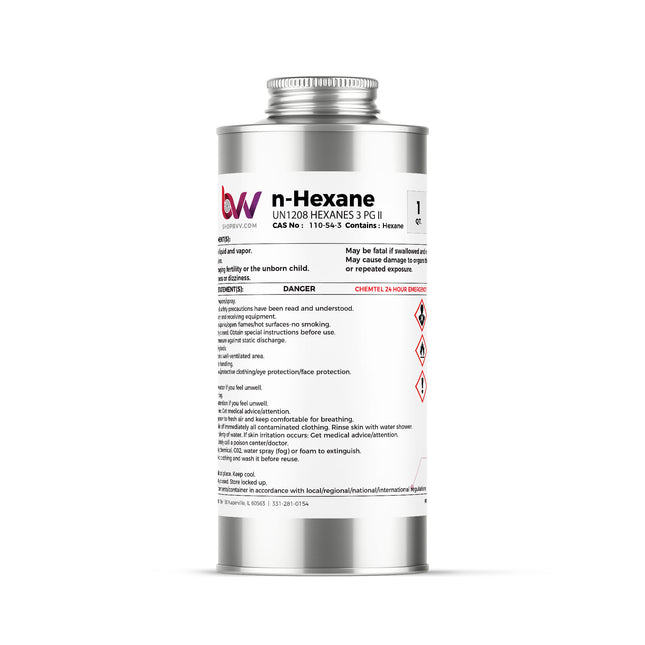
BVV™ ULTRA High Purity Lab Grade N-Hexane 99.5%
BVV™ Ultra High Purity Lab Grade N-Hexane HAZMAT ITEMS ARE NON-REFUNDABLE. ALL SALES ARE FINAL (Note: Container style and color may vary) BVV™ Ultra High Purity Lab Grade N-Hexane is a perfect solution for cleaning up and clarifying the extracted material and removing the green colored plant material and some waxes out of the product to produce a cleaner end result when distilling extracts. n-Hexane Safety Data Sheet Chemical Formula: C6H14 Molecular Weight: 86.178 g·mol−1 CAS Registry Number: 110-54-3 Appearance Colorless Liquid Odor: Petrolic Density 0.6606 g mL−1 Boiling Point: 68.5 °C / 155.2 °F Solubility in water: 9.5 mg L−1 GHS Pictograms: GHS Signal Word: Danger GHS Hazard Statements: H225, H302, H305, H315, H336, H361fd, H373, H411 GHS Precautionary Statements P201, P202, P210, P233, P235, P240, P241, P242, P243, P260, P264, P271, P273, P280, P281, P301+P330+P331, P302+P352, P303+P361+P353, P304+P340, P308+P313, P310, P312, P314, P332+P313, P363, P370+P378, P391, P403+P233, P405, P501 UN Identification Number: 1208 Proper Shipping Name: Hexanes Transport Hazard Class: 3 Packing Group: II DOT Placard:
$0.00 - $1,450.00
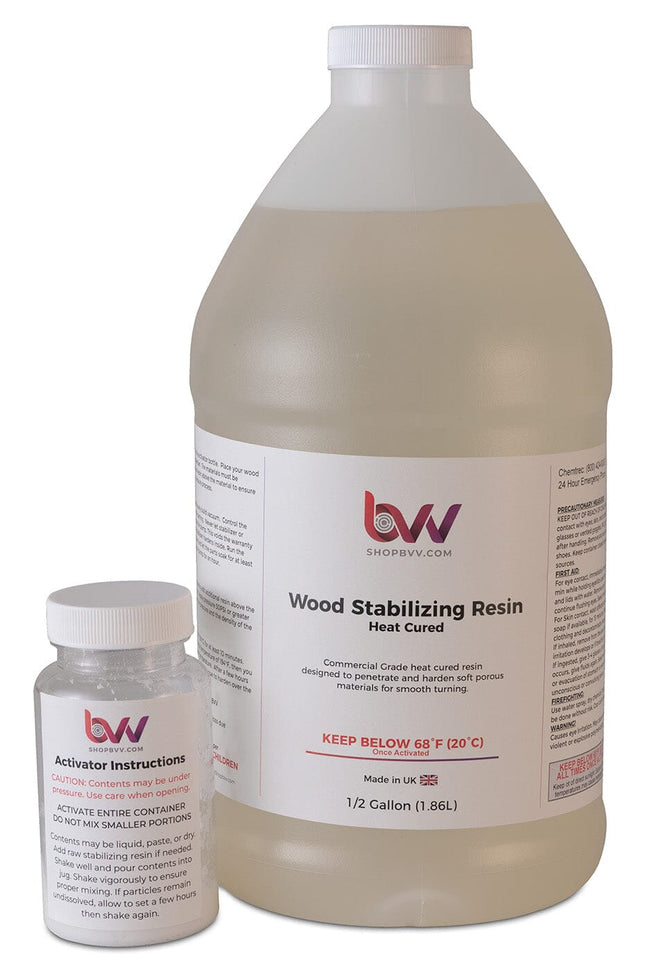
BVV Wood Stabilizing Resin PC504/66
Wood Stabilizing Resin with Activator (Heated Cured) Commercial Grade heat cured resin designed to penetrate and harden soft porous materials for smooth turning Disclaimer: Activator comes separated from resin wood stabilizer. It is intended for stabilization of wood products and is not intended for human consumption. Note: Spigots/Faucets are only compatible with 5 Gallon Jugs and must be purchased separately Note: This product is compatible with Cactus Juice and can be blended. Precautionary Statement: Store at temperatures not exceeding 20°C /68°F Wood Stabilizing Resin SDS Wood Stabilizing Resin TDS Wood Stabilizing Resin Instructions Aerospace approved heat-cured resin for stabilizing and hardening the wood and other porous material. This resin is reusable and does not significantly change the color of most woods. Prior to first use or after an extended period of storage, entire contents should be de-gassed by subjecting contents to a vacuum of at least 25 inches of mercury for 30 minutes. Wood Stabilizer will cure when exposed to 194°F (90°C) for at least 10 minutes. Therefore the time required to completely cure a stabilized blank will depend on factors such as wood thickness and density. Wood Stabilizer is compatible with many dyes and stains. However, BVV™ makes no guarantee or warranty that Wood Stabilizing Resin is compatible with all dyes and stains and will not be liable for any loss due to incompatibility. It is recommended to test compatibility on a small sample first to reduce risk of loss of wood or stabilizer
$42.00 - $3,230.00
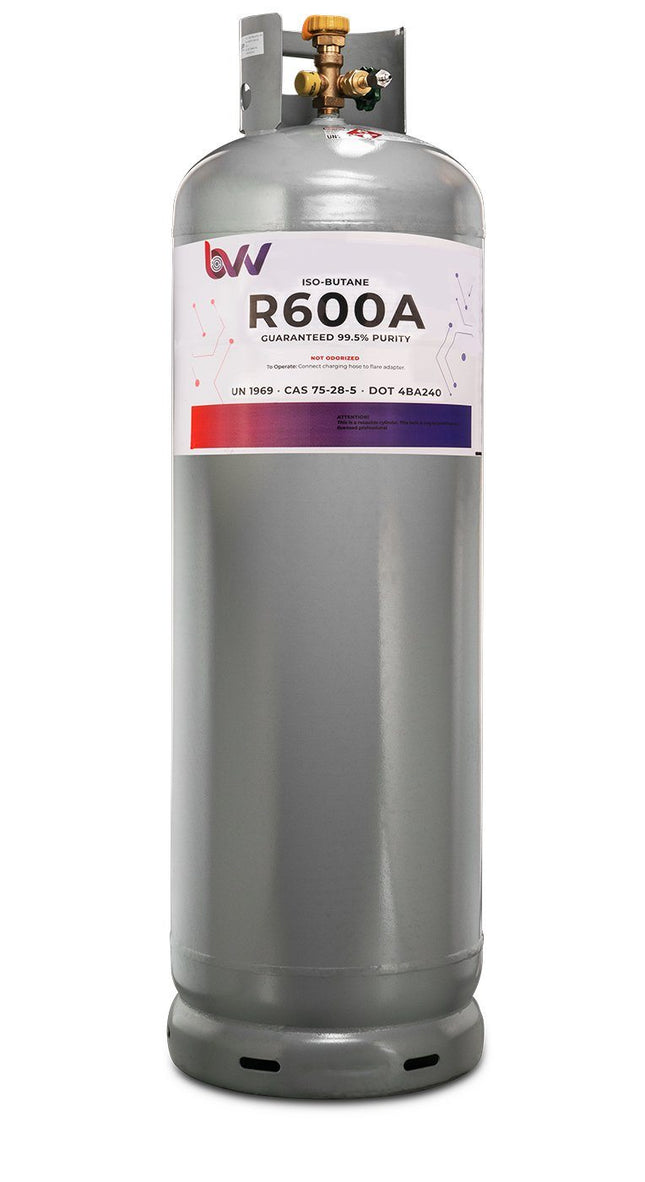
120LB DIPTUBE Tank High Purity USA ISO-BUTANE R600A - 99.5% Guaranteed
120LB DIPTUBE Tank High Purity USA ISO-BUTANE R600A DIPTUBE- 99.5% Guaranteed DISCLAIMER(S): This unit is intended for LEGAL purposes only, to be used in accordance with local laws and ordinances. Use only in WELL VENTILATED AREAS! Notice: This item will ship via Freight ONLY. BVV™ always recommends distillation of every solvent before use. Tank does not include CGA 555 fitting. Must be added through dropdown or bought separately. California now prohibits the retail sale of any Non-Odorized butane in quantities larger than 150ml. If you are not a retail purchaser you can call in to place an order. Permitted Sales Include the Following: Medical Collectives or Cooperatives operating under CA Health & Safety Code Section 11362.775 Persons licensed to perform volatile solvent extraction activity under CA Bus & Prof Code Division 10 Manufacturers, wholesalers, resellers, or retailers solely for the purpose of resale At Best Value Vacs, quality is everything, and our ISO-Butane is certainly no exception. This ISO-Butane is sourced here in the U.S, so you know it’s going to be of high purity: we guarantee 99.5% purity. With such high quality, you’ll see the results. By cutting down on mystery oils and other contaminants, our instrument-grade solvent will make for a higher quality extract. This solvent is clean, odorless, and colorless, meaning there are zero hydrogen sulfide-based Ethyl Mercaptan odorants. It’ll arrive in a DOT refillable LP tank. Typical Analysis: ISO-Butane >99.8% Methane <1 ppm Ethane <1ppm N-Butane <2000 ppm Propane <250ppm Isopentane <2 ppm Water <3 ppm CO+CO2 <5ppm Oxygen <5 ppm Nitrogen <10 ppm Sulfur Non-Detected **Notes: Actual ISO-butane liquid weight is 116LB Best Value Vacs always advises distillation of every solvent before using it. DISCLAIMER: Our items are intended for LEGAL purposes only, to be used in accordance with local laws and ordinances. For safe operation, only use the unit in well-ventilated areas. ***Shipping Notes: This item will ONLY ship via UPS Ground, in accordance with FAA regulations. Any orders including solvent will NOT be shipped Expedited. If an order includes solvent as well as additional items, it will all be shipped via UPS Ground/Freight even if you’ve selected Expedited. If you want the non-solvent item to ship Expedited, place 2 separate orders; we won’t split up orders and ship them separately otherwise. We do not ship solvents to Hawaii, Puerto Rico, or any other U.S. Territory outside of the contiguous 48 States. Shipping solvent to Alaska will ONLY be via freight and will be required to travel through Canada. Our shipping policies are in place to ensure safe transport of solvents and prevent any problems with shipping times for Best Value Vacs customers
$795.00 - $809.00
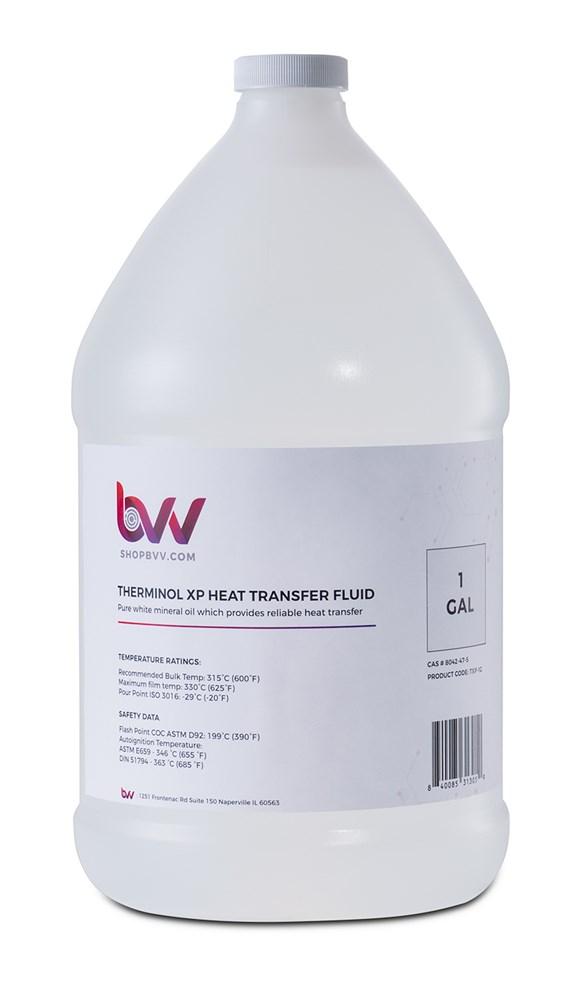
Therminol XP Heat Transfer Fluid
Product description Safety Data Sheet Technical Data Sheet Therminol XP heat transfer fluid is an extremely pure white mineral oil which provides reliable heat transfer. Performance Benefits Low Fouling— The chemical composition of Therminol XP has been carefully selected to minimize system fouling that results from oxidation and degradation of the fluid. Practically Non-Toxic— It meets the purity specifications in U.S. Food and Drug Administration Regulation 21 CFR 172.878 and is listed as a Registered Nonfood Compound by NSF International (Category Code HT-1: Heat transfer fluids - Incidental contact). Thermal Stability—Users can expect many years of reliable, trouble-free operation, even when operating Therminol XP continuously at the recommended bulk temperature of 315°C (600°F). Environmentally Friendly—Therminol XP has outstanding regulatory status for those seeking heat transfer fluids that have minimum environmental reporting requirements. Applications Adhesives Desalination Dryer heating Fatty acid HTF - bakery HTF - deodorizing HTF - deodorizing oil and fat HTF - edible oil HTF - food production HTF - food/feed/beverage processing HTF - production of bioalcohol HTF - production of biodiesel Industrial Peek (polyether ether ketone) Phthalic anhydride Polyester (PET) Specialty and batch chemical production Specialty chemicals Key attributes Environmentally Friendly Low Fouling Practically Non-Toxic Thermal Stability
$150.00 - $4,000.00
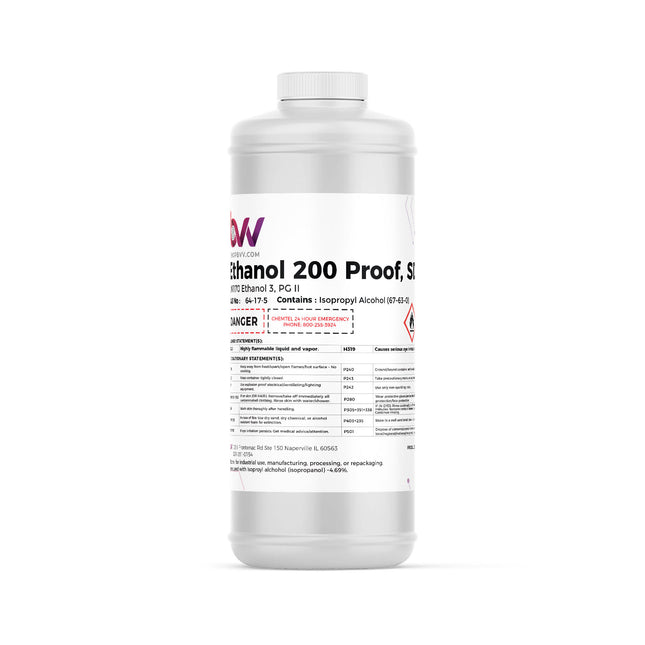
Ethanol 200 Proof, SDA 3C (100% ABV) Lab Grade
BVV™ Ethanol 200 Proof, SDA 3C Contains: Isopropyl Alcohol ~4.69% 100% AVB (alcohol by volume) HAZMAT ITEMS ARE NON-REFUNDABLE. ALL SALES ARE FINAL Specially Denatured Alcohol, 3C is a mixture of 200 proof grain ethanol mixed with just under 5% isopropyl alcohol. Its laboratory grade and is used for scientific applications, perfume, reagent/solvent, personal care products, and research and as and as a fuel for certain types of lamps and burners. The term "200 proof" refers to the alcohol's strength, which is equivalent to 100% alcohol by volume (ABV). This means that there is no water or other substances present in the alcohol, making it very pure and highly concentrated. Ethanol 200 Proof, SDA 3C Certificate of Analysis (COA) Ethanol 200 Proof, SDA 3C Safety Data Sheet (SDS) Chemical Formula: C2H5OH Molecular Weight: 46.069 CAS Registry Number: Ethanol 64-17-5Isopropyl Alcohol 67-63-0 Appearance Colorless Liquid Odor: wine-like, pungent Density 0.78945 g/cm3 @ 20 °C Boiling Point: 78.23C/172.81F Solubility in water: Miscible GHS Pictograms: GHS Signal Word: Danger GHS Hazard Statements: H225, H319, H360D GHS Precautionary Statements P210, P233, P240, P241, P242, P305+P351+P338 UN Identification Number: 1170 Proper Shipping Name: Ethanol Transport Hazard Class: 3 Packing Group: II DOT Placard:
$18.00 - $850.00
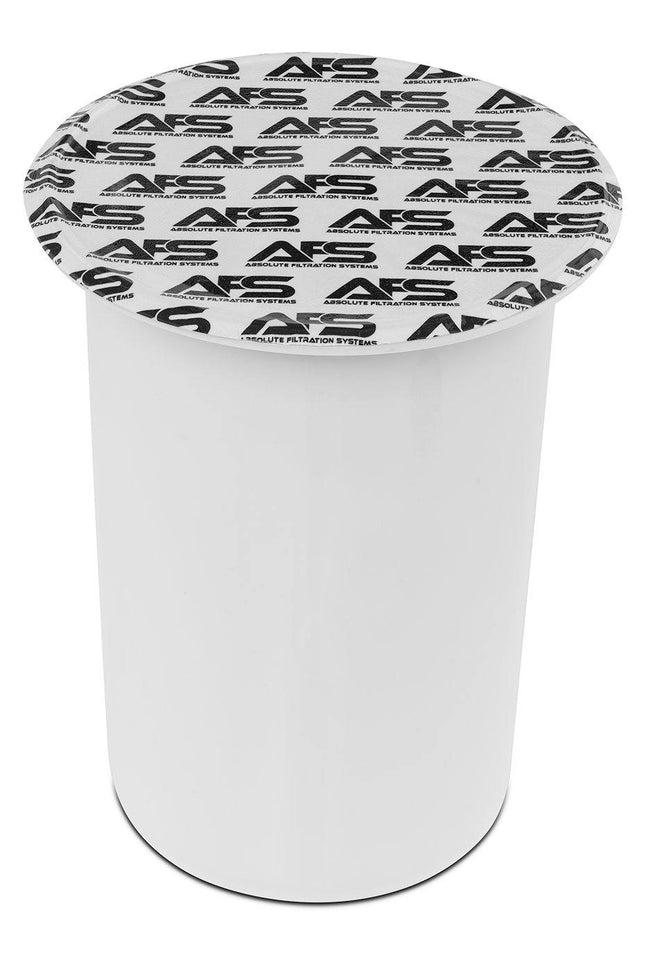
AFS 4" Disposable Color Remediation Cartridge
AFS Disposable Color Remediation Cartridge Note: Stainless Steel filter housing sold separately. (Click Here for Housing) AFS Instruction Manual Download Here AFS Filters are the first and only disposable color remediation filter cartridges for the botanical extraction industry. Our Patent Pending design allows for an easy to use solution implemented into existing extraction systems and is now available as a standard integration from many equipment manufacturers. AFS Filters are a simple solution that allows for the use of prepackaged filters, which are available in different recipes depending on the application. With the integrated 2.5µm paper filter molded and sealed into the cup, there is no media leak through. Pre-packed means there's no need to be an expert in remediation filter media and how to construct filters; as well as eliminates the messy process of building/packing filters yourself. Disposable offers no need for cleaning the filter housings afterward and trying to un-clog stainless filter screens. Less R&D investment, less mess, and less downtime allows for higher throughput and more profit. These come in light, medium, and heavy filtration. Learn more about each: Light Filtration is the trimmed down version of the standard Medium filter. These are best suited for extractions using fresh high-end input materials that only needs a light cleaning. Medium Filtration is our standard go-to filter. This is the most commonly used and sold filter AFS offers.. It's great for general filtration and lightening of extracted products. Heavy Filtration is packed with the highest amount of active extraction media. These filters are best suited for exceptionally dark extractions or for extractions with normal input materials where the desired outcome is closer to clear. Heavy filters offer the highest level of filtration. Technical Specifications: Life Span: 1 Time use, 5-7 lbs. of dry material. Temperature Rating: -40°C-70°C Top Seal: Induction Sealed (No glue is used) Filter: Cellulose Paper Pressure Rating: Recommended 60psi, Paper will hold 80-90 psi Max. Media: Proprietary licensed recipe. Shell Material: Polypropylene Excellent compatibility and Safe for chemicals in our industry (Butane, Propane, Ethanol). Pressure Method: Nitrogen Assist, unless you open blast CRC. Then you can assist with an air compressor. *Please recycle your spent Cartridges.
$119.99 - $799.99
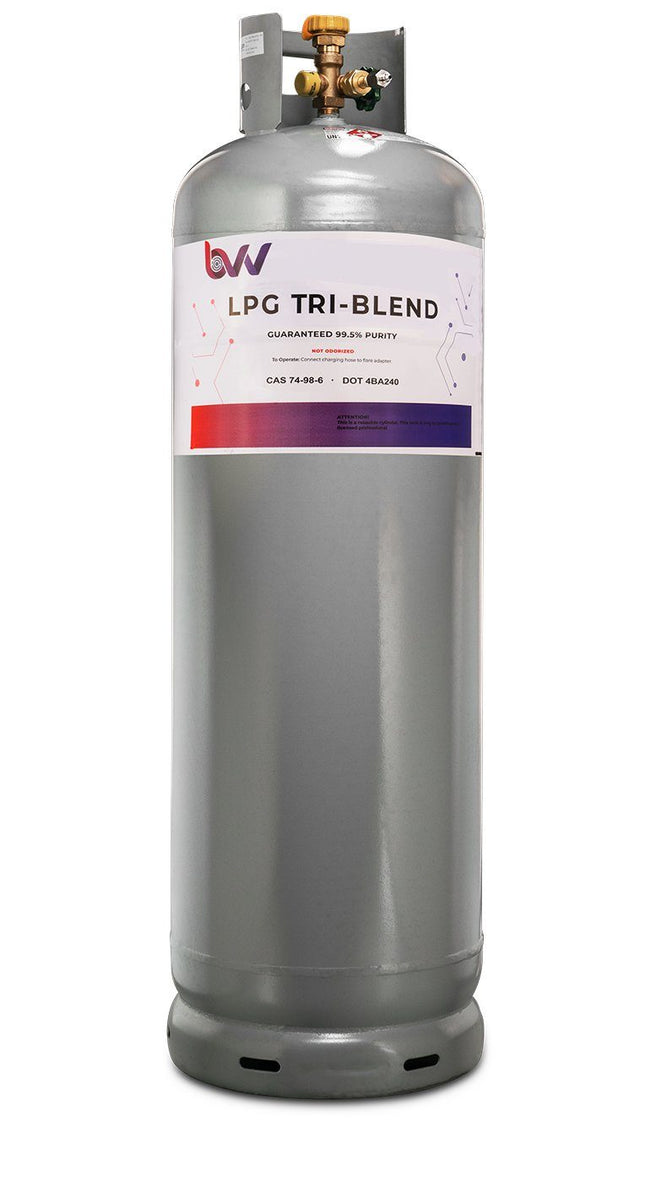
120LB DIPTUBE Tank High Purity USA 50/25/25% N-Butane/Iso-Butane/Propane TRI-Blend - 99.5% Guaranteed
120LB High Purity USA 50/25/25% N-Butane/Iso-Butane/Propane TRI-Blend DIPTUBE - 99.5% Guaranteed DISCLAIMER(S): This unit is intended for LEGAL purposes only, to be used in accordance with local laws and ordinances. Use only in WELL VENTILATED AREAS! Notice: This item will ship via Freight ONLY. BVV™ always recommends the distillation of every solvent before use. Tank does not include CGA 555 fitting. Must be added through dropdown or bought separately. California now prohibits the retail sale of any Non-Odorized butane in quantities larger than 150ml. If you are not a retail purchaser you can call in to place an order. Actual 50/25/25% N-Butane/Iso-Butane/Propane Tri-Blend liquid weight is 114LB Permitted Sales Include the Following: Medical Collectives or Cooperatives operating under CA Health & Safety Code Section 11362.775 Persons licensed to perform volatile solvent extraction activity under CA Bus & Prof Code Division 10 Manufacturers, wholesalers, resellers, or retailers solely for the purpose of resale Ultra-high purity 50/25/25% N-Butane/Iso-Butane/Propane TRI-Blend is USA-sourced and guaranteed to be 99.5% pure. This instrument grade solvent helps to produce a higher quality extract by reducing mystery oils and contaminants. The solvent comes in a DOT refillable LP tank. *This product is clean, colorless and odorless. *Actual 50/25/25% 50/25/25% N-Butane/Iso-Butane/Propane Tri-Blend liquid weight is 114LB BVV™ Tri-Blend SDS Due to FAA regulations, solvent tanks cannot be safely transported via means other than ground. Any order that has solvent will not be shipped in an expedited fashion. If an order with solvent is combined with any other items and chosen to be expedited, that entire order will ship via UPS Ground/Freight. We will not split up any orders and ship them separately. If a customer is wanting to expedite specific items and order solvent, 2 separate orders (1 for the solvent and 1 for the expedited items) will need to be placed in order to do so. Solvents do not ship to Hawaii, Puerto Rico, or any other US Territory outside of the contiguous 48 States. Shipping Solvent to Alaska may ONLY ship via freight and will be required to travel through Canada. We have this policy in place to ensure safety when transporting solvents, and to prevent any issue with shipping times for our customers.
$795.00 - $809.00
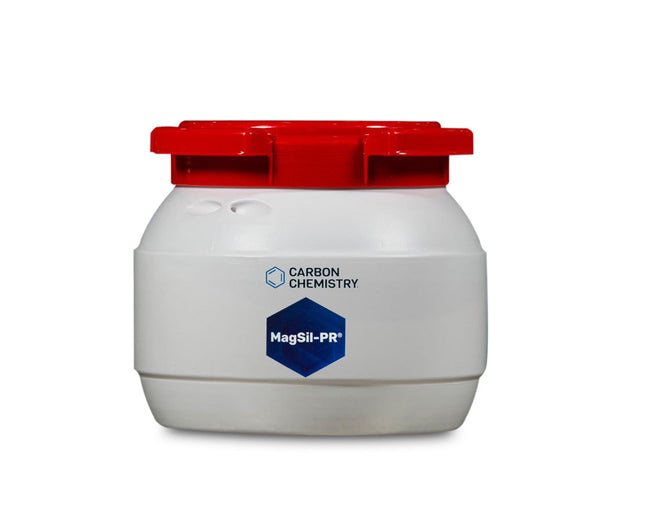
Carbon Chemistry MagSil-PR®
Carbon Chemistry MagSil-PR® Carbon Chemistry MagSil-PR® powder is some of the highest purity and quality MagSil-PR® on the market. Activated Magnesium Silicate (MagSil-PR®) lets you remove pesticides, improve color, and improve the clarity of your products, thanks to its powerful properties. Magnesium silicate will bind to polar, water-soluble compounds. Once these compounds have bonded with the MagSil, the solution can be filtered through a recommended, 20-micron mesh screen. Particle Mesh Size: 60/100 Carbon Chemistry MagSil-PR® - SDS
$145.00 - $1,800.00
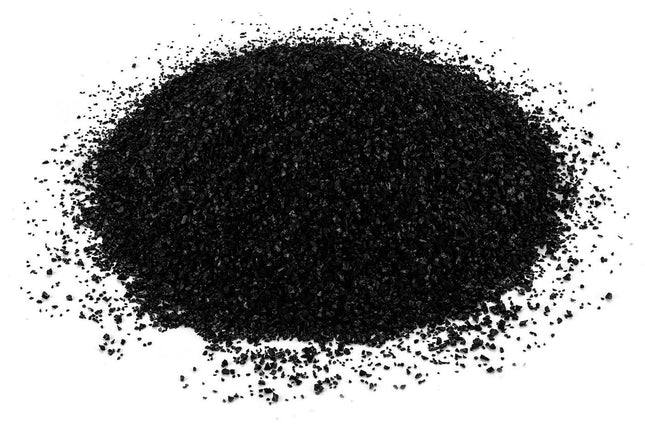
Uniform Carbon Pre-Washed
Uniform Carbon Pre-Washed Uniform Carbon Pre-Washed is a granular multipurpose, coconut based adsorbent. The prewash removes all powder resulting in the uniform granule size for ease of use. Uniform Carbon Pre-Washed SDS Sheet
$40.00
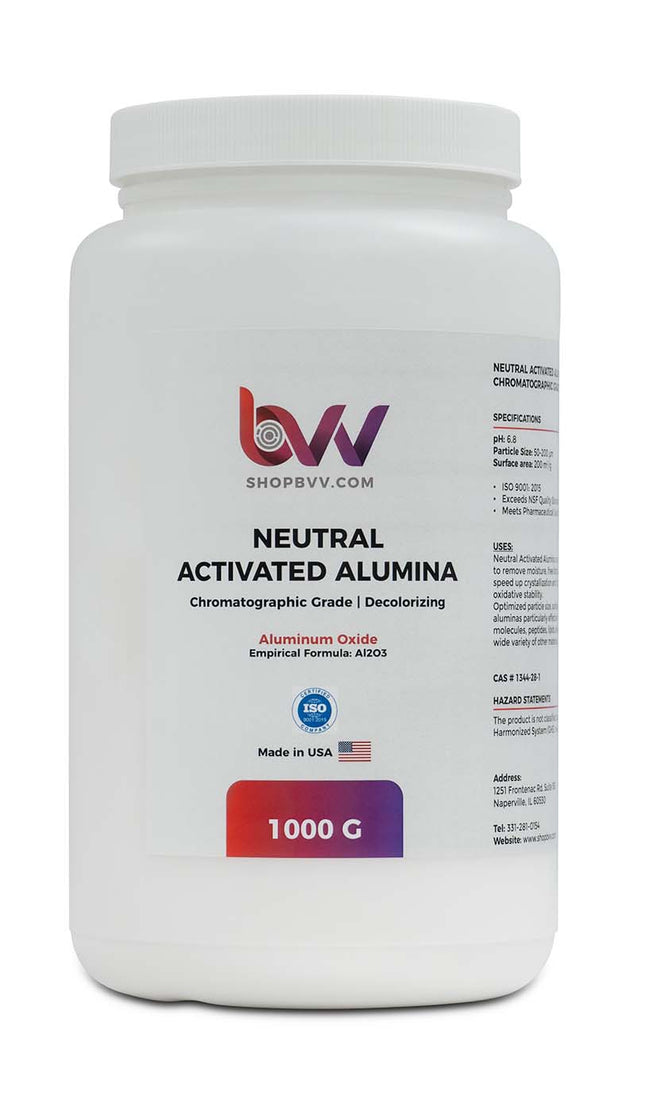
Neutral Activated Alumina Chromatographic Grade (50-200um) *Compare to Alumicel™N
Neutral Activated Alumina pH: 6.8 | 50-200 Micron Made in USA *Compare to Alumicel™N This activated alumina is a neutral pH adsorbent used to remove excess moisture from your extraction and CRC process. The addition of this media is used as the last layer in the typical BVV™ CRC setups. This grabs any excess moisture from the previous CRC layers and the Biomass. The activated alumina will produce a sugary finish almost immediately after you start your purge. This rapid crystallization is because the process has stripped out additional phospholipoids and fats. This produces an overall extract that is less prone to oxidation and has a longer shelf life. Chromatographic Grade Manufactured in the USA since 1937 Manufactured to the highest quality standards ISO 9001:2015 BVV™ Neutral Activated Alumina Technical Data Sheet BVV™ Neutral Activated Alumina Safety Data Sheet BVV™ Neutral Activated Alumina Quality Certificate
$54.00 - $8,600.00
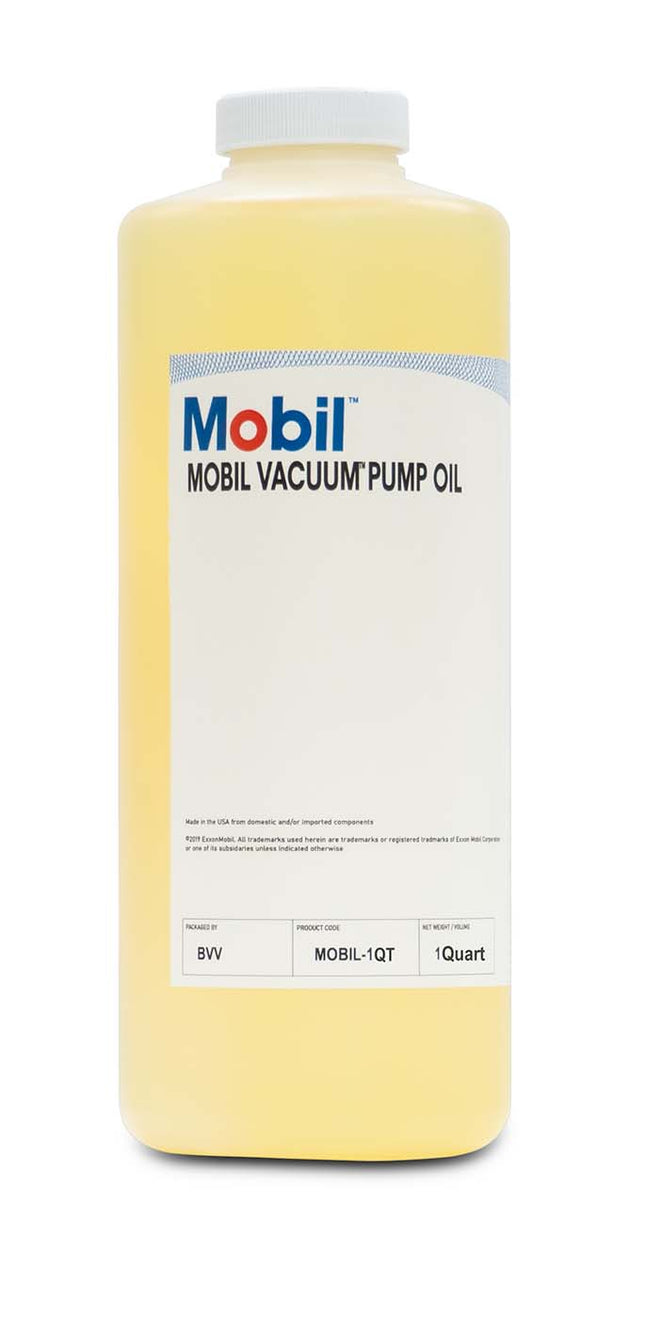
Mobil Vacuum Pump Oil SAE Grade 20, ISO Viscosity Grade 68 (Mist Free)
BVV's Top Recommended Vacuum Pump Oil Ultra long Service Life! Mobil Vacuum™ Pump Oil is a special lubricant that is designed to be used for the lubrication of critical vacuum pumps. It has a very low vapor pressure and can be used when extremely high vacuum is required. It provides excellent wear and corrosion protection for vacuum pump components and will give the following benefits in service: Long lubrication life No viscosity change in use No odor or vapor generated Wide use temperature range Pulls vacuum down to 1micron or less (*BVV internal testing) SAE Grade 20, ISO Viscosity Grade 68 Safety Data Sheet Product Data Sheet BVV's Testimonial: "Mobil Vacuum Pump Oil has an insane service life and at BVV we have migrated over to Mobile for all of our laboratory pump applications. We use Mobil oil for Edwards, Welch, and the BVV Pro Series pumps. From vacuum purging and distillation we know we need good oil to get low vacuum and the fact that we can run continually for months on the same oil is amazing. This oil has led to less pump rebuilds and extended service life of our in house pumps used in our labs. Overall Mobil is the most reliable oil we have ever used at BVV." Water vapor is a common contaminant in vacuum systems and tends to condense inside the pumps. Mobil Vacuum Pump Oil has good demulsibility (Ability to separate oil from water) Which aids water removal and prevents its return to metal surfaces to cause rust and corrosion. This oil has a high degree of chemical stability enabling it to resist oxidation and the subsequent formation of sludge and deposits, an essential characteristic in all cases where continuous service is involved. This enables the oil to retain its original properties such as viscosity and demulsibility and so to prolong oil service life.
$27.00 - $265.00

Nitrogen Tank for Extraction 99.5% Pure
Nitrogen Beverage Grade 99.5% Pure Made in Italy This modest but mighty nitrogen tank is a great to pair with any 2lb or smaller extraction system. For those customers that need nitrogen to push their solvent through color remediation columns (CRC) or for those super cold dewax extractions that need the extra push to get the remaining solvent out of the cold columns. Directions: (*Hose not Included with regulator) Connect a stainless steel braided 1/4" JIC hose (or vacuum hose BVV-HVAC) to your extractor, placed at the valve where you need your extra pressure push. Using the needle valve you can open the regulator and the nitrogen will flow. Pressurize 15-30PSI. *Note Nitrogen Tank Pressure is 1580 PSI Tank Volume of Nitrogen Coverage Product Sku: 130g / 103 Liters / 27 Gallons See Use Chart Below... NITROGEN-130G Regulator Details Nitrogen Regulator - Adjustable via. needle valve, regulated to 80 PSI. Made in Italy. Thread: M11x1 (tank connection). Output: 1/4" JIC to connect to any of our 1/4" extractor hoses or vacuum hoses. Gauges read in BAR. How long will it last?: A 1lb column of biomass (3"x24") is equal to ~2.7 liters empty. That's about 38 column volumes. Assuming you only used 4 column volumes per extraction you would get ~10 extractions from one tank. Column Size Column Volume # Runs/Tank 1.5x12 (70g biomass column) 0.34 Liters ~75 2x12 (120g biomass column) 0.6 Liters ~54 3x24 (1lb biomass column) 2.7 Liters ~12 4x24 (2lb biomass column) 4.9 Liters ~6 *Use calculated @ 4 column volumes per run What Is Nitrogen Gas? Nitrogen gas is a chemical element and a diatomic molecule with the chemical formula N2. It is a colorless, odorless, and tasteless gas that makes up about 78% of Earth's atmosphere by volume. Nitrogen gas is an essential component of the air we breathe and plays a crucial role in various natural processes and industrial applications. In its gaseous form, nitrogen is composed of two nitrogen atoms tightly bonded together by a strong triple bond. Due to its stable molecular structure, nitrogen gas is relatively inert and does not readily react with other substances under normal conditions. What Is Nitrogen Gas Used For? Nitrogen gas has a wide range of applications across various industries and scientific fields due to its inert nature, abundance, and unique properties. Some of the key uses of nitrogen gas include: Food Preservation: Nitrogen gas is used to create controlled atmospheres in food packaging to extend the shelf life of perishable products. It helps prevent the growth of spoilage microorganisms and maintains the freshness of packaged foods. Laboratory Applications: Nitrogen gas is used in laboratories as a carrier gas for chromatography, as a purge gas to remove oxygen and moisture from sensitive reactions, and for preserving and storing samples. Welding and Metalworking: Nitrogen gas is employed as a shield gas during welding and metalworking processes to prevent oxidation and maintain the integrity of metal surfaces. Electronics Manufacturing: In electronics manufacturing, nitrogen gas is used to create inert environments that prevent oxidation and improve the quality of soldering and component assembly. Cryogenic Applications: Nitrogen gas, when cooled to extremely low temperatures, becomes liquid nitrogen. It is used in cryopreservation of biological samples, freezing and storing biological materials, and in various cryogenic cooling applications. Fire Suppression: Nitrogen gas is utilized as a fire suppressant in certain situations to reduce the concentration of oxygen, effectively suppressing fires and preventing explosions. Oil and Gas Industry: In the oil and gas industry, nitrogen gas is used for pressure testing pipelines, purging equipment, and enhancing oil recovery. Medical and Healthcare: Nitrogen gas is used in medical applications, such as cryotherapy for skin treatments, freezing of warts and lesions, and providing a dry environment for sensitive medical instruments. tAerospace and Aviation: Nitrogen gas is used to pressurize aircraft tires and hydraulic systems, preventing moisture and oxidation-related issues. Fertilizer Production: Nitrogen gas is a key component in the production of ammonia-based fertilizers, which are essential for promoting plant growth in agriculture. Diving Industry: In underwater diving, nitrogen gas is used in breathing gases such as air and nitrox. Pneumatic Systems: Nitrogen gas is used in pneumatic systems for inflating tires, powering tools, and operating machinery. Food and Beverage Industry: Nitrogen gas is used to dispense draft beer, wine, coffee, and other beverages, creating a foamy head and enhancing the presentation. How Can I Pressure Test My Extractor With Nitrogen? Pressure testing your extractor with nitrogen involves using nitrogen gas to check for leaks, verify the integrity of the equipment, and ensure its safety before performing actual extraction processes. Here's a step-by-step guide on how to pressure test your extractor using nitrogen gas: Materials Needed: Nitrogen gas cylinder with appropriate regulator Pressure gauge PTFE tape (thread seal tape) Bubble solution or soapy water Safety goggles and gloves Wrench or spanner Steps: Preparation: Ensure that the extractor is clean and free from any residual materials. Check all fittings, connections, valves, and joints for signs of damage, wear, or corrosion. Replace any damaged components. Make sure the extractor is properly assembled and closed, including any access ports or lids. Safety Precautions: Wear appropriate safety goggles and gloves to protect your eyes and hands. Work in a well-ventilated area to prevent the buildup of nitrogen gas. Regulator Setup: Attach the nitrogen gas cylinder to the regulator and secure it tightly using a wrench. Set the desired pressure on the regulator according to the recommended pressure for your extractor and testing requirements. Sealing Threads: Apply PTFE tape to the threads of the fittings and connections. This helps create a better seal and prevents leaks. Connect Nitrogen Gas: Connect the regulator outlet to the appropriate inlet or access port on the extractor using a compatible hose or tubing. Pressure Testing: Slowly open the nitrogen gas cylinder valve to allow gas to flow into the extractor. Monitor the pressure gauge and allow the pressure to build up to the desired test pressure. Once the desired pressure is reached, close the cylinder valve to stop the flow of nitrogen gas. Leak Detection: If pressure is not maintained apply a bubble solution or soapy water to all the fittings, joints, and connections. Inspect the extractor for any bubbles forming, indicating potential leaks. Pay close attention to areas where bubbles appear, and tighten or adjust fittings after depressurizing the system as needed to eliminate leaks. Release Pressure: Slowly release the pressure from the extractor by gradually opening the cylinder valve. Once the pressure is completely released, disconnect the nitrogen gas source. Final Inspection: Reapply the bubble solution or soapy water to the connections that were adjusted. Verify that no bubbles form, indicating that leaks have been successfully resolved. Documentation: Keep a record of the pressure test results, including the test pressure and any adjustments made. Repeat if Necessary: If any leaks were detected and resolved, repeat the pressure test to ensure all leaks have been eliminated. Pressure testing your extractor with nitrogen gas helps ensure the safety and integrity of the equipment, minimizing the risk of leaks during actual extraction processes. Always follow proper safety guidelines and manufacturer recommendations when working with nitrogen gas and pressure testing equipment. How Do I Perform A Nitrogen Assisted Extraction? Using nitrogen to inject butane into a closed-loop extraction system requires careful consideration and adherence to safety protocols. Nitrogen gas can be used to pressure test the extraction system, assist in transferring butane throughout the system, and assist in the process of adsorbent filtration/color remediation. Here's a step-by-step guide on how to use nitrogen to inject butane into your closed-loop extraction setup: Materials Needed: Closed-loop extraction system with Pressure Relief Valve Nitrogen gas cylinder with appropriate regulator Pressure gauge Nitrogen-compatible hose or tubing Butane tank Butane-compatible hose or tubing Safety goggles and gloves Wrench or spanner Steps: Safety Precautions: Wear appropriate safety goggles and gloves to protect your eyes and hands. Work in a C1D1 environment to prevent the buildup of flammable gases. Preparation: Ensure that the closed-loop extraction system is clean, properly assembled, and free from any residual materials. Regulator Setup: Attach the nitrogen gas cylinder to the regulator and secure it tightly using a wrench. Set the desired pressure on the regulator based on the recommended pressure for your closed-loop system and extraction process We recommend utilizing 25-50 PSI to perform solvent transfer throughout the system. Nitrogen Line Connection: Connect the regulator outlet to the nitrogen-compatible hose or tubing. Connect the other end of the hose to the vapor port or accessory port to the recovery cylinder of your closed-loop system. Butane Line Connection: Connect the recovery cylinder to the closed-loop system using a butane-compatible hose or tubing. Ensure that the recovery cylinder is securely connected to the system, properly sealed, and grounded. Pressurizing the System: Slowly open the nitrogen gas cylinder valve to allow nitrogen gas to flow into pressurize the recovery cylinder. Monitor the pressure gauge and pressurize the recovery cylinder to the desired pressure for injecting butane. Nitrogen gas is used to create pressure that forces the butane into the system. Injecting Butane: Open the valve on the recovery tank to allow the butane to flow into the material column of the closed-loop system. The pressurized nitrogen gas assists in transferring the butane through the system and into the collection base of the system. Monitoring and Safety: Carefully monitor the pressure levels on both the nitrogen gas cylinder and the recovery cylinder. Venting: Once the injection and extraction processes are complete, close the valves on both the nitrogen gas cylinder and the recovery tank. Prior to applying heat to your collection base and starting your solvent recovery procedure first slowly vent the nitrogen from the collection base directly into the ventilation system of your C1D1 Booth. Monitor the pressure gauge and sight glass of the collection base closely. Slowly and incrementally vent the nitrogen from the system until the solution begins to boil this is an indication that the nitrogen filling the headspace of the collection base has been removed and the butane is filling the remaining headspace. Additionally, if the pressure starts to increase after an incremental venting procedure that is a good indication that the nitrogen has been released from the system and the butane is building pressure within the system. If the tank PSI remains the same after a venting procedure then nitrogen is most likely still within the system. Recovery: Once the nitrogen has been successfully removed from the collection base proceed to vent the nitrogen from the empty recovery cylinder and pull the recovery cylinder and the associated lines under vacuum. With the nitrogen now removed from both the collection base and recovery cylinder you can now proceed with your recovery procedure Disconnect the nitrogen gas line and the butane line from the closed-loop system. Properly store the nitrogen gas cylinder and the recovery tank according to safety guidelines. Using nitrogen to inject butane into a closed-loop extraction system requires a solid understanding of the equipment, processes, and safety procedures involved. Always refer to your closed-loop system's manufacturer guidelines and follow best practices for safe operation. How Much Nitrogen Pressure Do I Need For Adsorbent Filtration/ Color Remediation? The nitrogen pressure required for adsorbent filtration and color remediation can vary depending on the specific equipment, setup, and the type of media you are using. It's essential to follow the manufacturer's recommendations for your particular closed-loop extraction system and adsorbent filtration equipment. In general, nitrogen gas can be used to apply pressure to assist in pushing the solvent through the adsorbent media, enhancing the filtration and color remediation process. The pressure you need may vary based on factors such as the viscosity of the solvent, the flow rate, the type of adsorbent media, and the desired results. It's recommended to start with a moderate nitrogen pressure and gradually increase it while monitoring the flow rate and effectiveness of the process. Generally, pressures in the range of 20 to 50 psi (pounds per square inch) are commonly used for adsorbent filtration and color remediation. However, this pressure range can be adjusted based on your specific equipment and requirements. Keep in mind that using too high of a pressure can potentially cause channeling, uneven flow, and limited retention through the adsorbent media, affecting the quality of the filtration process. It's essential to strike a balance between achieving effective filtration and avoiding excessive pressure that could lead to inefficient results or potential safety risks. It's best to perform small-scale tests before scaling up to ensure optimal results and start off slowly when using nitrogen pressure for adsorbent filtration and color remediation.
$34.00 - $139.00
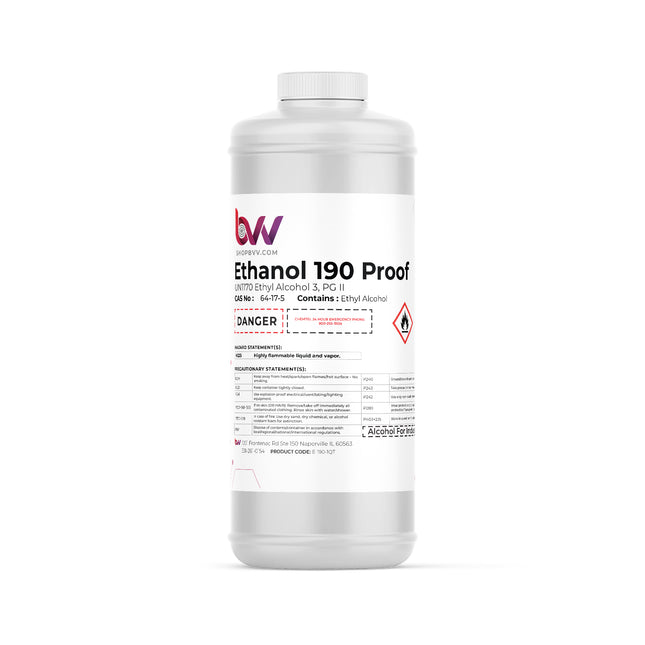
BVV™ Food & Lab Grade 190 Proof Ethanol
BVV™ Food & Lab Grade 190 Proof Ethanol EXCISE TAX INCLUDED IN PRICING. HAZMAT ITEMS ARE NON-REFUNDABLE. ALL SALES ARE FINAL BVV™ Food Grade Ethanol 190 Proof, This product is the highest purity possible for extraction grade ethanol on the market, at 95% pure. Provides unmatched purity while performing extractions for crude oil or even cleaning equipment. 190 Proof Ethanol is a great choice when processing oil for short path distillation processes because it can be immediately winterized, filtered, and then rotary evaporated to recover the ethanol for later usage. NOTE : *USP and Kosher certified 190 proof available upon request. *Disclaimer(s): 1 Quart Bottles are exempt from additional Hazmat shipping charges and can ship immediately, Less paperwork for shipping is required for shipping only 1 single bottle per order. Spigots/Faucets are only compatible with 5 Gallon Plastic Jugs and must be purchased separately Trigger Sprayer is only compatible with 1QT and 1 Gallon sizes Prices may vary due to current market value Totes do not transfer certifications from 55 Gallon Drums. Technical Data: BVV™ 190 Proof SDS BVV™ 190 Proof COA A copy of your unexpired DRIVERS LICENSE, STATE ID CARD, or US PASSPORT and your completed and signed END-USER STATEMENT must be received before we ship out your order. End Users Agreement Chemical Formula: C2H6O Molecular Weight: 46.069 CAS Registry Number: 64-17-5 Appearance Colorless Liquid Odor: wine-like, pungent Density 0.78945 g/cm3 @ 20 °C Boiling Point: 78.23C/172.81F Solubility in water: Miscible GHS Pictograms: GHS Signal Word: Danger GHS Hazard Statements: H225, H319, H360D GHS Precautionary Statements P210, P233, P240, P241, P242, P305+P351+P338 UN Identification Number: 1170 Proper Shipping Name: Ethanol Solution Transport Hazard Class: 3 Packing Group: II DOT Placard: Federal & State Law Requirements You must be the age of 21 or over to purchase this ethanol product. All Alcohol and Tobacco Tax Trade Bureau (TTB), federal, state and local laws must be complied with, and you may be required to provide BVV™ with your state or federal license even when purchasing products that require a federal excise tax payment. (Note: Container style and color may vary)
$20.00 - $5,200.00
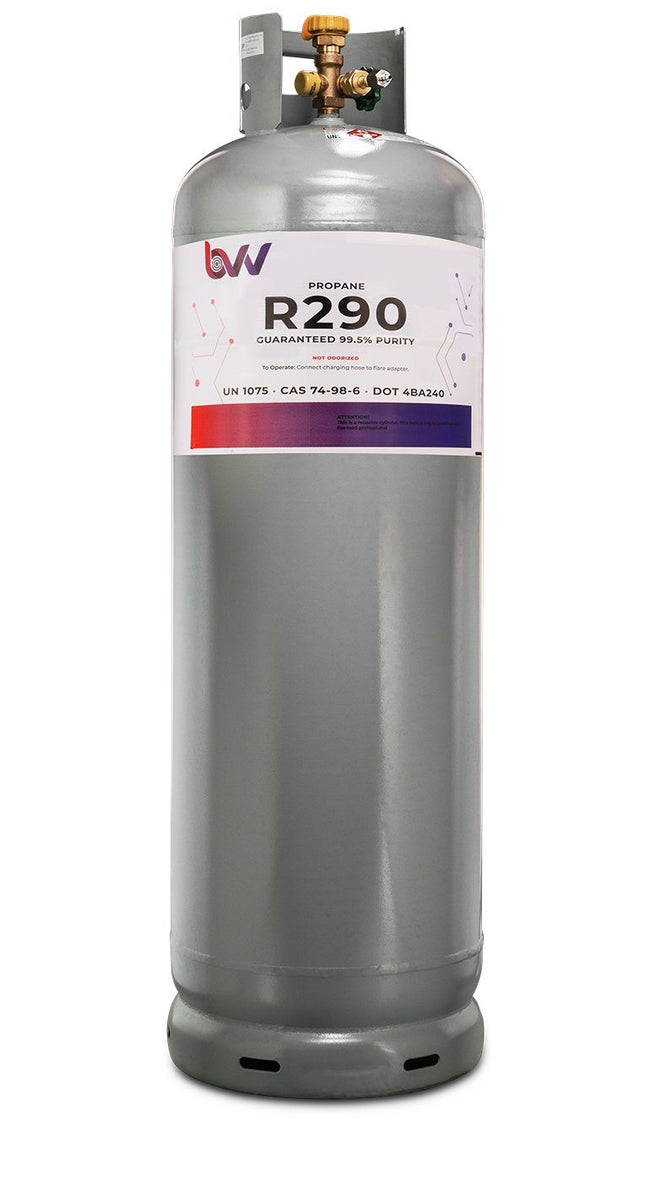
120LB DIPTUBE Tank High Purity USA PROPANE R290 - 99.5% Guaranteed
120LB DIPTUBE Tank High Purity USA PROPANE R290 DIPTUBE- 99.5% Guaranteed DISCLAIMER(S): This unit is intended for LEGAL purposes only, to be used in accordance with local laws and ordinances. Use only in WELL VENTILATED AREAS! Notice: This item will ship via Freight ONLY. BVV™ always recommends distillation of every solvent before use. Tank does not include CGA 555 fitting. Must be added through dropdown or bought separately. California now prohibits the retail sale of any Non-Odorized butane in quantities larger than 150ml. If you are not a retail purchaser you can call in to place an order. Permitted Sales Include the Following: Medical Collectives or Cooperatives operating under CA Health & Safety Code Section 11362.775 Persons licensed to perform volatile solvent extraction activity under CA Bus & Prof Code Division 10 Manufacturers, wholesalers, resellers, or retailers solely for the purpose of resale High purity Propane is USA sourced, and guaranteed to be 99.5% pure. This instrument grade solvent helps to produce a higher quality extract by reducing mystery oils and contaminants. Solvent comes in a DOT refillable LP tank. Lot Analysis: Propane: 99.5% + Methane: <1ppm Ethane: 3ppm Isobutane: 2380ppm n-Butane: 251ppm Propylene: <5ppm Isopentane: <1ppm Water: <3ppm Sulfer: <1ppm *Free of any hydrogen Sulphide based Ethyl Mercaptan Odorants. *This product is clean, colorless and odorless. *This tank has a diptube. *Actual Propane liquid weight is 100LB Due to FAA regulations, solvent tanks cannot be safely transported via means other than ground. Any order that has solvent will not be shipped in an expedited fashion. If an order with solvent is combined with any other items and chosen to be expedited, that entire order will ship via UPS Ground/Freight. We will not split up any orders and ship them separately. If a customer is wanting to expedite specific items and order solvent, 2 separate orders (1 for the solvent and 1 for the expedited items) will need to be placed in order to do so. Solvents do not ship to Hawaii, Puerto Rico, or any other US Territory outside of the contiguous 48 States. Shipping Solvent to Alaska may ONLY ship via freight and will be required to travel through Canada. We have this policy in place to ensure safety when transporting solvents, and to prevent any issue with shipping times for our customers.
$795.00 - $809.00
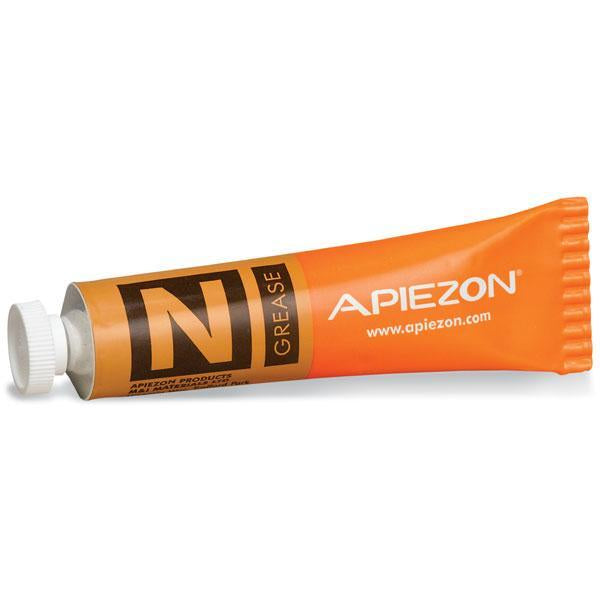
Apiezon N Cryogenic Vacuum Grease
Apiezon N Cryogenic Vacuum Grease Apiezon N Grease is silicone-free and widely recognised and recommended as the cryogenic vacuum grease of choice. This cryogenic grease is specially formulated to exhibit craze-free performance characteristics at low temperatures and withstand frequent cycling between cryogenic temperatures as low as -273°C and +30°C. Safety Data Sheet Thermal Conductance Sheet Technical Data Sheet Apiezon N Grease: Cryogenic High Vacuum Grease Properties Apiezon N Grease is a silicone- and halogen-free cryogenic high vacuum grease which: can withstand frequent cycling between cryogenic temperatures as low as -273°C and +30°C is craze-free at cryogenic temperatures has the ability to fill the micropores of adjoining surfaces, so improve thermal contact does not suffer from contamination problems associated with silicone based greases such as 'creep' or 'carry over' exhibits a vapour pressure of 6 x 10-10 Torr at 20°C has powerful 'gettering' action, meaning it absorbs potentially harmful grease and chemical impurities on metal and glass surfaces is easy to clean, use and remove as it is soluble in hydrocarbon solvents Please click the links for typical properties and vapour pressure graphs of Apiezon N Grease. Cryogenic Applications of Apiezon N Grease Cryogenic Vacuum Seal Apiezon N Grease exhibits extremely low vapour pressures at ambient temperatures, 6 x 10-10 torr at 20°C, which are further improved by reductions in temperature to the cryogenic region. Its ability to resist cracking at extremely low temperatures makes it particularly useful as a vacuum seal for cryosystems. Apiezon N Grease can be relied upon to form and maintain a vacuum seal for long periods, even when subjected to frequent thermal cycling, withstanding cycling between temperatures as extreme as -273°C and +30°C. Its unique properties mean N Grease is widely used to create a reliable vacuum and pressure-tight seals in, amongst others: vacuum lines; Schlenk lines; cold traps; liquid helium hoses and electron microscopes. Thermal Coupling Apiezon N Grease has a proven track record in improving thermal contact under cryogenic conditions. This is important for the coupling of cooling systems to superconducting magnets, cryostats, temperature sensors or any system that is required to reach cryogenic temperatures as quickly as possible. Low levels of magnetic susceptibility also make it ideal for superconductor manufacturing applications. Sensor Mounting Apiezon N Grease is ideal for use in cryogenic sensor mounting. It is pliable at room temperature and solidifies at cryogenic temperatures to allow for easy mounting and removal of sensors without causing damage. Sample Mounting Important in low-temperature testing of semiconductor chips, laser diodes and crystals, etc., Apiezon N Grease is used to improve thermal contact between the sample boat and cold finger of a cryotstat. This cryogenic thermal contact grease ensures that samples are at the lowest possible temperatures to improve test sensitivities. Ambient Temperature Applications - Added Cushioning Apiezon N Grease can be used in a variety of applications at ambient temperatures such as when added cushioning is required. N Grease has a special additive which gives it a tenacious, rubbery consistency which absorbs vibrations in equipment, making N Grease invaluable in fragile glass to glass joints, like burette taps, which continually risk fracture.
$218.00
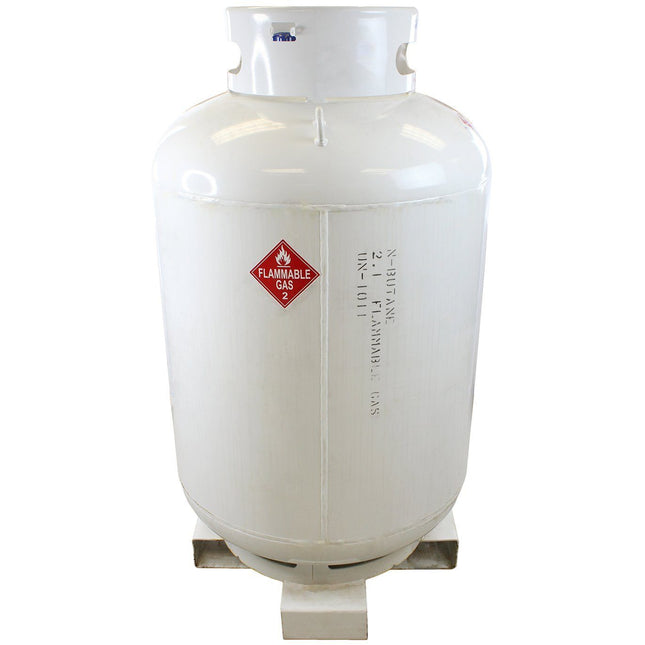
Half Ton - High Purity USA N-BUTANE - 99.5% Guaranteed
DISCLAIMER(S): This unit is intended for LEGAL purposes only, to be used in accordance with local laws and ordinances. Use only in WELL VENTILATED AREAS! Notice: This item will ship via Freight ONLY This tank requires a CGA 510 fitting - Sold Separately BVV™ always recommends distillation of every solvent before use. *Actual liquid weight is 510LBs California now prohibits the retail sale of any Non-Odorized butane in quantities larger than 150ml. If you are not a retail purchaser you can call in to place an order. Permitted Sales Include the Following: Medical Collectives or Cooperatives operating under CA Health & Safety Code Section 11362.775 Persons licensed to perform volatile solvent extraction activity under CA Bus & Prof Code Division 10 Manufacturers, wholesalers, resellers, or retailers solely for the purpose of resale Sourced right here in the USA, this high-quality butane is guaranteed to be 99.5% pure. This is a solvent that is instrument-grade and helps produce a higher quality extract through the reduction of mystery oils and contaminants. This butane is clean, colorless, odorless, and free of any hydrogen sulfide-based ethyl mercaptan odorants. Because of this, a finer, higher quality extract is consistently available to our customers. The solvent comes in a DOT transpiration approved tank with liquid withdrawal valve (Diptube). Lot Analysis: Isobutane: <1500ppm Methane: <1ppm Ethane: <10ppm n-Butane: 99.5% + Propane: <500ppm Isopentane: <20ppm Water: <3ppm CO+CO2: <5ppm Oxygen: <3ppm Nitrogen: <10ppm Sulfer: Non-Detected *Free of any hydrogen Sulphide based Ethyl Mercaptan Odorants. *Holds the equivalent of (65) 10oz cans of butane. *This product is clean, colorless and odorless. *Actual N-butane liquid weight is 510LB Due to FAA regulations, solvent tanks cannot be safely transported via means other than ground. Any order that has solvent will not be shipped in an expedited fashion. If an order with solvent is combined with any other items and chosen to be expedited, that entire order will ship via UPS Ground/Freight. We will not split up any orders and ship them separately. If a customer is wanting to expedite specific items and order solvent, 2 separate orders (1 for the solvent and 1 for the expedited items) will need to be placed in order to do so. Solvents do not ship to Hawaii, Puerto Rico, or any other US Territory outside of the contiguous 48 States. Shipping Solvent to Alaska may ONLY ship via freight and will be required to travel through Canada. We have this policy in place to ensure safety when transporting solvents, and to prevent any issue with shipping times for our customers.
$2,999.00
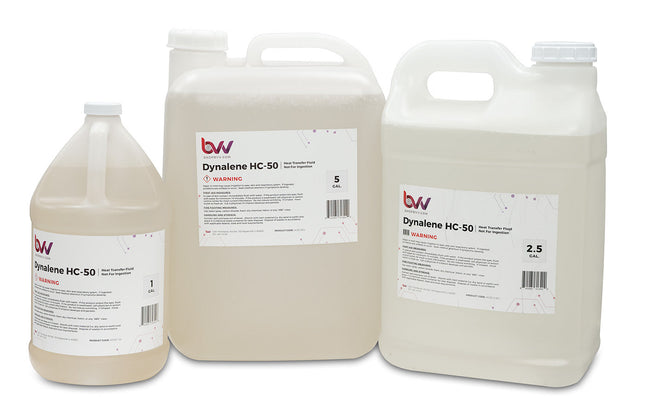
Dynalene HC-50
Dynalene HC-50 Dynalene HC/Potassium Formate is a water-based, low-temperature heat transfer fluid engineered to deliver the excellent heat transfer performance in applications down to -58°F (-50°C). With the temperature range -50°C to +218°C, Dynalene HC easily exceeds the performance of other water-based chemistries such as glycol /water mixtures, calcium chloride/water as well as hydrocarbon and silicone-based fluids. The fluid comes in five concentrations and is non-toxic, non-hazardous and non-flammable. Effective Calcium Chloride Alternative Dynalene HC/Potassium Formate heat transfer fluid is an excellent alternative to calcium chloride and other brine solutions because it demonstrates a higher thermal efficiency and lower corrosion rate. This fluid, as compared to other glycols, calcium chloride, and other brine solutions, should lower the leak and spillage rate, and reduce maintenance and repair costs on refrigerated systems. This is due to Dynalene HC's use of "safe" chemistries resulting in a high level of corrosion inhibition. The viscosity of calcium chloride solutions is also noticeably higher than Dynalene HC heat transfer fluid, which in turn makes Dynalene HC a more thermally efficient solution. Key Features: 100% Biodegradeable Non-Toxic Non-flammable Aqueous-Based Superior heat transfer characteristics Attractive alternative to glycols and brines Applications: Pharmaceutical process Food and beverage Chemical process Climatic Chamber LPG Processing Low-Temperature Baths Temperature Range: Open systems: HC-50: -51°C (-60°F) to 110°C (230°F)Closed Systems: HC-50: -50°C (-58°F) to 218°C (425°F) Technical Data Sheet MSDS Engineering Guide
$115.00 - $2,900.00
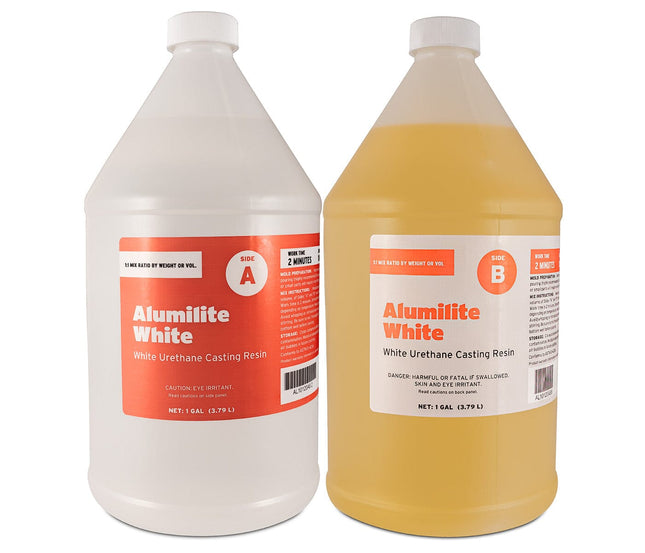
Alumilite White 2 gal.
Alumilite White (also known and sold as Amazing Casting Resin) is an easy to use white urethane resin that creates a durable casting with perfect cosmetics and intricate details. Transitions from clear to opaque white when curing Easily dyed or painted Technical Data Sheet Safet Data Sheet TECHNICAL SPECIFICATIONS Product: Alumilite White Color: White Mix Ratio: 1:1 by weight or volume Pot Life: 2 minutes Demold Time (100 gram mass): 5-10 minutes Mixed Viscosity (cps): 90 Specific Gravity: 1.05 Shore Hardness (ASTM D2240): 72 D Shrinkage (in./in.): .006 Tensile Strength (ASTM D638, psi): 4500 Elongation (in./in.): 10% Temperature Resistance: 185º F
$120.00
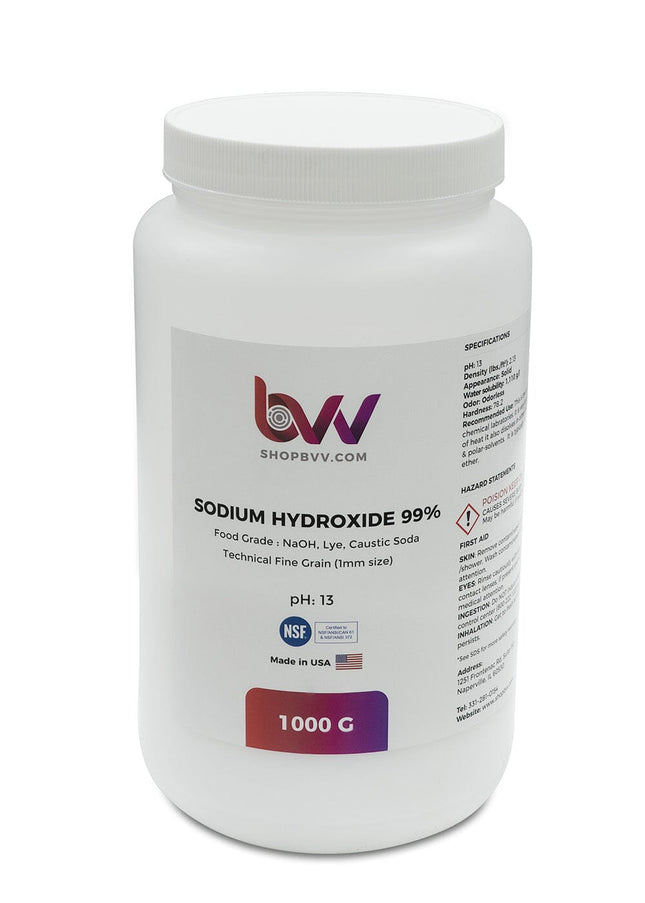
BVV™ High Purity Sodium Hydroxide 99% (Food Safe Chemical)
BVV™ High Purity Sodium Hydroxide 99% NSF Certified (Food Safe Chemical) Sodium Hydroxide is a highly versatile compound that finds extensive use in various applications, including acid-base extractions. As a strong base, Sodium Hydroxide is used to adjust the pH of aqueous solutions, making it an ideal choice for separating acidic and basic compounds during extraction. Also known as caustic soda, Sodium Hydroxide is a highly alkaline compound that is used in a wide range of applications beyond extraction including manufacturing, cleaning, and water treatment. At BVV, we pride ourselves on offering only the highest-quality chemicals and compounds, including Sodium Hydroxide. Our Sodium Hydroxide is a premium-grade product that is manufactured to the highest standards, ensuring exceptional quality and performance for your pH adjustment needs. Our Sodium Hydroxide is NSF certified as a food safe chemical, which means it can be used in a variety of applications including drinking water and is evaluated safe for consumption.Our product is available in a range of sizes and quantities to suit your needs, and our team is always on hand to provide expert advice and support. High Purity Sodium Hydroxide Safety Data Sheet SDS High Purity Sodium Hydroxide Certificate of Analysis COA Chemical Formula: NaOH Molecular Weight: 39.9971 g/mol CAS Registry Number: 1310-73-2 Appearance White, hard (when pure), opaque crystals Odor: Odorless Density 2.13 g/cm3 Boiling Point: 1388°C / 2530°F Solubility in water: 418 g/L (0 °C)1000 g/L (25 °C)3370 g/L (100 °C) GHS Pictograms: GHS Signal Word: Danger GHS Hazard Statements: H290, H302, H314 GHS Precautionary Statements P280, P305+P351+P338, P310 UN Identification Number: 1823 Proper Shipping Name: Sodium Hydroxide, solid Transport Hazard Class: 8 Packing Group: II DOT Placard: What Is Sodium Hydroxide? Sodium hydroxide, commonly known as lye or caustic soda, is a highly versatile and strong alkaline compound. It is represented by the chemical formula NaOH and consists of one sodium (Na+) ion, one hydrogen (H+) ion, and one hydroxide (OH-) ion. Sodium hydroxide is a white, odorless solid at room temperature and is highly soluble in water, producing a highly alkaline solution. It is widely used in various industries and applications, including manufacturing, chemical processes, cleaning agents, soap production, food processing, and more. What Is Sodium Hydroxide Used For? Sodium hydroxide (NaOH), commonly known as caustic soda or lye, has a wide range of industrial, commercial, and household uses due to its strong alkaline properties. Some of the common uses of sodium hydroxide include: Chemical Manufacturing: Sodium hydroxide is a key component in the production of various chemicals, including detergents, soaps, textiles, paper, and synthetic materials. Soap and Detergent Production: It is used in the saponification process to make soap and is also a crucial ingredient in many household and industrial cleaning products. Food Processing: Sodium hydroxide is used to process and refine certain foods, such as in the preparation of olives, cocoa, and chocolate. It is also used for peeling fruits and vegetables. Water Treatment: In water treatment, sodium hydroxide is used to adjust pH levels, remove acidity, and precipitate metals from wastewater. Petroleum Industry: It is used in refining petroleum products, including the removal of impurities from crude oil. Aluminum Production: Sodium hydroxide is employed in the extraction of alumina from bauxite ore and as an electrolyte in the aluminum extraction process. Pulp and Paper Industry: It is used in the pulping and bleaching processes of paper manufacturing. Textile Industry: Sodium hydroxide is utilized to process and dye textiles and fabrics. Pharmaceuticals: It is used in the manufacture of certain drugs and pharmaceutical products. Biodiesel Production: Sodium hydroxide is used as a catalyst in the transesterification process to produce biodiesel from vegetable oils or animal fats. Hydrogen Production: Sodium hydroxide is used to produce hydrogen gas through the electrolysis of water. Cleaning and Degreasing: It is used as a strong cleaning agent for surfaces, equipment, and industrial machinery due to its ability to dissolve oils, fats, and grease. Drain Cleaning: Sodium hydroxide-based drain cleaners are used to unclog and clean drains. pH Adjustment: In laboratories and industrial processes, sodium hydroxide is used to adjust the pH of solutions. It's important to note that sodium hydroxide is a highly caustic and reactive substance, and its use should be handled with care and appropriate safety measures. Is Sodium Hydroxide Lye? Yes, sodium hydroxide is commonly known as lye. Lye is a strong alkaline substance that is often used in various industrial, commercial, and household applications, as mentioned earlier. It is important to handle sodium hydroxide with caution, as it can cause severe burns and irritation if it comes into contact with skin or eyes. Proper safety measures should be taken when working with sodium hydroxide or lye. Are Sodium Hydroxide and Caustic Soda The Same Thing? Yes, sodium hydroxide and caustic soda are the same thing. Caustic soda is a common name for sodium hydroxide, which is a strong alkaline chemical compound. Both terms refer to the same chemical substance with the chemical formula NaOH. It is used in various industrial, commercial, and household applications, including cleaning, manufacturing, and chemical processes. What Is Sodium Hydroxide Structure? Sodium hydroxide (NaOH) has a simple molecular structure consisting of one sodium (Na) atom, one oxygen (O) atom, and one hydrogen (H) atom. The structure of sodium hydroxide can be visualized as follows: In this structure, the sodium atom (Na) is bonded to the oxygen atom (O) through an ionic bond, and the oxygen atom is bonded to the hydrogen atom (H) through a covalent bond. The hydroxide ion (OH-) is formed by the combination of the oxygen and hydrogen atoms, and it is the key component that gives sodium hydroxide its strong alkaline properties. What Is The pH of Sodium Hydroxide? The pH of sodium hydroxide (NaOH) is very high and strongly alkaline. Sodium hydroxide is a strong base and is commonly used to raise the pH of solutions. In its pure form, sodium hydroxide has a pH of approximately 14, which is the highest value on the pH scale. When dissolved in water, it dissociates into hydroxide ions (OH-) and sodium ions (Na+), resulting in a highly alkaline solution with a pH greater than 14. The exact pH of a sodium hydroxide solution will depend on its concentration and the amount dissolved in the solventWhat Are The Hazards of Sodium Hydroxide? Is Sodium Hydroxide A Weak or Strong Base? Sodium hydroxide (NaOH) is considered a strong base. It is highly soluble in water and dissociates completely into sodium ions (Na+) and hydroxide ions (OH-) when dissolved. This complete dissociation results in a high concentration of hydroxide ions in the solution, making sodium hydroxide a strong and effective source of hydroxide ions for chemical reactions. Strong bases like sodium hydroxide have a high tendency to accept protons (H+) from other substances, leading to the characteristic properties of strong bases, such as high alkalinity and the ability to neutralize acids.What Is Sodium Hydroxide? What Are The Hazards of Sodium Hydroxide? Sodium hydroxide (NaOH) is a caustic and highly reactive compound, and its use should be handled with care due to the following hazards: Corrosive to Skin and Tissues: Sodium hydroxide is highly corrosive and can cause severe burns upon contact with the skin, eyes, and mucous membranes. It can damage and destroy living tissue upon contact, leading to chemical burns and tissue damage. Inhalation Hazard: Inhaling sodium hydroxide dust, fumes, or mists can irritate the respiratory tract and cause coughing, shortness of breath, and lung irritation. Prolonged exposure to airborne sodium hydroxide particles can lead to more serious respiratory effects. Eye Irritation: Contact with sodium hydroxide can cause irritation, redness, and damage to the eyes. Severe exposure can lead to permanent eye damage or blindness if not promptly treated. Reactivity: Sodium hydroxide is highly reactive and can react violently with certain substances, especially acids. Mixing sodium hydroxide with acids can result in rapid heat generation, spattering, and potentially explosive reactions. Environmental Impact: Sodium hydroxide is harmful to aquatic life and can lead to water pollution if released into the environment. It is important to properly dispose of sodium hydroxide-containing solutions and prevent their release into water systems. Corrosion of Materials: Sodium hydroxide can corrode metals and other materials, causing structural damage and weakening of containers, pipes, and equipment. Toxicity: Ingesting sodium hydroxide can cause severe internal burns, damage to the digestive system, and even death. Ingestion can lead to life-threatening medical emergencies and requires immediate medical attention. To mitigate these hazards, it is essential to handle sodium hydroxide with proper protective equipment, such as gloves, goggles, and lab coats, in a well-ventilated area. Proper storage, labeling, and disposal procedures should also be followed to prevent accidents and environmental contamination. How Do I Use Sodium Hydroxide Safely? Sodium hydroxide, also known as caustic soda or lye, is a highly caustic and potentially dangerous chemical. It's essential to handle and use it safely to prevent accidents or injuries. Here are guidelines for safely using sodium hydroxide: Protective Equipment: Wear appropriate personal protective equipment (PPE), including chemical-resistant gloves, safety goggles or a full-face shield, a lab coat or chemical-resistant apron, and closed-toe shoes with chemical-resistant soles. Work in a Controlled Environment: Work in a well-ventilated area, such as a fume hood, to minimize exposure to fumes. Adequate ventilation helps disperse any fumes produced during handling. Avoid Skin Contact: In case of skin contact, immediately flush the affected area with plenty of water for at least 15 minutes. Remove contaminated clothing and seek medical attention if irritation or burns occur. Prevent Eye Contact: Wear chemical-resistant safety goggles or a full-face shield to protect your eyes from splashes. If sodium hydroxide comes into contact with your eyes, rinse them immediately with water for at least 15 minutes and seek medical attention. Use Appropriate Containers: Use containers made of materials that are compatible with sodium hydroxide, such as glass or certain types of plastic. Avoid using aluminum or reactive metals. Dilution Procedure: When diluting sodium hydroxide in water, always add the chemical to the water, not the other way around. Stir gently while adding to prevent splashing. Label Containers: Properly label containers holding sodium hydroxide solutions with appropriate hazard warnings and information. Handling Crystals or Pellets: Handle sodium hydroxide crystals or pellets with dry hands or appropriate gloves to avoid skin contact. Always use tools (e.g., scoops or spatulas) to handle solid sodium hydroxide. Do Not Inhale Fumes: Avoid inhaling sodium hydroxide fumes. Work in a well-ventilated area, and if working with large quantities or generating fumes, use a fume hood or wear a chemical-resistant mask with appropriate filters. Emergency Equipment: Have access to emergency equipment, such as eye wash stations and safety showers, in case of accidental exposure. Know the location of fire extinguishers and fire alarm systems. Spill Response: In case of a sodium hydroxide spill, follow your organization's spill response procedures. Typically, this involves containing the spill, neutralizing with an acid if appropriate, and safely cleaning it up. Storage: Store sodium hydroxide in a cool, dry, well-ventilated area, away from incompatible substances (e.g., acids, organic materials). Keep containers tightly closed when not in use. Dispose of Waste Properly: Dispose of sodium hydroxide waste in accordance with local, state, and federal regulations. It is considered hazardous waste and should be handled and disposed of as such. Training and Knowledge: Ensure that personnel working with sodium hydroxide are adequately trained in its safe handling, storage, and disposal. Training should include hazard recognition, first aid procedures, and emergency response protocols. First Aid: Familiarize yourself with the appropriate first aid measures for sodium hydroxide exposure, including how to treat skin contact, eye exposure, and ingestion. Medical Monitoring: If workers are regularly exposed to sodium hydroxide, consider implementing a medical monitoring program to track their health and detect early signs of exposure-related issues. Always follow the safety guidelines and procedures established by your organization or regulatory authorities when working with sodium hydroxide. Remember that sodium hydroxide is a highly caustic substance, and improper handling can result in severe burns or other injuries. Prioritize safety and take appropriate precautions to protect yourself and others from potential hazards associated with sodium hydroxide.
$14.00 - $1,350.00
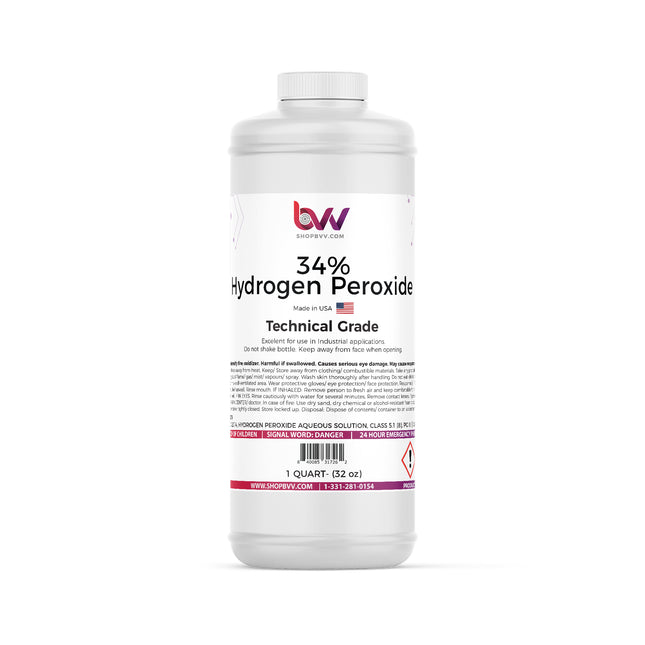
34% Hydrogen Peroxide Technical Industrial Grade, Oxygenator
34% Technical Industrial Grade Hydrogen Peroxide Our Technical-grade 34% peroxide tests at 34.1%. Technical is also what is referred to as Industrial grade. Our peroxide is clear, colorless, and free of any stabilizers or additives. Peroxide is one of the most effective oxidizers and may be applied to food directly to food products. Our peroxide is certified FCC (Food Chemical Codex). It has been tested and verified for its quality and purity. 34% Food Grade Hydrogen Peroxide Certificate of Analysis 34% Food Grade Hydrogen Peroxide Safety Data Sheet Our 34% hydrogen peroxide when diluted you can make a remarkably large volume of 3% hydrogen peroxide that can be used for a wide variety of applications. 1 Quart 34% Makes 4.36 Gallons of 3% 1 Gallon 34% Makes 11.37 Gallons of 3% 5 Gallon 34% Makes 56.83 Gallons of 3% 55 Gallon 34% Makes 625.17 Gallons of 3% Some applications include... Elevating Plant Growth: Diluted hydrogen peroxide supports healthy roots and elevated oxygen availability in the soil. Excellent Cleaner for Food Prep Environments: Hydrogen peroxide is a disinfectant, that kills viruses and various forms of bacteria. Bleaching: Diluted hydrogen peroxide is a mild bleaching agent that can be used to clean stains. Cleansing Fresh Produce: Diluted hydrogen peroxide can be used to clean fruits and vegetables. Mold and Mildew Removal: Hydrogen peroxides strong oxidative qualities breakdown mold and mildew with ease. How to Dilute 34% Hydrogen Peroxide to 3% Hydrogen Peroxide: 34% food-grade hydrogen peroxide Deionized distilled water A clean, empty Gallon bottle for the final 3% hydrogen peroxide solution Measuring cup Funnel Safety goggles Rubber gloves Apron or old clothes Steps to perform dilution: Wear safety goggles, rubber gloves, an apron or old clothing to protect yourself from spills and splashes. Choose a well-ventilated space. Mix 1 part 34.1% hydrogen peroxide with 10 parts distilled water. Example: Mix 1 cup hydrogen peroxide, with 10 cups of distilled water. To be exact, this will make slightly more than 3% solution of hydrogen peroxide – 3.10%. What Is Hydrogen Peroxide? Hydrogen peroxide (H2O2) is a chemical compound composed of two hydrogen atoms and two oxygen atoms. It is a clear, colorless liquid with a slightly more viscous consistency than water. Hydrogen peroxide is commonly used for its powerful oxidizing properties and has a wide range of applications in various industries and household settings. What Are The Properties Of Hydrogen Peroxide? Hydrogen peroxide (H2O2) is a clear, colorless liquid with several notable properties: Chemical Formula: H2O2 - It consists of two hydrogen atoms (H) and two oxygen atoms (O) linked by a single covalent bond, as well as a second oxygen atom connected to one of the hydrogen atoms by a single covalent bond. Molecular Weight: Approximately 34.01 grams per mole. Physical State: Hydrogen peroxide is a liquid at room temperature and pressure (25°C or 77°F). Odor: It has a slightly sharp and distinctive odor. Solubility: Hydrogen peroxide is miscible (mixes completely) with water in all proportions. Density: The density of hydrogen peroxide varies with concentration. A common concentration of 3% hydrogen peroxide has a density of approximately 1.01 grams per milliliter (g/mL). Boiling Point: The boiling point of hydrogen peroxide is approximately 150.2°C (302.4°F). Melting Point: Pure hydrogen peroxide does not have a distinct melting point because it decomposes before reaching a stable liquid state at atmospheric pressure. Reactivity: Hydrogen peroxide is a powerful oxidizing agent and is highly reactive with various substances, including organic compounds and some metals. It readily decomposes into water and oxygen when exposed to heat, light, or certain catalysts. Concentration: Hydrogen peroxide is available in various concentrations, with common household solutions typically being around 3%. Higher concentrations, such as 30% or 35%, are used in industrial and laboratory applications. pH: The pH of hydrogen peroxide solutions varies with concentration but is typically slightly acidic. Stability: Hydrogen peroxide solutions are not indefinitely stable and can decompose over time, especially when exposed to light, heat, or contaminants. Storing hydrogen peroxide in a cool, dark place in a well-sealed container helps preserve its stability. Safety: Concentrated hydrogen peroxide solutions can be hazardous and should be handled with care. Contact with skin or eyes should be avoided, and protective equipment may be required when working with high-concentration solutions. These properties make hydrogen peroxide a versatile chemical with various applications in industries ranging from healthcare and cosmetics to water treatment and rocket propulsion. The concentration and handling precautions should be considered based on the specific use and requirements of the application. What Is Hydrogen Peroxide Used For? Hydrogen peroxide (H2O2) is used for a wide range of purposes in various industries and household settings due to its versatile properties. Some common uses of hydrogen peroxide include: Disinfectant and Antiseptic: Hydrogen peroxide is a common disinfectant and antiseptic agent. It is used to clean wounds, cuts, and minor injuries to prevent infection. In lower concentrations (typically 3%), it can be safely applied to the skin. Hair Bleaching and Dyeing: Many hair bleaching and hair dyeing products contain hydrogen peroxide as it can help break down the natural pigments in hair, lightening its color. Teeth Whitening: Hydrogen peroxide is used in some teeth whitening products and dental treatments to remove stains and discoloration from teeth. Cleaning Agent: It is used as a cleaning agent for surfaces, fabrics, and contact lenses due to its ability to break down and remove organic stains and deposits. Water Treatment: In water treatment processes, hydrogen peroxide can be used to remove contaminants, oxidize organic matter, and disinfect water supplies. Rocket Propellant: In the aerospace industry, highly concentrated hydrogen peroxide (usually around 90% purity) is used as a rocket propellant. Chemical Synthesis: Hydrogen peroxide is used in the synthesis of various chemicals and pharmaceuticals. Environmental Applications: It can be employed for soil and groundwater remediation, helping to break down pollutants and contaminants. Food Industry: In the food industry, hydrogen peroxide can be used for cleaning and disinfection of equipment and packaging materials. Cosmetics: It is used in some cosmetic and personal care products, such as hair dyes, hair bleaches, and skin creams. Textiles: Hydrogen peroxide is used in the textile industry to bleach fabrics and remove stains. Paper and Pulp Industry: It is used for bleaching paper pulp and improving the quality of paper products. Agriculture: In agriculture, hydrogen peroxide can be used as an oxygen source in soil, promoting plant growth. Medical and Laboratory Use: It is utilized for cleaning and sterilizing medical equipment and laboratory instruments. First Aid: Hydrogen peroxide is a household item for treating minor cuts and scrapes. The specific application and concentration of hydrogen peroxide used can vary depending on the intended purpose. Higher concentrations are typically used in industrial and chemical applications, while lower concentrations are common in household and personal care products. It's important to handle hydrogen peroxide with care, follow safety guidelines, and use the appropriate concentration for a given task. How Is Hydrogen Peroxide Produced? Hydrogen peroxide (H2O2) is typically produced through one of two main methods: the anthraquinone process and the direct synthesis process. Both processes involve the reaction of hydrogen and oxygen in the presence of a catalyst to form hydrogen peroxide. Here's an overview of these two methods: Anthraquinone Process: This is the most common method for commercial hydrogen peroxide production. It involves a series of chemical reactions that use anthraquinone derivatives as catalysts. The process typically consists of the following steps: Hydrogenation: Anthraquinone derivatives are hydrogenated with hydrogen gas (H2) to form hydroquinone derivatives. Autoxidation: The hydroquinone derivatives react with oxygen (O2) to form anthraquinone derivatives again, while producing hydrogen peroxide in the process. Extraction: The hydrogen peroxide is then extracted from the reaction mixture. Oxidation of Anthraquinone: The anthraquinone derivatives are oxidized back to their original form for reuse in the process. Direct Synthesis Process: In this method, hydrogen and oxygen are directly combined to produce hydrogen peroxide using a catalyst. The reaction typically occurs in a gas-phase reactor, and the process is often referred to as the "direct synthesis" or "hydrogenation-oxygenation" process. Common catalysts used in this process include palladium or platinum on a support material. While these are the main methods for hydrogen peroxide production, there are other less common methods as well. The choice of production method depends on factors such as the desired concentration of hydrogen peroxide, production scale, and cost considerations. It's worth noting that hydrogen peroxide is a sensitive compound and can decompose over time, especially when exposed to heat, light, or contaminants. Therefore, it requires careful handling and storage to maintain its stability and effectiveness. Does Hydrogen Peroxide Expire? Hydrogen peroxide can degrade over time and may lose its effectiveness, so it can be said to have a shelf life rather than a strict expiration date. The shelf life of hydrogen peroxide depends on several factors, including its concentration, exposure to light, temperature, and how well it's stored. Here are some general guidelines: Concentration: Higher concentrations of hydrogen peroxide (e.g., 30% or 35%) tend to be more stable and have a longer shelf life compared to lower concentrations (e.g., 3% or 6%). Exposure to Light: Hydrogen peroxide is light-sensitive, and exposure to ultraviolet (UV) light can accelerate its decomposition. It is typically sold in brown or opaque containers to protect it from light. Temperature: Storage at higher temperatures can also speed up the decomposition of hydrogen peroxide. It should be stored at a cool, dry place away from heat sources. Contaminants: Contaminants or impurities can catalyze the decomposition of hydrogen peroxide. It's essential to keep the container tightly sealed and free from any potential contaminants. Age: Hydrogen peroxide degrades slowly over time, even when stored correctly. The rate of degradation is higher for lower concentrations. To maximize the shelf life and potency of hydrogen peroxide, follow these recommendations: Store it in its original, tightly sealed container. Keep it in a cool, dark place away from direct sunlight and heat sources. Check the expiration date on the container, if available. If you're unsure about the potency of an old bottle of hydrogen peroxide, consider testing it on a small, non-critical area before using it for medical or cleaning purposes. It's important to note that even if hydrogen peroxide has degraded, it may still be useful for some applications, such as cleaning and disinfecting surfaces. However, for medical or first-aid use, it's best to use hydrogen peroxide that is within its recommended shelf life to ensure its effectiveness. Is Hydrogen Peroxide Safe As Mouthwash? Hydrogen peroxide can be used as a mouthwash, but it should be used with caution and in a diluted form. Here are some important considerations: Dilution: Never use undiluted hydrogen peroxide as a mouthwash. It's too concentrated at its full strength and can cause irritation, burning, and tissue damage. Instead, dilute it with water. A common recommendation is to use a 3% hydrogen peroxide solution, which is typically sold in drugstores. Frequency: Do not use hydrogen peroxide as a mouthwash too frequently. Using it daily or excessively can lead to oral issues, including irritation and disruption of the natural balance of oral bacteria. Duration: When using hydrogen peroxide as a mouthwash, swish it around your mouth for a brief period, typically about 30 seconds, and then spit it out. Do not swallow it. Rinse Thoroughly: After using hydrogen peroxide as a mouthwash, rinse your mouth thoroughly with water to remove any residual hydrogen peroxide. Avoid Ingestion: Do not swallow hydrogen peroxide, even when diluted. Swallowing hydrogen peroxide can lead to stomach upset and other health issues. Consultation: Before using hydrogen peroxide as a mouthwash, it's a good idea to consult with your dentist or oral healthcare provider. They can provide guidance on its safe and appropriate use based on your specific oral health needs. Hydrogen peroxide can help kill harmful bacteria in the mouth and may be used as a short-term remedy for issues like canker sores or minor gum irritations. However, it is not a substitute for regular oral hygiene practices such as brushing, flossing, and using a fluoride-based mouthwash. If you experience any adverse reactions, such as severe irritation, burning, or pain, discontinue use immediately and consult a healthcare professional. It's important to use hydrogen peroxide as a mouthwash cautiously and in accordance with recommended guidelines to avoid potential side effects or harm to oral tissues. What Are The Hazards Of Hydrogen Peroxide? Hydrogen peroxide, while commonly used for various purposes, can pose certain hazards if mishandled or used improperly. Here are some of the potential hazards associated with hydrogen peroxide: Irritation and Burns: Hydrogen peroxide is a strong oxidizing agent and can cause skin and eye irritation upon contact. In higher concentrations or with prolonged exposure, it can lead to chemical burns. Ingestion: Ingesting concentrated hydrogen peroxide can be harmful and even life-threatening. It can cause gastrointestinal irritation, stomach pain, vomiting, and, in severe cases, internal burns or damage. Inhalation: Inhalation of hydrogen peroxide vapors can irritate the respiratory tract, leading to coughing, shortness of breath, and throat irritation. Explosive Hazards: Concentrated hydrogen peroxide solutions can be sensitive to shock, heat, or contamination with organic materials. This can lead to the potential for explosions or fires if mishandled. Skin Sensitization: Prolonged or repeated contact with hydrogen peroxide can lead to skin sensitization, where the skin becomes more sensitive or allergic to the chemical. Environmental Impact: Hydrogen peroxide can be harmful to aquatic life and the environment if not properly disposed of. It should not be released into natural waterways. hydrogen peroxide, consider the following precautions: Dilution: When using hydrogen peroxide, dilute it to the appropriate concentration for the intended purpose. Most household hydrogen peroxide solutions are 3%, while higher concentrations are used for industrial or medical applications. Protective Equipment: When handling concentrated hydrogen peroxide, wear appropriate personal protective equipment, including gloves and safety goggles. Ventilation: Use hydrogen peroxide in well-ventilated areas to minimize inhalation risks. First Aid: In case of skin or eye contact, rinse immediately with plenty of water. If ingested, seek medical attention. Storage: Store hydrogen peroxide in a cool, dark place away from flammable materials and heat sources. Dispose Properly: Dispose of hydrogen peroxide in accordance with local regulations. Do not pour it down drains or release it into the environment. Always follow the safety guidelines and instructions provided on the product label or by the manufacturer. If you have specific concerns or questions about handling hydrogen peroxide for a particular application, it's advisable to consult with a safety professional or chemical expert for guidance. How Can I Use Hydrogen Peroxide Safely? Using hydrogen peroxide safely involves taking appropriate precautions to minimize the risk of accidents or harm. Here are some guidelines for safe handling and use of hydrogen peroxide: Read the Label: Always read and follow the instructions and safety precautions provided on the hydrogen peroxide product label. Different concentrations may have different recommended uses and safety guidelines. Personal Protective Equipment (PPE): Wear appropriate personal protective equipment, including safety goggles or a face shield to protect your eyes. Use gloves made of materials that are compatible with hydrogen peroxide, such as nitrile or latex gloves. Ventilation: Use hydrogen peroxide in a well-ventilated area to minimize exposure to vapors. If you're using it in a confined space, consider using a fume hood or working near an open window or door. Concentration: Ensure that you are using the correct concentration of hydrogen peroxide for your specific application. Most household hydrogen peroxide solutions are typically 3%, but higher concentrations are available for industrial or medical use. Dilution: When diluting concentrated hydrogen peroxide, always add the hydrogen peroxide to water, not the other way around. This helps prevent splattering and potential reactions. Avoid Contaminants: Keep hydrogen peroxide away from organic materials (e.g., paper, cloth) and flammable substances, as it can react with them and potentially cause fires or explosions. Avoid Mixing: Do not mix hydrogen peroxide with other chemicals unless you are following a specific recipe or procedure that requires it. Mixing hydrogen peroxide with certain substances can be dangerous. First Aid: In case of skin contact, immediately rinse the affected area with plenty of water. If hydrogen peroxide comes into contact with your eyes, flush them with water for at least 15 minutes and seek medical attention if irritation persists. If ingested, do not induce vomiting. Seek medical attention immediately. Storage: Store hydrogen peroxide in a cool, dark place, away from direct sunlight and heat sources. Keep the container tightly closed when not in use. Disposal: Dispose of hydrogen peroxide in accordance with local regulations. Do not pour it down drains or release it into the environment. Emergency Response: Have access to an emergency eyewash station and safety shower if you are working with concentrated hydrogen peroxide. Keep a spill kit and appropriate cleanup materials on hand in case of accidents. Training: Ensure that individuals handling hydrogen peroxide are trained in its safe use and understand the potential hazards. If you are unsure about how to use hydrogen peroxide safely for a specific application, consider seeking guidance from a safety professional or chemical expert. Always exercise caution and pr
$24.00 - $615.00
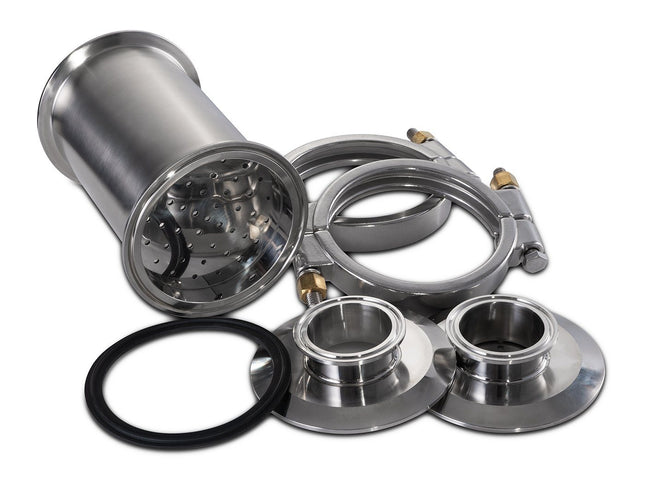
AFS 4" Tri-Clamp Inline Filter Housing for Disposable Color Remediation Cartridges
AFS Tri-Clamp Inline Filter Housing for Disposable Color Remediation Cartridges Note: Disposable cartridges sold separately. (Click Here for Cartridges) This inline housing allows for implementation of the AFS filters into many extraction systems. The AFS filter housing is 4" but comes with the adapter flanges for both ends to go inline with a standard 2" tri-clamp system. Kit Includes 2x 4" High Pressure Clamps 1x 4" Buna-N Gasket 2x Flat Reducers 4" to 2" Tri-Clamp 1x Cartridge Housing AFS Instruction Manual Download Here AFS SDS Sheet
$200.00 - $210.00
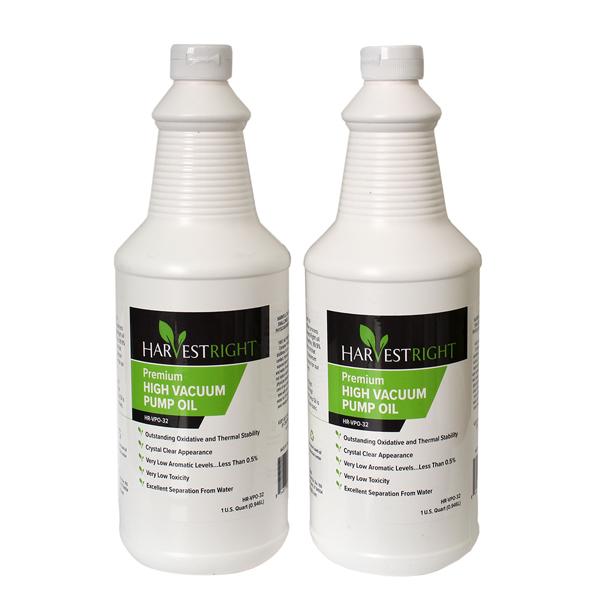
Harvest Right Vacuum Pump Oil (2-Pack)
Harvest Right Vacuum Pump Oil (2-Pack) What's Included: 2-pack of vacuum oil (1 quart each) Details: 2-pack Premium High Vacuum Pump Oil Pour-point depressant for easier cold weather starts and faster lubrication of critical wear surfaces. Anti-wear additives - Anti-foam additives - Oxidation inhibitors - Corrosion protection 1 U.S. Quart (0.946L) Vacuum pump oil may cause skin or eye irritation. In case of skin contact, thoroughly wash affected areas with soap and water. Seek medical attention if redness or irritation occurs. If swallowed, do not induce vomiting. Call a physician immediately. In case of eye contact, rinse eyes with water for 15 minutes and seek medical attention. KEEP OUT OF REACH OF CHILDREN This oil has cleaning additives that keep the pump cleaner. As a result, there can be an odor to the oil.
$31.00
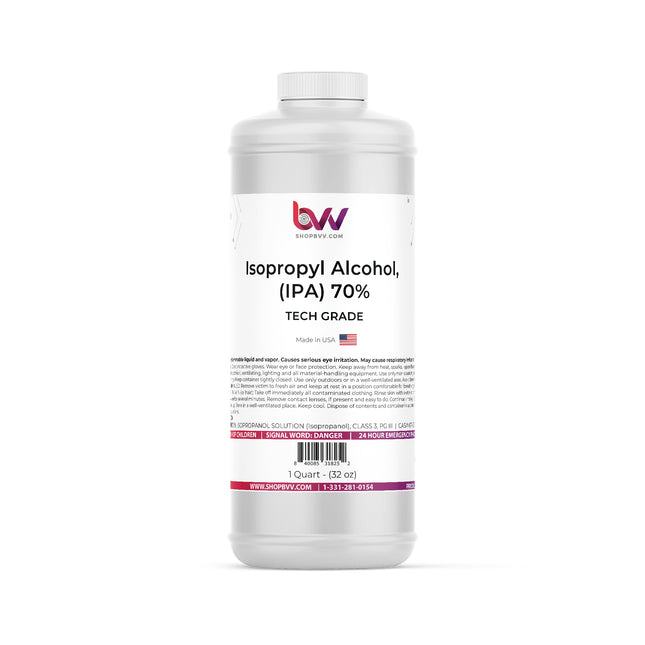
BVV Isopropyl Alcohol 70%
BVV™ Isopropyl Alcohol 70% Spigots/Faucets are only compatible with 5 Gallon Jugs and must be purchased separately Trigger Sprayer is only compatible with 1QT and 1 Gallon sizes Isopropyl alcohol is a fast-evaporating solvent and industrial cleaning agent, intended for industrial or professional use only. It can be used as a solvent for gums, shellac, and essential oils. Can be used as a fuel additive. Isopropyl Alcohol (liquid) - 70% Purity / 30% De-Ionized Water Shelf Life - 5 years Isopropyl Alcohol 70% Safety Data Sheet BVV Isopropyl Alcohol 70% Certificate of Analysis *Disclaimer: 1 Quart Bottles are exempt from additional Hazmat shipping charges and can ship immediately, Less paperwork for shipping is required for shipping only 1 single bottle per order. Chemical Formula: C3H8O Molecular Weight: 60.096 g/mol CAS Registry Number: 67-63-0 Appearance Colorless Liquid Odor: Pungent Alcoholic odor Density 0.786 g/cm3 (20 °C) Boiling Point: 82.6 °C /180.7 °F Solubility in water: miscible GHS Pictograms: GHS Signal Word: Danger GHS Hazard Statements: H225, H302, H319, H336 GHS Precautionary Statements P210, P261, P305+P351+P338 UN Identification Number: 1219 Proper Shipping Name: Isopropanol Transport Hazard Class: 3 Packing Group: II DOT Placard:
$24.00 - $775.00
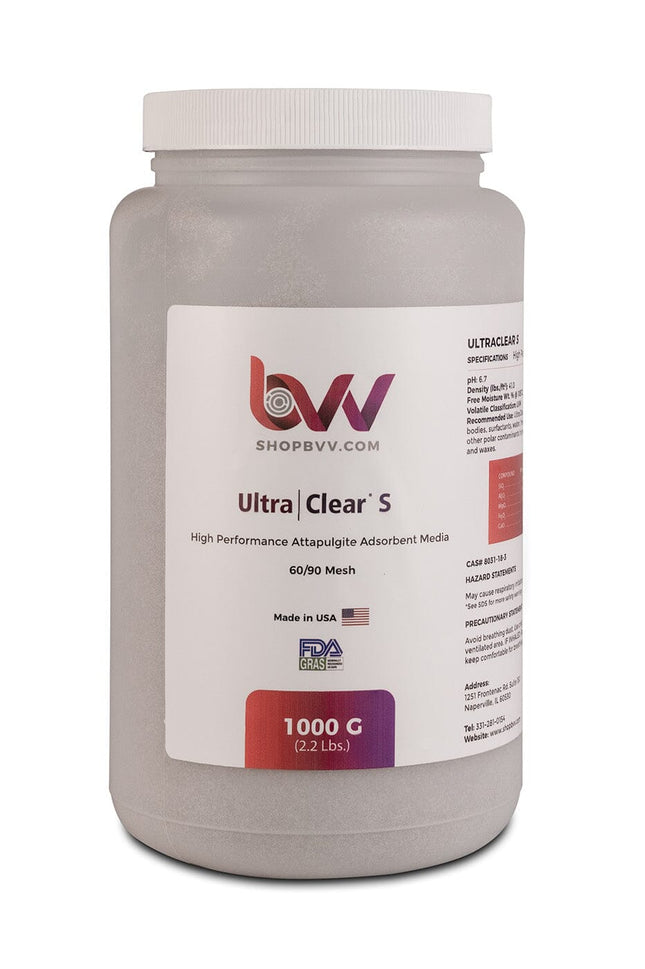
Ultra Clear S - Granular High Performance Bentonite for Bleaching & Decolorizing Edible Oils
Ultra:Clear® S 60/90 Mesh Made in USA, Food Grade Certified Ultra-Clear® S effectively removes color bodies, surfactants, water, free fatty acids, organic oxides, and other polar contaminants from a wide range of oils, liquids, and waxes. It is the Smallest particle size in the Ultra-Clear product line. UltraClear® S is a unique, naturally occurring attapulgite that has been thermally processed to provide hard, durable granules that won’t swell or breakdown in the presence of water. All Ultra-Clear products are classified as processing aids andhave Generally Recognized As Safe (GRAS) status from theFood and Drug Administration (FDA). At BVV™ we recommend 100g per lb. of biomass. We also use this media with layering techniques & can be used with BVV™ Silica Gel and BVV™ Neutral Activated Alumina for a sugar in the oven finish! Ultra-Clear® is manufactured in 4 granule sizes, 8/16, 16/30, 30/60 & 60/90 mesh sizes. Ultra-Clear® S is the smallest particle size and will offer the greatest surface area while remaining a High-Flow media for your extraction. See the technical data sheet for more information from the manufacturer. Ultra:Clear® S Food Grade Certificate Ultra:Clear® S Technical Data Sheet Ultra:Clear® S Safety Data Sheet
$13.00 - $2,100.00
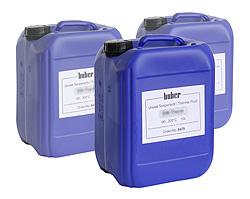
Huber DW-Therm M90.200.02, Heat transfer fluid -90 to 170 °
Huber DW-Therm M90.200.02, Heat transfer fluid -90 to 170 ° DW-Therm is a mixture of isomeric triethoxysilanes and has been developed for hydraulically sealed systems. We recommend the heat transfer fluid DW-Therm for Unistats. DWTherm has a high specific heat capacity and so contributes towards an optimum heat transfer. In addition, DW-Therm covers a large temperature range, and has an impressively long service life. Advantages: Valid only for Unistats Size 10L Broad working range from -90 °C to 200 °C (hydraulically sealed systems) excellent thermooxidative stability at high temperatures Low viscosity at low temperatures Low volatility and pleasant odour Easy handling (no creeping like silicone oils) Good compatibility with silicone oils Insolubile in water and good environmental compability Safety Data Sheet Properties Working temperature °C -90 to 200 Flash Point °C 101 Fire Point °C 112 Viscosity mm2/s (kinematic at 25 °C) 2 Density g/cm3 (at 20 °C) 0,879 Pour Point °C -137 Ignition temperature °C 265 Colour yellowish, clear Thermal expansion coefficient 10-5/K 96,98 Heat conductivity W/(m·K) at 25 °C 0,116 Material incompatibility copper, aluminum,non-ferrous metals
$1,960.00
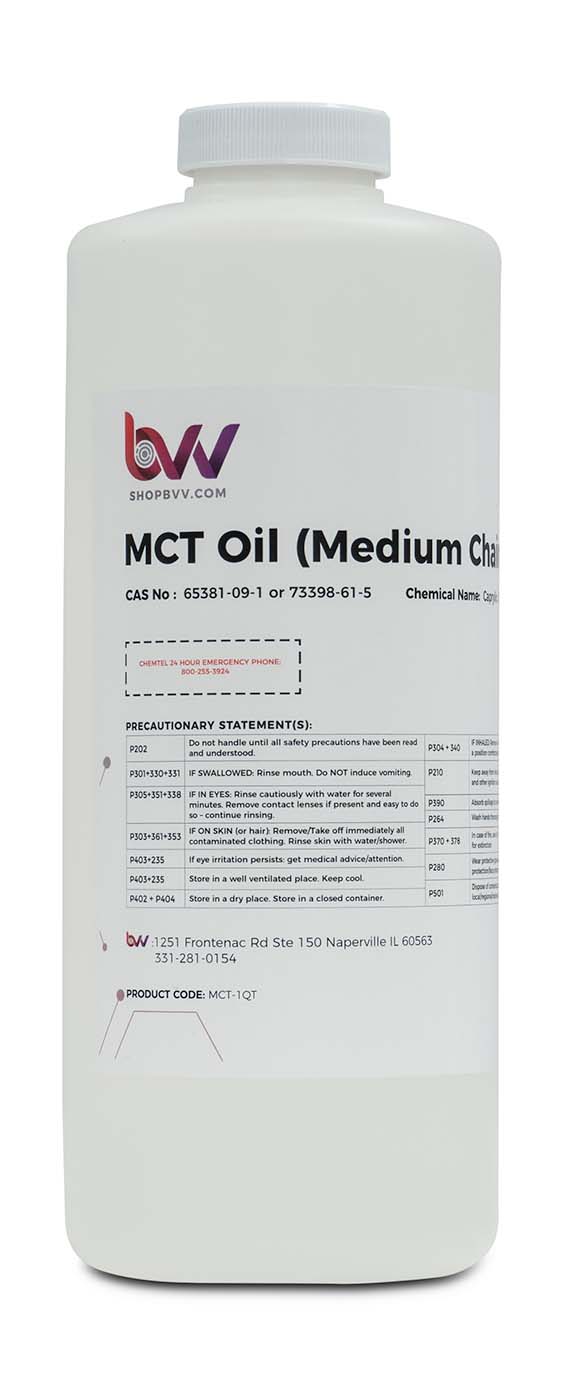
BVV C8/C10 MCT Oil Derived Only From Coconuts (Food Grade)
BVV C8/C10 MCT Oil Derived only from coconuts (Food Grade) 60/40 - 60%C8 / 40%C10 Soy Free, Non-GMO, Gluten Free, Dye Free, Dairy Free/Vegan Medium Chain Triglycerides (MCT’s) are fats that are naturally found in coconut and palm kernel oil. MCT’s are more easily and rapidly digested than other types of fats, as they require lower amounts of enzymes and bile acids for intestinal absorption. MCT’s are metabolized very quickly in the liver and are reported to encourage energy expenditure, and not fat storage. Numerous studies suggest that substituting MCT Oil for other fats in a healthy diet may therefore help to support healthy weight and body composition.* Suggested Usage As a dietary supplement, take 1 tablespoon (15 mL) 1 to 3 times daily. MCT Oil can also be used as a substitute for conventional oils in salad dressings, sauces or cooking as a source of beneficial fatty acids. Not recommended for use in frying due to low boiling point Caution: For adults only. MCT Oil may cause GI upset. To reduce these effects, take with food. Consult physician if pregnant/nursing, taking medication, or have a medical condition. Keep out of reach of children. Storage Guidance: Store in a cool, dry and dark environment in a tightly sealed original container. After opening, product can be refrigerated or stored at cool room temperature. Please note*** These statements have not been evaluated by the Food and Drug Administration. This product is not intended to diagnose, treat, cure or prevent any disease. BVV MCT Oil - COA BVV MCT Oil - SDS
$19.00 - $2,900.00
You have seen 96 out of 176 products

